

SPIRIT OF THE PAGE
From Esther Freud to Elizabeth Day



SPIRIT OF THE PAGE
From Esther Freud to Elizabeth Day
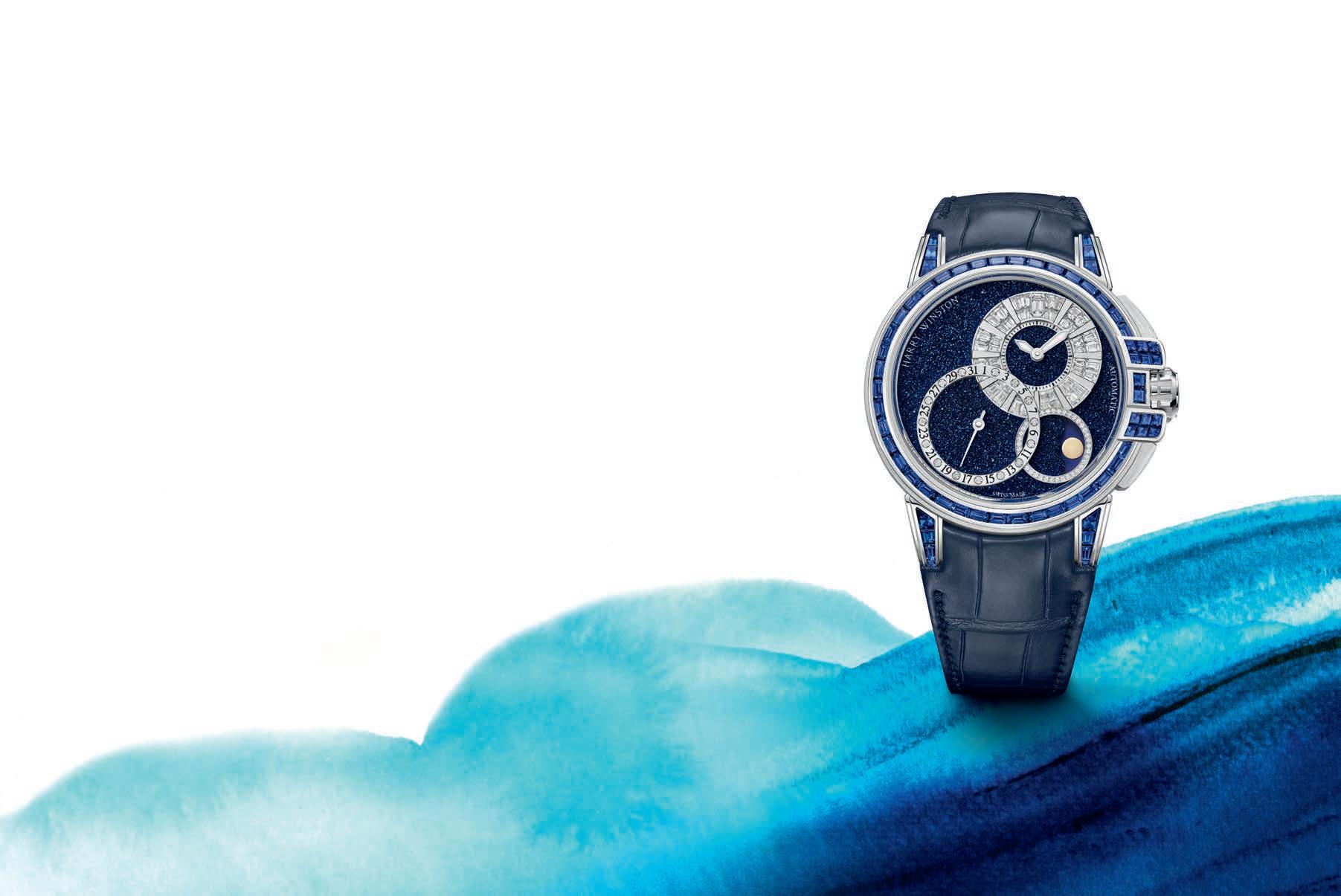



In celebration of 25 years of Raindance
A Family Story Since 1798



22 THE GOOD LIFE Alice B-B on resilience lessons and rallies with Maria Sharapova
24 THE RURBANIST Dame Zandra Rhodes
168 LAST WORD Michael Hayman visits a Georgian masterpiece brought back to life by its community
27
WARRIOR QUEEN Earrings inspired by lost Nubian queens
28 THE STYLIST There’s no need to splash around in synthetic swimwear
29 THE MAGPIE All that glitters
30 THE EDIT Fashion, beauty and jewellery news
32 ROLL ON SUMMER Shane C. Kurup selects seasonal must-haves for stylish men
35 NAKED AMBITION Ocean-kind skincare
36 IF LOOKS COULD FILL Alexander Johnston on the best refillable beauty brands
38 BODY LANGUAGE How to hack a bad hair day
39 CLEAN BEAUTY QUEENS Your glow-up needn’t come at the Earth’s expense
40 BODY & SOUL Is wearable tech worth it?
41 RE-SET THE AGENDA Inside the Bvlgari Hotel London’s latest spa rituals
43 BETWEEN SISTERS Belinda Bamber talks family with Esther Freud as she releases her longawaited sequel to Hideous Kinky
46 WHAT’S ON What to book now
47 BIBLIOFILE Author Jackie Thomas-Kennedy
48 THE GREEN LANE The new Maserati GranTurismo Folgore is lightning quick
49 THE EXHIBITIONIST Ed Vaizey planted the seed for the gamechanging V&A East Storehouse
50 ARTIST’S STUDIO Figurative artist Luc Tuymans
52 BRIGHT SPARKS Showcasing the trailblazers from the Central Saint Martins class of 2025
54 SCARFES BAR Charlotte Metcalf meets Rachel Kelly, the mental health expert questioning how parents model perfectionism
57 SMALL ACTS Inspo from We Feed The UK
60 FULL CIRCLE Ifeoluwa Adedeji on innovations switching up the way we care for the planet
64 THE GREEN STANDARD Winners of The Country & Town House x Polestar Sustainable Hotel of the Year Award 2025
71 THE POSITIVE DISRUPTOR James Wallace begs our youth to ditch screens and save the world
72 LITTLE GREEN BOOK Lisa Grainger meets Sarah Angold who swapped celebrity styling to create a cotton alternative
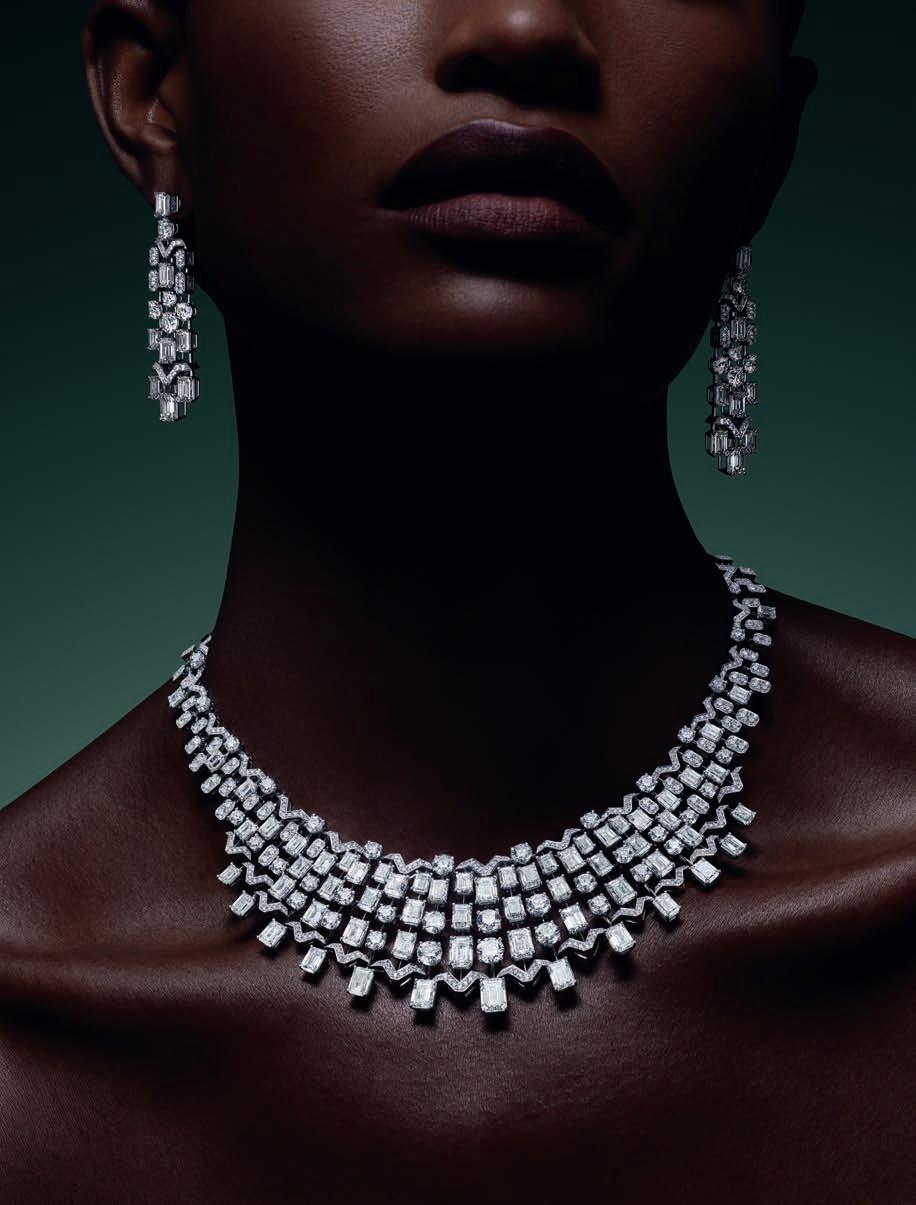


74 TRIP THE LIGHT Capturing haute couture
82 ON LOCATION Behind the scenes of our cover shoot on the rooftops of Bvlgari Hotel Paris
84 REBEL WITH A CAUSE Ti anie Darke on how Amy Powney and her new brand AKYN are tearing up the fashion playbook
88 DAY OF RECKONING Elizabeth Day shares the secret to happiness with Lucinda Baring
90 VIOLET’S MANORS How Violet Manners is reinventing heritage tourism. By Skylar Pinchal
95 SILK ROAD SLIPPERS Can a heavyweight masterclass in Morocco nurture a novel from Lucy Cleland
98 LUCK BE A LADY Lisa Armstrong explores the success of the iconic Lady Dior quilted bag
105 FULL MARKS Carole Annett sneaks inside a Chelsea schoolhouse turned kaleidoscopic art- lled home
108 DESIGN NOTES New season interiors picks
110 MY EXTERIOR LIFE Landscape architect Marian Boswall on bounteous biodiverse gardens
113 Daisy Finer spotlights the best spas in Europe intermixing serious diagnostics, progressive detox techniques and holistic healing
131 AROUND THE WORLD IN 3,576 DAYS How or Pedersen crossed every country on earth without ying. By Katie Scott
143 THREE BAGS FULL Francisca Kellett enjoys a new breed of travel experience
144 FORGED IN FIRE Hannah Begbie charts the history of a friendship in six holidays
146 REEF ENCOUNTERS Marine revolution in the Mayan Riviera moves Luke Abrahams
150 THE ESCAPIST Travel news
150 RIGHT TO ROAM Rebecca Cox on the people pioneering safer travel for the queer community
154 THE WILDIST Fee Drummond takes her daughters riding in the Umbrian folds of Reschio
157 THE SEA, THE SEA We can build a sustainable future on our shores, says Jenny Je eries
160 DISH THE DIRT Tessa Dunthorne probes the regenerative farming buzz
14 EDITOR’S LETTER 18 CONTRIBUTORS












Rusing it as a material) is Amy Powney. She’s just launched AKYN, which has to be one of the most regenerative fashion brands of our times. Powney’s zeal and singlemindedness in her mission to make fashion a force for good stems from an extraordinary childhood (like so many great founder stories). Other fashion brands should take note; we need more pioneers like Powney (p84).
Our great British houses cannot remain static entities if they are to survive. ey need to be alive, lled with people, to move with the times as well as remain beacons of history. is was what occurred to Violet Manners, who happened to grow up in one such house –Belvoir Castle – watching her parents strain every sinew to keep it going. Her new enterprise, HeritageXplore, sees her pull together a digital platform for so many of our great houses that can now be more easily discovered by curious visitors. She’ll even whip up a hosted tour of some, where you get to hang out with the custodians who live there. Skylar Pinchal jumped in a Polestar and went along for the ride (p90).

egeneration comes in many forms – and has replaced sustainability as a buzzword.
But like it’s predecessor, it’s hard to pinpoint exactly what it means, as it’s a term open to interpretation and can feel a little bit woolly. At its loosest we interpret it as an approach that goes beyond simply reducing harm or maintaining the status quo (i.e. ‘sustaining’) to something that actively restores, renews, or revitalises – be it the soil, your skin, your community, your mind even. So this issue is our ‘regeneration issue’ – and we’re taking the term as far as possible.
One woman who’d never be woolly about anything (apart from


Regenerating ourselves is the theme of this year’s Wellbeing Special, edited by Daisy Finer. She and her troupe of spa experts have visited some of the most cutting-edge and iconic spas in Europe to deliver our curation of the best programmes out there. Whether it’s brain health, sleep disorders or hormone rebalancing – these places – some brand new like Bu Medical and Zem, others tried and tested like Original Mayr and Chenot Palace Weggis – deliver, not just in terms of medical expertise but giving you the tools to bring what you’ve learnt into everyday life (from p113).
Learning is critical to keep our little grey cells turning over. I took myself o to Marrakech for a ve-day Literary Masterclass, run by the formidable Alexandra Pringle (former editor-inchief at Bloomsbury). Alan Hollinghurst dropped in to take one of the sessions, so you can see this was no ordinary course. I was stretched in ways I hadn’t been for so long and reawakened a dormant literary muscle memory which was a total thrill (p95).
Elizabeth Day (who we interview on page 88) is, of course, a most celebrated writer and podcaster and has no need of such a workshop. You’ll catch her live at the inaugural Chelsea Arts Festival (see below).
Whatever you’re doing this summer, we hope you can make time for some ‘regeneration’, however you choose to do it.




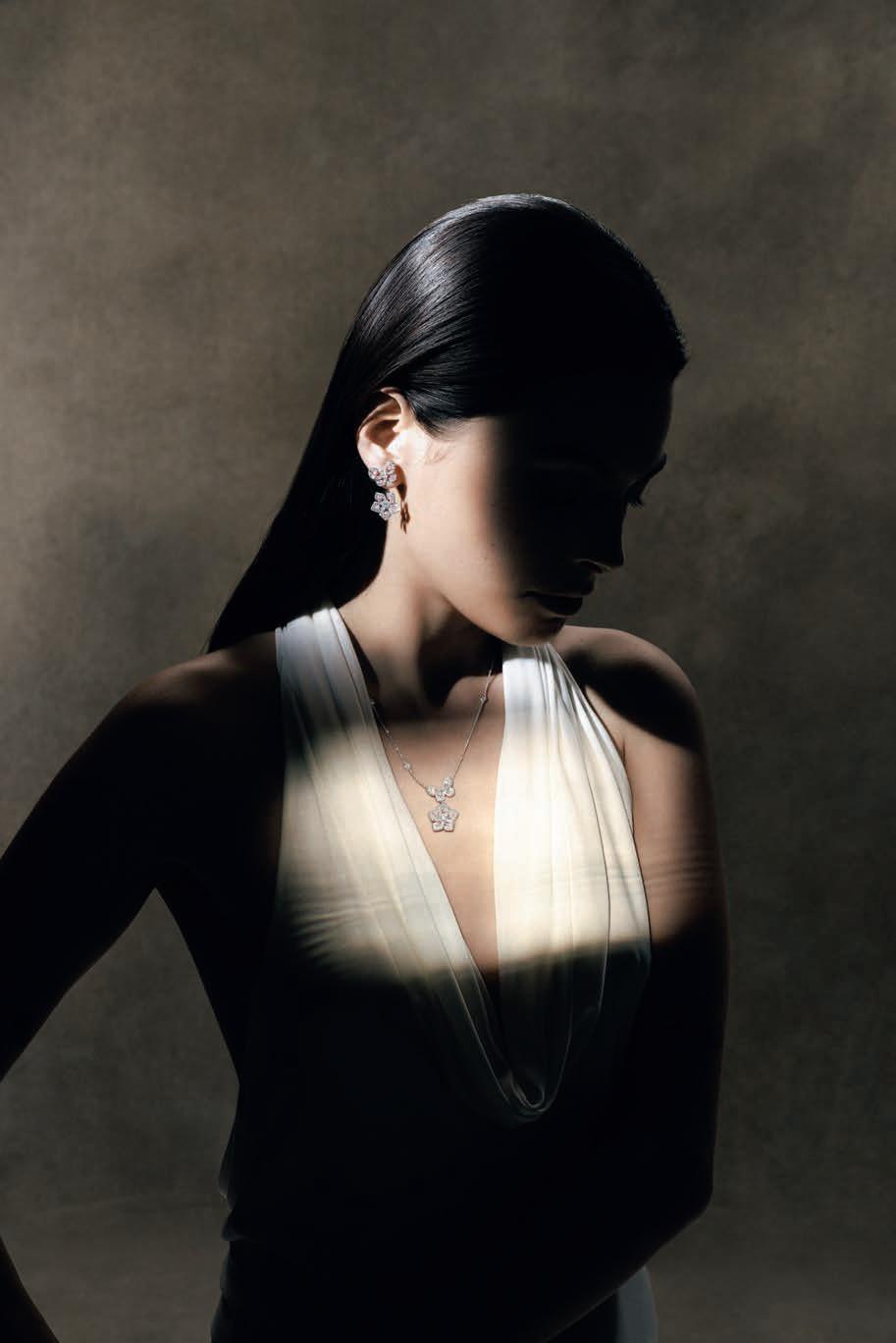








Best or worst festival experience? Wilderness 2019 for introducing me to a hot honey and pepperoni pizza. My favourite swimming spot is a secret cove near Rock in Cornwall.
My summer soundtrack includes remixes of 80s classics. My current favourite is the Echoes remix of Kate Bush’s This Woman’s Work.
I’ve booked tickets to see Inter Alia at the National Theatre this summer, starring Rosamund Pike. I love the idea of a Crown Court judge who sings karaoke. My greatest escape was to New Zealand, for its epic beauty and the kindness of its people. If I could go anywhere this summer it would be California, with my husband and two boys – for the beaches, wine and fun. The step I’ve taken towards regenerative living is to eat and cook seasonal food, and teach my kids to do the same.

My summer soundtrack includes anything from Paul Simon’s Graceland album. How can you not dance when someone’s singing about diamonds on the soles of their shoes?
I’ve booked tickets to Istanbul this summer, to meet with designers and hang out with local friends. This time I’m staying on the Asian side, which I find much more authentic. My greatest escape was to the Namibian desert for my honeymoon. It was like being on another planet. There’s no landscape more beautiful than a desert.
The step I’ve taken towards regenerative living is trying not to buy new things for my home. Our plates belonged to my husband’s grandparents; our side tables were bought at auction or in thrift stores; and the happy-making things on our shelves came from our travels.
My favourite swimming spot is in a little-known bay off the Greek Peloponnese where you mainly find local fishing towns. My summer soundtrack includes a mix of French, Italian and British classics that no DJ would play at the same event. If I could go anywhere this summer it would be to Ibadan in Nigeria, where I was born. I’d go with my husband and children so they can learn more about their Nigerian heritage. My greatest escape was to a boutique hotel called Le Dune on Sardinia’s Costa Verde. I still remember my first taste of the funny looking fruit corbezzoli. The step I’ve taken towards regenerative living is renovating our house slowly and sustainably. I mainly shop secondhand when it comes to furniture. We need to redo the bathrooms and we will keep the existing marble top and vanity unit, possibly some floor tiles too.
Best or worst festival experience? I’m more harvest festival than Glasto. Big crowds are not my thing. I’ve booked tickets to Zurich this summer. We had a 24-hour stopover there last year on a train journey from Puglia to Amsterdam and against all our expectations, we loved it. If I could go anywhere this summer it would be the South West coast path with my husband and Mabel, my Havanese, and any friends who wanted to join us. We walk a week of it each year. We’ve still got about 550 miles to go. The step I’ve taken towards regenerative living is building an eco house and planting 3,000 trees. I don’t eat meat but I fly a huge amount for my job so I’ve got a lot of making up to do. And I like finding great sustainable clothing to feature on telegraph.co.uk, like British brand AKYN (see p84).

DEPUTY EDITOR LUCINDA BARING
EDITOR-AT-LARGE ALICE B-B
ASSOCIATE EDITOR CHARLOTTE METCALF
MANAGING EDITOR TESSA DUNTHORNE
SUB EDITORS KATIE BAMBER, ANDREW BRASSLEAY
JUNIOR SUB EDITOR & PRODUCTION ASSISTANT EVIE CALVER
FASHION DIRECTOR NICOLE SMALLWOOD
BEAUTY DIRECTOR NATHALIE ELENI
INTERIORS DIRECTOR CAROLE ANNETT
CULTURE EDITOR ED VAIZEY
WELLNESS EDITOR CAMILLA HEWITT
EXECUTIVE RETAIL EDITOR JULIET HERD
MEN’S STYLE EDITOR SHANE C. KURUP
TRAVEL EDITOR-AT-LARGE FRANCISCA KELLETT
EDITOR-AT-WILD FEE DRUMMOND
SUSTAINABILITY EDITOR LISA GRAINGER
PROPERTY EDITOR ANNA TYZACK
MOTORING EDITOR JEREMY TAYLOR
ONLINE CONTENT DIRECTOR REBECCA COX
DEPUTY ONLINE EDITOR ELLIE SMITH
ONLINE CULTURE EDITOR OLIVIA EMILY
ONLINE STYLE EDITOR CHARLIE COLVILLE
ONLINE WRITER MARTHA DAVIES
SOCIAL MEDIA MANAGER MCKENZIE MULLANY
CREATIVE & PRODUCTION DIRECTOR PARM BHAMRA DESIGN & PRODUCTION MIA BIAGIONI
THE EDITOR editorial@countryandtownhouse.co.uk FASHION fashion@countryandtownhouse.co.uk
ADVERTISING advertising@countryandtownhouse.co.uk
ASSOCIATE PUBLISHER ELLIE RIX
HEAD OF FASHION EMMA MARSH
HEAD OF BEAUTY BANDI MANZINI
SENIOR ACCOUNT DIRECTOR PANDORA LEWIS
ACCOUNT DIRECTOR SERENA KNIGHT
ACCOUNT MANAGER COSIMA WOODARD
DIGITAL BUSINESS DEVELOPMENT DIRECTOR JOEY GOLDSMITH
B CORP & PROJECTS MANAGER XA RODGER
MANAGING DIRECTOR, C&TH EVENTS LOUISE CLOSE
SENIOR EVENTS MANAGER, C&TH EVENTS JOSIE WILLIAMSON
MARKETING & PRODUCTION EXECUTIVE, C&TH EVENTS DOMINIC CHRISTIE
TECHNICAL DIRECTOR MARK PEARSON
CHIEF FINANCIAL OFFICER GARETH MORRIS
FINANCE CONTROLLER LAUREN DELGADO
FINANCE ADMINISTRATOR RIA HARRISON
ACTING FINANCE ADMINISTRATOR KLODI SADE
HUMAN RESOURCES CONSULTANT ZOE JONES
CHIEF COMMERCIAL OFFICER TIA GRAHAM
CHIEF OPERATING OFFICER JAMES THROWER
MANAGING DIRECTOR JEREMY ISAAC
CONTRIBUTING EDITORS
BELINDA BAMBER, STEPHEN BAYLEY, OLIVIA COLE, TIFFANIE DARKE, FIONA DUNCAN, OLIVIA FALCON, DAISY FINER, AVRIL GROOM, LAUREN HO, EMMA LOVE, MICHAEL HAYMAN, MARY LUSSIANA, CAROLINE PHILLIPS, JAMES WALLACE
PROPERTY ADVERTISING property@countryandtownhouse.co.uk
ACCOUNTS accounts@countryandtownhouse.co.uk
SUBSCRIPTIONS subscribe@countryandtownhouse.co.uk
COUNTRY & TOWN HOUSE is a bi-monthly magazine distributed to AB homes in Barnes, Battersea, Bayswater, Belgravia, Brook Green, Chelsea, Chiswick, Clapham, Coombe, Fulham, Hampstead, Holland Park, Kensington, Knightsbridge, Marylebone, Mayfair, Notting Hill, Pimlico, South Kensington, Wandsworth and Wimbledon, as well as being available from leading country and London estate agents. It is also on sale at selected WHSmith, Waitrose, Marks & Spencer and Sainsbury’s stores and independent newsagents nationwide. It has an estimated readership of 150,000. It is available on subscription in the UK for £39 per annum. To subscribe online, iPad, iPhone and Android all for only £9.99/month, visit: exacteditions.com/ read/countrytownhouse. For subscription enquiries, please call 020 7384 9011 or email subscribe@countryandtownhouse. co.uk. It is published by Country & Town House Ltd, Studio 2, Chelsea Gate Studios, 115 Harwood Road, London SW6 4QL (tel: 020 7384 9011). Registered number 576850 England and Wales. Printed in the UK by William Gibbons and Sons Ltd, West Midlands. Paper supplied by Gerald Judd. Distribution by Letterbox. Copyright © 2025 Country & Town House Ltd. All rights reserved. Reproduction in whole or in part without written permission is strictly prohibited. Materials are accepted on the understanding that no liability is incurred for safe custody. The publisher cannot be responsible for unsolicited material. All prices are correct at the time of going to press but are subject to change. While every care is taken to ensure information is correct at time of going to press, it is subject to change, and C&TH Ltd. takes no responsibility for omissions or errors



Ideally, we’d love you to pass it on to a friend or a community place which might enjoy it (doctor or dentist surgery, community centre etc), but you can also rest assured that your issue (including cover) can be disposed of in your paper waste recycling bin.





LE AST RESISTANCE… e path most of us are hardwired to take because our ancient limbic brains want to conserve energy and choose the familiar. Which is not great for success: when shit gets tough, the blasted wiring encourages us to give up. But resilience can be learnt at any old age, as former world number-one tennis player Maria Sharapova explains. One of only ten women ever to win all four grand slams, Sharapova has a new role as the Aman hotel group’s wellness ambassador, which includes hosting retreats like ‘Building Resilience’. I joined her at one of the world’s most beautiful hotels, Aman Zoe in Greece; so far, not a hardship. ‘Growing up, I was talented and a lot of people considered me a prodigy,’ Sharapova tells me. ‘But my strength was my mind. I was known for my toughness. at mentality helped me win, on and o the court.’ e retreat includes many of the tools Sharapova used for mind, body and spirit – both as athlete and now, to stay at the top of her game as a mum, businesswoman and entrepreneur. We do breath work, meditation, physical workouts (hiking through the Peloponnese, pilates, strength training). We eat clean, take gong baths and ice baths, and have massages. It’s super swanky, Aman style. But I watch as Sharapova always pushes herself –that extra press up, and patiently coaching tennis no-hopers like me. She puts her all into making the best experience for the Aman guests. ‘I want to be an example. ese are things I’ve applied in my life and I’ve seen results,’ says Sharapova. ‘So when I’m in a room with people and we’re at 30 seconds of a 40 second workout and they look over and see I’m still in it – if I can give them a 10 second push, it makes it all worthwhile.’ Lesson learnt: resilience… is consistently giving that 10 second push. (aman.com) SHIMMERING GOLDEN WINGS… that catch the light. I’m momentarily distracted by his beauty, and then I remember his lustrous lady could have laid up to 50 eggs, hatching to ravenous larvae ready to feast on my favourite cashmere. It’s moth season, an issue that has recently ratcheted to high-level courtroom drama when a property developer stu ed the cavities of a mega-fancy Notting Hill ga with wool insulation. Keratin (in natural bres) is caviar to moths. e new owners endured a biblical-level infestation, moths descending like a gilded snowstorm, and it was decreed the developer must buy back the £32.5m mansion. So for our new house I’ve discovered Anywhere Carpet made by Alternative Flooring. It’s chic like sisal, soft as a lamb’s tummy but made entirely from recycled plastic bottles, which makes it magni cently moth-resistant. ose glittering lepidopterans will have to nd a meal elsewhere. (alternative ooring.com) n


Zandra Rhodes



What’s bringing you joy at the moment? Colour and print. We need bright things when the world looks a bit grey.
What’s annoying you most right now? Too much black. I get on the Tube and everyone is in black. At my funeral, celebrate me going in glorious colour. Advice you’d give to your 15-year-old self? Attack everything with complete enthusiasm and never give up. My mother was very exotic and wore make-up that embarrassed me as a child, but I’m very proud now that she encouraged me to be who I was.
What keeps you awake at night? inking I might run out of ideas. What could you have been arrested for? e question is what have I been arrested for? In 1986 I got caught growing grass in the windows of my Notting Hill house. I used to harvest it, but the police got the last one. Every time I need to renew my US visa I have to get a police report to say I’m clean. Best life hack? Write everything down.
A moment that changed everything? Going to New York in 1969 to show my collection to Diana Vreeland at Vogue. I was 30 and had only been to France and Austria before, so New York felt very glamorous. I wore my high white Biba boots and my hair in a headscarf. Diana ran it over four pages on the actress Natalie Wood and from there I sold to Henri Bendel.
Where do you go to escape? Museums and galleries – the V&A or the Sculpture Court at the Met. You always see something in a corner you haven’t noticed before. e best is being in a museum when it is closed to the public and you can just wander.
What’s the best way to put a smile on your face? Re-dye my hair and do my make-up. I’ve had pink hair – let’s call it cyclamen – since 1980. I once dyed it black for a conservative boyfriend; it was so boring I dyed it back immediately. You wouldn’t know it but... I have a very small tattoo of a lily on my upper thigh. I had it done in the 1970s in LA. e lily is a great design trope for me – so you could say I branded myself. I have no regrets.
What does sustainability mean to you? High quality design that lasts. We can’t a ord to waste the world’s resources. We have to consider what we have, and move away from changing things all the time – whether that’s in our homes or what we wear. How can we save the world? I’m old. All I can do is become compost. We need to educate and empower the youth of today to treasure and preserve what we have left.
Your greatest failure? I don’t admit to failure. If the dress doesn’t work, cut the skirt o and change the sleeves.
Your greatest triumph? Founding the Fashion and Textile Museum. It was very challenging and only happened by a wing and a prayer. I saw the building; thought I’d get a grant and didn’t; lived in squalor. Its legacy is to show what British designers achieve. We are a very creative nation.
Your epitaph would read... Good, better, best. Never let it rest, ’til your good is better, and better, best. What does a life in balance mean to you? I wouldn’t know. I do hold dinner parties for my friends every weekend. I cook – nearly always the same thing. ey get soup, probably poached salmon, and apple crumble or tri e. I get my energy from friends
Dame Zandra Rhodes will be live at Chelsea Arts Festival on 20 September. chelseartsfestival.com n SCENT Patchouli. SONG Lately anything from The Rocky Horror Picture Show. BOX SET The Archers. CHOCOLATE Mars Bar. DISH Apple crumble. GADGET Electric mixer. RESTAURANT The Wolseley. HOLIDAY India, to






Maison de parfums d’intérieur eu.baobabcollection.com







These Art Deco-style earrings from Matturi, a fine jewellery brand inspired by the traditions of the African continent, pay tribute to the bold queens of the lost Nubian kingdom of Kush and symbolise protection, royal power and good health. With provenance at the heart of its collections, Matturi crafts each piece in limited quantities using Single Mine Origin gold and responsibly sourced precious stones, while supporting artisanal, women-owned mines is a key focus. Nomoli Totem Spiky earrings in 18k yellow gold, natural diamonds and onyx, £POA. matturi.com
Springsuit
merino
Tiffanie
Darke calls time on synthetic swimwear that is bad for your health and the ocean around you, but there some seaworthy alternatives


Gl obal health warning: summer is here and it’s not just sunscreen you need to worry about. Microplastics, tiny micro bres which are shed from synthetic clothing by friction and washing, are now so prevalent they can be found everywhere from the Arctic ice sheet to your mother’s placenta. Health concerns are mounting: evidence linking microplastics to liver damage, cancer and reproductive issues is stacking up. While you can avoid synthetics in most aspects of your wardrobe, with swimwear it’s almost impossible. Consider also that swimwear is worn right next to the thinnest parts of your skin: Neoprene, elastane, Lycra, polyester, Spandex – all plastic. Just bought a ‘sustainable’ swimsuit? Forget it: nine out of ten ‘sustainable’ swimsuits will simply be made from recycled plastic.



Leading the market for alternatives is a fabric from Pyratex, which uses blends of Oeko-tex certi ed polyamide, biodegradable elastane and Tencel lyocell. Away at Day uses it for its hit Cannes range, and it’s just as quick-drying and antibacterial as its plastic counterparts. It’s also much more breathable, meaning it can double as daywear. For that, also head to Finnish brand Andiata: its leotard-like suit looks great with jeans. Full marks for ‘less is more’ wardrobe exibility. Wool, the wonder fabric, also works for swimwear. New weaving technology can produce a super light fabric, which Vilebrequin is embracing in its 100 percent merino swim shorts (such a pity they added a polyamide mesh lining). Girls can head to Arena for a pioneering bikini and swimsuit range in 50 percent merino wool.
B Corps Wallien and Finisterre o er swimsuits and wetsuits in Yulex, a natural rubber alternative to Neoprene. e light Yulex Wallien swimsuit is my go-to for cold water swimming, but be aware the natural rubber lling is sandwiched between plastic liners. Both Wallien and Stay Wild Swim encourage shoppers to buy a Guppy bag with every purchase: machine washing your swimsuit in this bag stops micro bres leaching out into the system. For surfers who like being bu eted in wild seas, take founder Madeleine Wallien’s advice: ‘It’s crucial that materials neither pill nor degrade in chlorine or salt water, and for that you need quality. We source all our fabrics from an Italian mill: they deliver best-in-class performance and longevity.’ ere’s one other option of course. You can always go naked. n

When the Boodles family go on holiday together, they come back with more than memories –and their latest collection, A Family Journey: Around Africa in 10 Days is an ode to the continent’s beauty. Masai Mara necklace, set with an emerald cut re opal in 18ct Single Mine Origin yellow gold, £POA. boodles.com
Inspired by traditional Botswanan basket weaving and the country’s corkscrew-horned kudu antelopes, these 18k gold vermeil and enamel rings are part of a charitable collab with the Ngamiland Basket Weavers Trust. Mokola Kudu rings with responsibly sourced stones, $395. beabondworld.com

Recycled leather and gold drive new-wave designs, says Juliet Herd
Seahorse brooch in 18k yellow gold and platinum with blue zircons, moonstones, diamonds and sapphires, £POA. ti any.com

ese Rock Sugar Stick earrings by newly appointed Fairmined ambassador, Tejen, are too sweet to resist. 18k Fairmined yellow gold and diamond earrings, $15,200. tejen-collection.com


At the fore of a new wave of eco-driven designers, LÖF founder and former songwriter Morgan Mackintosh crafts each of her pieces using 100 percent recycled gold and responsibly sourced gemstones. Marionette earrings, £17,195. lo ewellery.com







e bolder the better is the mantra of Maria Sole Ferragamo, whose ingenious pieces are made from leather o cuts and metal shavings. We’re feeling empowered by the Halo gold foil necklace, £450, modelled by Maria’s sister Martina. so-le-studio.com
You’ll feel as good as you look in these conscious luxury labels, says Juliet Herd


thefoldlondon.com
‘Winning this award is a dream come true,’ trailblazing designer Patrick McDowell tells C&TH after receiving this year’s Queen Elizabeth II Award for British Design in recognition of his commitment to sustainable practices. e former Central Saint Martins graduate, who launched his conscious luxury label in 2018 and whose made-to-order SS25 collection is inspired by British painter Glyn Philpot, bonded with the Princess of Wales over their shared passion for craftsmanship as she presented him with the award. patrickmcdowell.co.uk

At digi-department store Lovebrook & Green, brands must be either certi ed B Corp, bear the Positive Luxury Butter y Mark or score highly on L&G’s integrity-based methodology. A more intentional way to shop. Millais Zest bag, Been London, £225. lovebrookandgreen.com

To mark its 250th anniversary, Breguet has launched the Tradition 7035, featuring a handmade enamel dial in its signature blue. With a 38mm diameter Breguet gold case, it’s a beautiful unisex gift. Tradition Seconde Rétrograde 7035, £43,600. breguet.com
CAMILLA ELPHICK
Ivy leopard ballet flats, £295. camillaelphick.com

DEAR FRANCES
Balla Mesh flats in blue, £370. uk.dearfrances.com


RUSSELL & BROMLEY
Butterfield super ruched ballerinas with strap, £195. russellandbromley.co.uk

ALOHAS
Sway leather ballet flats in vanilla, £150. alohas.com

Pippa Small’s new collection supports a women’s group in Colombia’s Chocó jungle region, who practice small-scale mining with zero pollution, allowing gold to be found for future generations. Colombian Gold Filigree Heart Leaf pendant on cord in 18k gold £2,780. pippasmall.com
Made from traceable natural rubber and featuring a Japanese Shibori-inspired tie-dye print, this might well be the sporty swimsuit of the season. Available in sizes six to 22, it o ers extra warmth and impressive support. Ideal for wild dips. Iris 1.2mm Yulex swimsuit, £105. nisterre.com


MALONE SOULIERS
Sabina black lace pumps, £585. malonesouliers.com

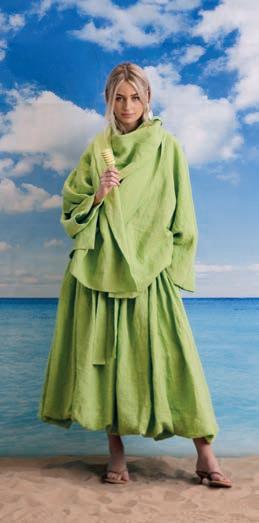

POCKET ROCKET
N°1 De Chanel Serum-in-Mist, combining naturally derived red camellia extract with an on-the-go mist format, is your new handbag essential. Spritz on demand. Serum-in-Mist, £94. chanel.com
Blanket, shawl, loose- tting jacket… We’re counting the ways you can wear this modern take on a traditional Irish brat (pronounced brawt) or cloak. Crafted in pure Irish linen and complete with oversized wrap scarf, it’s our seasonal transition piece of choice. e Irish Brat (short), £460. kindredo reland.com
Shane C. Kurup curates the style must-haves for summer 2025
In a particularly memorable episode of cult 1990s sitcom Friends, Phoebe changes her name to ‘Princess Consuela Banana-Hammock’ after learning she can legally call herself anything she wants. Her new husband later informs her that a banana hammock is a Speedo, much to her chagrin. is deriding of the male smalls of swimwear (aka budgie smugglers) may have been the norm in the era of the bloomer-like board short noughties – but fashion, being a cyclical beast, has a habit of bringing back what was once relegated to the style wastelands. e skimpy swimmers that populated pool sides in the 1970s are once again making a big splash. ‘ ey are being reclaimed as a stylish, modern choice by men who are comfortable in their own skin and are looking for something elevated, tailored and intentional,’ explains Sourena Gha ari, founder of Abtany. ‘ e latest D&G campaign featuring Brit actor eo James is proof that swim briefs are o cially back.’


Gha ari is not alone in this assessment. ‘ e budgie’s return isn’t coincidence. It’s nostalgic rebellion,’ says Andreas Palm, co-founder of Stockholm-based CDLP. ‘For decades, men’s swimwear has been stuck in a loop of oversized board shorts and generic prints. But there’s a new generation of men who care about design and aren’t afraid to make a statement.’
Actor Luke Evans is also an advocate, and the brand he co-founded, BDXY, makes its sunga swim briefs from ECONYL®, a fabric generated from ocean plastics. ‘Swim briefs are versatile and –contrary to popular belief – complement most men. Plus,




they are ridiculously comfortable,’ explains Evans. Abtany prizes updated cuts and also o ers co-ordinated swim shorts to layer over your briefs, should you suddenly feel shy when rocking up at the pool bar. ‘Our briefs are designed to be attering – tailored but never too tight, with a sleek waistband and clean lines,’ says Gha ari. If you don’t quite have the chutzpah to go the full monty but want to bring those tan lines up a touch higher, some box-cut briefs o ering a bit more coverage might be the way to go. And while good grooming and putting in the legwork at the gym is probably wise, the key to pulling it o is brass. ‘ e look works when you wear it like you mean it. In the end, it’s about attitude,’ says Palm. So go on – man up and pull on a pair.
e often abysmal weather in Blighty means we keep our feet caged in a sunless moist cocoon for much of the year, which is why, when summer eventually rolls around, British men fear ashing their toe cleavage. But with the continued dressing down of traditional codes, the men’s sandal is striding ahead in a host of jazzy new designs. Even the way to wear them has shifted on its axis – socks with sandals, once mocked as the uniform of powerwalking German tourists, is actually a look now. But if the thought of whipping out your gnarled, pasty trotters lls you with dread, a sturdy clog mule (Loewe Ease Buckle mules in brushed suede, £825) has cool comfort in spades without scaring passersby. And perhaps consider giving your hardworking feet some love and get a pedicure.






Don’t forget these suitcase heroes to nail the holiday look





Given that Australia has won the metrological lottery, its designers know how to dress for the outdoorsy, sun-soaked life. COMMAS, which hails from Sydney, o ers collections of considered resortwear, which has the kind of hand-spun character that’s increasingly hard to nd now the world is one global shopping mall. is season’s uid silk ikat shirts, jacquard shorts and crochet-trimmed trousers say ‘cultured Bohemian traveller’ in a suitably exotic accent. From £116, commas.cc
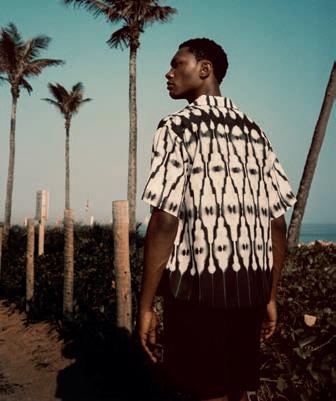

When packing for a hardearned summer sojourn, it’s tempting to just throw in your swimmers and smalls – but that’s not going to cut it if you’re o somewhere swanky. Contemporary tailoring house om Sweeney taps the exacting techniques of ne British tailoring with none of the starchiness. Its SS25 line of breezy linen shirts, easy slacks and silky deconstructed jackets make for light packing and will show your sartorial uency during sundowners. From £245, thomsweeney.com
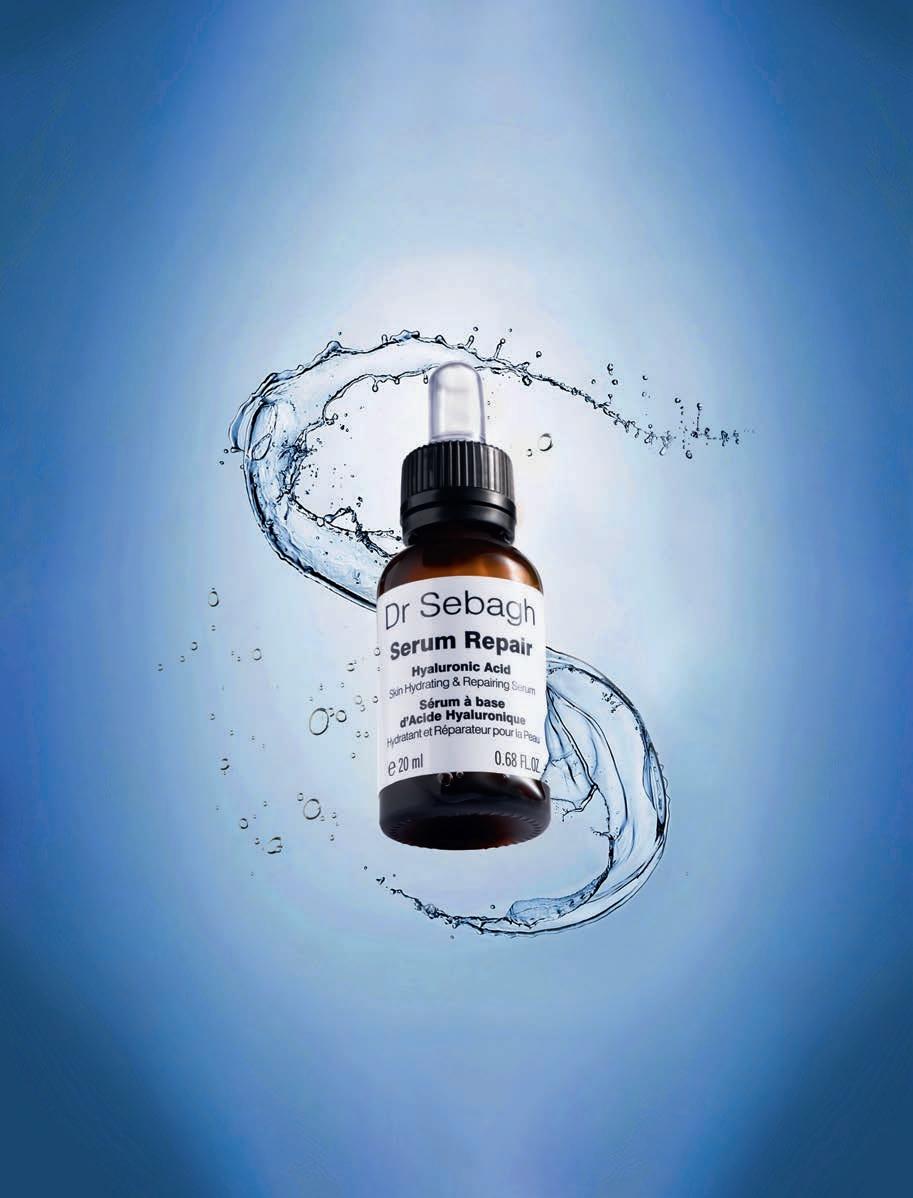
100% agree that skin is preserved
95% agree that skin is hydrated
81% agree that skin is plumped
*Clinical trial conducted by SGS, 10.2022
100% AGREE SKIN IS REPAIRED*
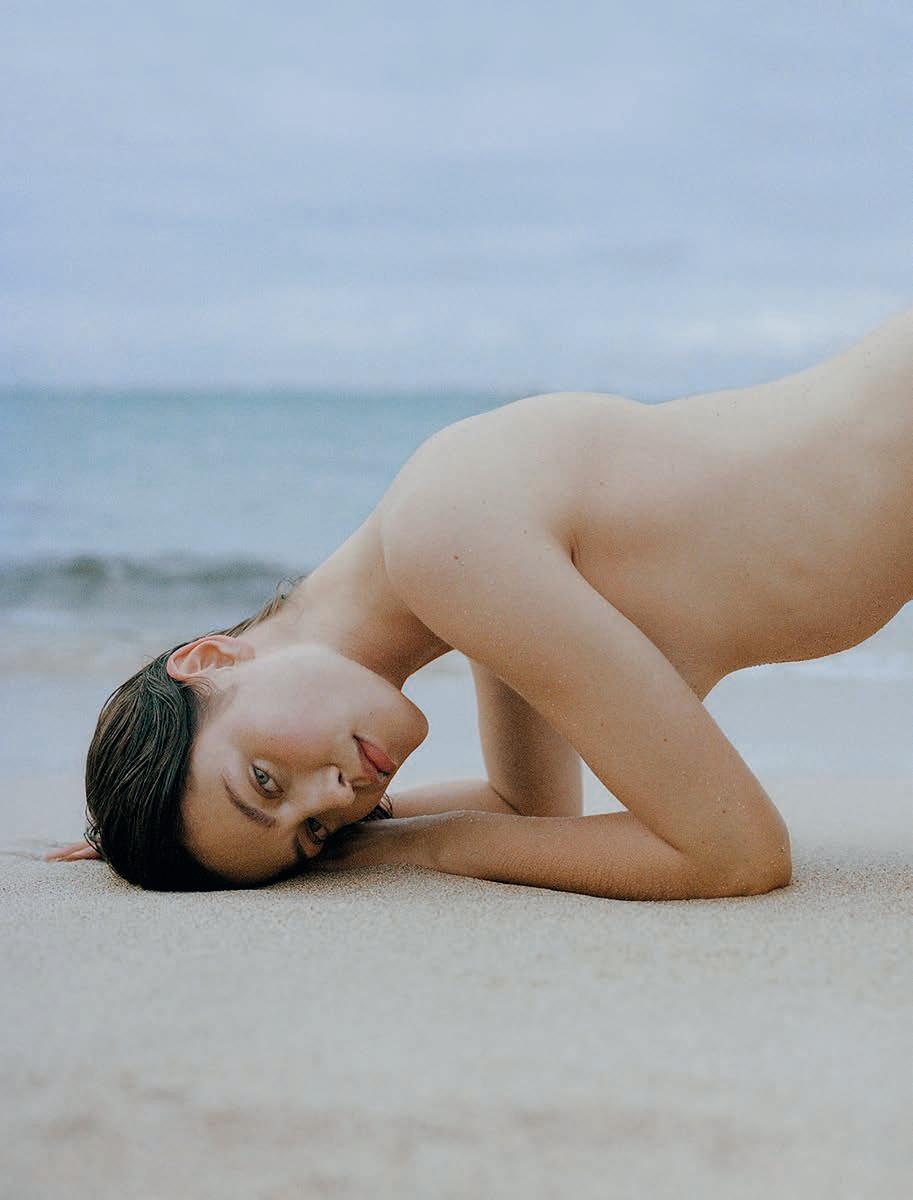
Ocean-derived skincare company Gezeiten has ripped up the playbook with its serums and creams. Instead of continuously harvesting its marine ingredients, the brand has partnered with pioneering marine biotech companies on the French Atlantic coast to cultivate biobanks. From single samples of marine microorganisms and algae, it is able to create sustainable cultures that also remain free from pollutants and other environmental contaminants. If Looks Could Fill, p36.

TFROM LEFT: Gezeiten intensive anti-aging face cream (£275 for 50ml; refill £250 for 50ml); Rollr deodorant (from £35 for 40ml; refill £25 for two); Noble Panacea The Elemental hydrating essence (£121 for 30 doses; refill £112 for 30 doses); Intuisse Active NAD+ Essential cream (£145 for 2x30ml; refill £135 for 2x30ml).
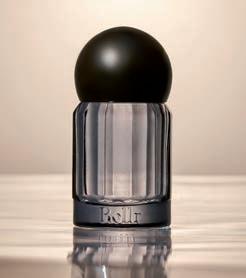
Is refi llable skincare a real step towards a sustainable future?
he beauty industry, by its very nature, relies heavily on packaging: from protective containers and applicators to secondary boxes and lea ets which are often quickly discarded. Amid this landscape of doubt, however, a genuinely positive movement is gaining traction: re llable skincare.
Beyond the obvious environmental bene ts, re llable skincare also tends to be more coste ective, rewarding sustainable choices with savings. And many brands are investing in innovative and luxurious re llable designs, elevating the aesthetic appeal of everyday skincare items on our bathroom shelves.
Of course, the journey towards true sustainability in the beauty industry is far from over. Challenges remain – such as ensuring re ll stations are hygienic or that re ll materials are genuinely recyclable or compostable – but there are some incredible beauty brands leading the way on this journey.
Noble Panacea is notable in this market: its luxurious and e cacious range of skincare products are provided in pre-measured, 100 percent recyclable pods that come in a beautiful and hardwearing vessel made from starch. e used pods can then be returned by post directly to the brand, which will recycle them on your behalf. An elegantly simple solution.


Swiss brand Intuisse is another great example of

a skincare brand breaking boundaries with both science and sustainability credentials. Not only is the NAD+ range a gamechanger for the industry, Intuisse launched its brand with sustainability at its core. Each product is sold with a multi-use applicator robust enough to survive years-worth of re lls, which are supplied in 100 percent recyclable, compostable and biodegradable cartons.
Gezeiten , a relative newcomer to the skincare world, has taken its sustainability credentials to the next level. By developing biotechnology that allows it to harvest its marine-sourced ingredients in a controlled environment, the brand minimises any impact on nature – while also o ering a re llable vessel for the day and night creams that are both striking and aligned to the principles of circular beauty.

But it isn’t just high-end skincare brands that are adopting the re llable approach. Rollr, a breakout deodorant brand from right here in the UK, has launched a re llable natural deodorant – and it actually works. e bottle itself is a beautiful glass creation equipped with a rollerball made from either medical grade stainless steel or gemstones, elevating an everyday product to a luxurious ritual.
Written
by
Alexander Johnston
of
John Bell
& Croyden. All products stocked at johnbellcroyden.co.uk n
The best reef-safe sunscreens are free from ingredients such as oxybenzone and octinoxate

RAAIE Lightweight, gently tinted and SPF50, offering broad spectrum protection (£85 for 45ml)

EUCERIN Perfect for those who dislike the sticky feel of some sunscreens. Special technology also minimises premature ageing and dark spots (£19 for 50ml)

KORRES This indulgent, creamy formula immediately melts into skin, leaving it beautifully hydrated and fully protected (£36 for 200ml)

NUXE
Elegantly fragranced and quickly absorbed, Nuxe’s patented complex also works to prevent premature photoaging (£24 for 50ml)











Olivia Falcon tackles a very bad hair day (…year) head on

Ageing hair. No one tells you much about this as you turn 50 but I can con rm it’s a thing.
I’ve been seriously limited with my hair lately – shedding to the point that, at time of writing, it is about half the thickness it was a couple of years ago (I have lost weight on Mounjaro weight loss injections and am moving into menopause, so these are the most likely culprits). I’ve also been experiencing a weird yaway-frizz situation that makes me look slightly mad.
My friend Elena Lavagni, owner of Neville (nevillehairandbeauty.net) who has the best hair and tips, advises to avoid layers at all costs (they make hair look thinner) and to go for a blunt cut, which I have done (along with Neville’s microdermabrasion for the scalp, £70, an enzymatic pepperminty cream that’s massaged into the scalp to remove build up of old cells and encourage new hair growth).
I’ve also recently discovered Rehab Hair Tamer (£20, rehabyourhair.com), a mascaralike gel that nixes frizz without making hair look wet, which has been a godsend. I’ve ordered three. If you have cow-licks or unwanted wisps this is your new best friend.
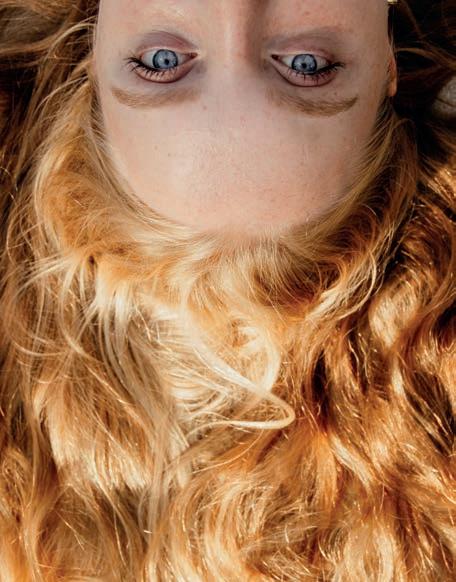

My other new BFF is hair stylist Tom Smith (tomsmithhd.com). One of London’s top hair gurus, you can nd him at e Billi Currie salon on Chiltern Street, where he o ers his signature Atomic Method (from £3,000, billicurrie.com), a smart layering of regenerative hair technologies that delivers instant results to transform frazzled hair.
After a thorough hair and scalp assessment and consult, Smith gets to work with a clarifying Olaplex treatment that contains chelating agents,

Targeting nine kinds of wrinkles – from forehead and frown lines to crow’s feet and neck wrinkles – there are some big claims here, but scientific data shows this serum reduces fine lines by 20 percent in eight weeks. Allies of Skin Multi Peptides & GF Advanced Lifting Serum, £176. uk.allies.shop
which work to reduce the build-up of heavy metals found in London water. I instantly sense a new silkiness. is is followed by a deliciously scented hair primer, painted on to infuse moisture, shine and cut through the frizz.
As shedding has been my real issue, Smith applies Calecim Professional Advanced Hair System – rst dermastamping my scalp to create little microchannels before rubbing in a patented serum containing thousands of exosomes, proteins and stem cells that work to stimulate hair growth, activating dormant hair follicles that shut o with age and thickening existing hair shafts. I was also given an at-home kit to repeat the treatment on a weekly cycle for a six-week period at home.
Next an LED light helmet was lowered over my head to calm scalp in ammation and increase cellular activity, before Smith gave me a cut and the bounciest blow dry I’ve had in about 20 years. is treatment is undoubtedly a real investment but when you’re spending thousands on tweakments for your face, you probably want big bouncy hair to turn heads. n

2
A carbon neutral range championing natural minerals and muds. This innovative mask offers a facial-like experience at home, as it triples up as a cleanser, exfoliator and face mask. A desert island pick. Plenaire Tripler 3-in-1 Exfoliating Clay, £30. plenaire.co

3
Pleasantly pink, this one gently exfoliates dead skin cells, reducing clogged pores, keratosis pilaris (that bumpy skin on the backs of arms) and ingrown hairs with a trio of acids: mandelic and lactobionic acid to exfoliate, and hyaluronic acid to deeply hydrate and improve skin elasticity. MANTLE The Miracle Fluid, £49. mantleskin.com

Dr Zein Obagi is the grand high wizard of zapping zits. This genius gel is clinically proven to clear breakouts, prevent blemishes and improve hyper pigmentation with a retinol emulsion that won’t dry out skin. ZO Skin Health Retinol + Blemish Complex, £131. zo-skinhealth.co.uk
British-born brands are making it easier, and more stylish, to glow responsibly says Nathalie Eleni

Sustainable beauty is not just a buzzword – it’s a vital shift in how we consume and care for ourselves and the planet. e cosmetics industry produces over 120 billion units of packaging every year, most of which ends up in land ll or contaminating our oceans. By choosing sustainable beauty, you’re helping to reduce plastic waste, support cruelty-free and ethical practices, protect marine life, and favour cleaner, non-toxic ingredients. Your glow-up doesn’t have to come at the Earth’s expense.



Does sustainable or natural mean it’s not as effective? Sustainable products are actually better for you. Unlike conventional formulations (often loaded with llers, microplastics or hormonedisrupting chemicals), sustainable brands focus on purity and performance. Many natural ingredients are potent skincare heroes, backed by both ancient traditions and modern science. Today’s most rejuvenating discoveries include vitamin C extracted from Kakadu plum (one of the richest sources in the world), natural retinol alternatives like bakuchiol, and deeply healing botanical oils such as rosehip and tamanu.
How can I start implementing sustainable beauty? Use what you already have: the most sustainable product is the one you don’t throw away. en begin swapping in smarter options: re llable and reusable packaging, shampoo bars, solid cleansers, and waste-free deodorants. AKT Natural Deodorant Balm (aktlondon.com) is a standout option. Made in the UK with premium fragrance and strong environmental ethics, the aluminium-salts-free formula transforms from a nourishing balm to a dry, invisible nish. e Columbia Road Starter Set (£32) includes its signature key applicator to help you squeeze out every last drop.
Support local brands to lower your carbon footprint. Evolve Organic Beauty (evolvebeauty.co.uk) is handmade in Hertfordshire in small-batches, using natural and organic ingredients. e Timeless Renewal Bio-Retinol Body Oil (£34) deeply hydrates and leaves a luxurious scent.
Check for cruelty-free and vegan certi cations. Lisa Eldridge Beauty (spacenk. com) o ers luxurious vegan formulations with some beautifully re llable packaging. Her Rouge Experience Re llable Lipstick (£49) delivers without compromising on glamour.
Prioritise quality over quantity. One multitasking serum can replace ve half-


used bottles. BYBI Supercharge Serum (£24, bybi.com) is a nutrient-rich vegan facial oil powered by 18 potent plant extracts that deliver a daily radiance without overcomplicating your routine.
Try British brand superhero Neal’s Yard Remedies (nealsyardremedies.com); the Wild Rose Beauty Balm Vegan (£43) is a true multitasker, capable of removing makeup, hydrating the skin deeply, and even being used with a spoolie to groom brows. Founded in 1981 in Covent Garden, long before clean beauty was a trend, Neal’s Yard has been pioneering the use of organic herbs, essential oils and eco-friendly packaging for decades.
What should I look for in sustainable beauty products?
Packaging matters: look for glass, aluminium, compostable materials, and re llable designs. Even how you store and carry your products makes a di erence. Aspiga’s Large Block Print Wash Bag (£25, aspiga.com) is made from leftover hand-printed organic cotton. Look for veri ed certi cations. ese include: Soil Association (organic standards), B Corp (environmental and social impact), Vegan Society (free from animal ingredients) and Leaping Bunny (cruelty-free testing). Most brands list their certi cations on packaging or in the footer of their website. For easy veri cation, use platforms like Ethical Consumer ethicalconsumer.org or apps like ink Dirty and Yuka, which break down both ingredients and ethics. You can also consult the B Corp directory (bcorporation.net) and Leaping Bunny’s shopping guide (leapingbunny.org)
Can your beauty luxuries be sustainable too? Absolutely. Even your bedtime rituals can be planet-friendly. Gingerlily London’s striped silk eye mask (£55, gingerlily.co.uk) is made with sustainably-sourced silk. It blocks out light and supports the delicate eye area, making it a chic addition to your nightly wind down. n
Is wearable tech a useful wellbeing tool, or just another way of amping up our anxiety, asks Camilla Hewitt

As someone who’s always been health-conscious, I was hesitant to invest in the Oura Ring when it rst hit the wellbeing market. ere were two main reasons: I worried I’d become overly xated on the constant stream of data, and I questioned whether I actually needed it, given how mindful I already was about my habits. After countless reviews, curiosity got the better of me.
If you’re not familiar with it, the Oura Ring is a smart ring designed to track your health metrics, relaying the data to the accompanying app. It monitors a wide range of factors, including sleep, daily activity, menstrual cycles, stress levels, heart rate variability, and body temperature. What’s really ‘smart’ about it is the way it interprets that data, combining everything into a daily ‘readiness’ score that re ects how prepared your body is to take on the day.
When your score is high, the app nudges you to make the most of it by staying active. When it’s lower, it suggests prioritising rest and re ecting on what might be a ecting your recovery, whether it’s lack of sleep, over-exertion, or early signs of illness.
Wearables can’t capture SOCIAL wellbeing. The data might fl ag lack of sleep, but it won’t reflect the POSITIVE impact of a night out with friends

Does it actually work? Sure enough, on days when I woke up feeling slightly o , maybe with a scratchy throat, the app agged signs of strain and encouraged me to ease o a little. Similarly, if I’m sat at my laptop for too long, the app logs that inactivity, prompting more active breaks than perhaps I’d usually take. at’s where I’ve found the Oura Ring most useful: the cues and con rmation to make small adjustments to my routine day to day.
In addition to the readiness score, which is measured out of 100, the app also o ers sleep and activity scores. e sleep score helps identify patterns over time and lets you add tags, like alcohol consumption or late-night eating, that might explain a poor night’s rest.
e activity score shows how well you’re meeting your tness goals, factoring in calorie burn, step count, training frequency and volume, and recovery time. I would say if your main focus is athletic performance, there are other devices better suited for that. A running watch from Garmin, for example, provides accurate mile splits and real-time heart rate data. e Oura Ring takes a more holistic approach, helping you to achieve a healthy balance of sleep, activity and stress.
One key area wearable devices can’t capture, of course, is social wellbeing. e data might ag a lack of sleep, but it won’t re ect the positive impact of a night out with friends, something that can bene t your mental health and happiness in ways an early bedtime might not.

I’m also mindful that constant quanti cation can take the joy out of everyday experiences and add a layer of anxiety if scores are seen as a daily measure of success or failure. On the whole, I’ve found that wearing the Oura Ring has encouraged me to build healthier habits, but I am keen to keep things real, staying attuned to how I actually feel, rather than relying on what an app tells me. When it comes to wellbeing, cognitive and emotional health are not something we can put a score against. Which brings me back to the reasons I was hesitant in the rst place: have I become obsessed with data? No. Do I need it? e Oura Ring is a luxury, not a necessity; however, it does o er a data-informed way to tune into what your body is likely already trying to tell you. n

A new members’
set in the
countryside, offering work space, movement classes, treatments, padel courts, and social areas all under one roof.


Sleep can be elusive: too much travel; too little time; heat; happenings; stress; the snores of a partner su ering from the worst hayfever season in years. Who knew the solution would lie in the heart of Knightsbridge, where tucked beneath London’s heavily-pounded pavements is an expansive subterranean spa with new rituals, ready to invite the world-weary to re-set and restore.
e Sleep Journey at Bvlgari Hotel London begins with a 90-minute advanced massage using botanical oil (a calming blend of calendula, sweet almond and lavender) from GROUND, the smallbatch, all-natural wellness brand from Cork in Ireland. e intuitive therapist leaves no muscle unstretched, no joint un-soothed, rubbing CBD balm into especially sore, tightly-locked body parts that require deeper release.
Next, drift in a bath robe to the Dry Floatation room, where a waterproof membrane in ates around you, cocooning you as warm water laps steadily against the body. With headphones on and a choice of sopori c sounds – meditation, music, waves on the shore – this 21st-century, zero-gravity wellness experience induces bone-deep, cellular relaxation. Dreams unfold; it is almost impossible to stay awake. No wonder jet-lagged arrivals make a beeline for it.
Once rested, consider Bvlgari’s Resilience Ritual, which combines Hyperbaric Oxygen erapy in a space-like chamber – to reduce in ammation, boost immunity and promote healing – with a 90-minute



massage designed to draw out toxins through lymphatic drainage, abdominal release and breathwork. Here the expert thearpists use Bvlgari’s Signature Resilience Oil, a warming botanical with ginger, Helichrysum, blackseed, turmeric and Frankincense, created to calm in ammation and encourage healing.
is is modern-day wellness delivered by expert therapists in a soothing sanctuary in the very heart of the city – and the best part? Slipping upstairs to one of 85 luxurious rooms for the deepest snoring-free sleep.
BOOK IT: Sleep Journey by GROUND (150 mins, £460) and Resilience Ritual (150 mins, £420), including full use of the spa facilities. bulgarihotels.com


As Esther Freud publishes her new novel – a sequel to Hideous Kinky that follows two sisters navigating life hampered by the legacy of their past – she tells Belinda Bamber how her father, Lucian, encouraged her to mine family drama for her fiction and why it is the powerful love between sisters that ultimately endures
Esther Freud is now a grandmother but looks half her age as she strolls in from the garden to make tea. is sunny kitchen in the seaside town of Walberswick has long been a refuge from her London life, a place for writing, cycling, walking and swimming under the huge dome of the Su olk skies. ‘I’ve always been teased for being positive,’ she says, claiming her family groans when she urges them to come for a walk or jump into the North Sea in the rain, but she’s thrilled that local friends now join her in year-round sea-swimming. And she retains an endearing sense of wonder: ‘I still get a sense of absolute joy from walking in the hedgerows.’ For readers who loved her rst novel, Hideous Kinky, it’s easy to imagine that Lucy, the spirited, imaginative, dreamy young narrator, would have grown up into this lithe, life-a rming matriarch. e daughter of artist Lucian Freud, great-granddaughter of Sigmund Freud, younger sister of designer Bella Freud, and ex-wife of actor David Morrissey, with whom she has three adult children, this Freud has earned her own reputation as an award-winning writer, publishing nine acclaimed novels in 30 years. Her latest book, My Sister and Other Lovers, is a sequel to Hideous Kinky (1992), which followed a young unmarried mother taking her two daughters on a Marrakech adventure in the 1960s. It was inspired by the sisters’ own trip to Morocco with their mother Bernardine Coverley, and in 1998 was made into a lm starring Kate Winslet.
My Sister and Other Lovers picks up Lucy and Bea’s story post-Morocco, opening when they’re on the ferry to Ireland to see their disapproving Catholic grandparents, a desperate measure for their penniless mother. From here, we follow the sisters as they grow up in Sussex in the seventies and then head to London for a rollercoaster of college, jobs and boyfriends, su ering many wrong turns along the way, hampered by the legacy of the past.
Surprisingly, Freud didn’t conceive of the latest book as a sequel and even used di erent names for the two girls and their mother in early drafts, ‘because the material felt too close and autobiographical’. But she changed her mind after her sister, Bella, read the proof and declared: ‘What are you scared of? Give them the names they’re meant to have.’
her sister and mother while being continually drawn to men who treat her badly. ‘It’s so hard to break that cycle,’ Freud observes. ‘It really is the hardest thing.’ Touchingly, the unusual book title arose from her feeling that despite the endless march of lovers through the book, ‘Lucy’s need to be loved and acknowledged by her sister was ultimately more powerful than almost any other relationship’.
Freud believes we try to break free of family patterns by outing the values of the previous generation: ‘Both my parents were very rebellious people and lived in a very di erent way from the lives they’d been born into.’ Freud herself rebelled from her parents’ unconventionality by making a long marriage with Morrissey and creating a stable family life for their three children, something she’d longed for since childhood. ‘I’d like to have lived in a big, extended family with my grandparents,’ she says. ‘I had a sentimentality that [my parents] had absolutely turned their backs on.’

‘While it takes COURAGE to write about the deep, DARK things that exist within you or your FAMILY, I seem to have that necessary SHARD OF GLASS , that little bit of GRIT’
Freud’s father, Lucian, who died in 2011, four days before her mother, was another valued reader who approved her mining of family stories in her ction. ‘He was so perceptive and had a beautiful way of using language. He always chose his words very carefully, even if it was just a postcard,’ she remembers. ‘He said: “It’s completely ne to always paint a staircase, as long as you know that you’re always painting a staircase.” And while it takes courage to write about the deep, dark things that exist within you or your family,’ says Freud, ‘I seem to have that necessary shard of glass, that little bit of grit.’
My Sister and Other Lovers explores how childhood trauma can limit our adult relationships: Lucy is trapped in the middle of hostilities between
Have her own children rebelled? ‘It’s fascinating, my eldest son is rebelling as a father by not putting work rst. And my daughter would never nd herself in my position, where I was basically holding everything together. It’s just not in her character.’
With this novel, Freud came to feel more compassionate towards her mother, Bernardine. ‘As you age, you have a completely di erent understanding of these strange psychological relationships, their warfares and alliances.’ Absorbed by the idea that ‘we’re living in realms of consciousness’, Freud says she sometimes feels her mother ‘is around and keeping an eye on me, and that’s a really lovely feeling.’
Despite her parents’ reluctance to talk about the past, Freud mined their background for historical novels such as Gaglow (1997) and I Couldn’t Love You More (2021). But she never wanted to work 12-hour days like her father and feels lucky to have a vocation she could t around family life.
‘It’s really beautiful, the pleasures of writing. It can be exhausting but you’re never lonely. You’ve got these characters you can feel and your eyes are almost closed.’
T hese days Freud lives and writes alongside her new partner, an academic, while Morrissey lives down the road from them in London.
‘Incredibly, we have all managed to stay on very good terms and can celebrate our birthdays and Christmas together.’ She describes it as a family ‘regrouping’, an ‘addition rather than subtraction, more rather than less’.
Still, it’s good to have a rest from real life sometimes, and Freud is enjoying her latest project, a children’s book also about two sisters, which has a liberating element of fantasy. ‘Whenever the sisters are in trouble, they just meet a porpoise or get taken to a tiger for advice,’ she smiles. It sounds just like one of young Lucy’s entertaining stories in Hideous Kinky.
My Sister and Other Lovers (£18.99, Bloomsbury) is out now. n


Three new British films are top of our agenda this summer
Hot Milk(4 July, Mubi)
Hot Milk ’s cinematic release is a long time coming – almost a decade if we begin with the publication of Deborah Levy’s mesmerising Booker-shortlisted novel, on which Rebecca Lenkiewicz’s lm is based. From an all-female team behind the scenes, Hot Milk centres on So a (Emma Mackey), a young anthropologist who sacri ces her PhD to care for her co-dependent mother, Rose (Fiona Shaw), who is con ned to a wheelchair by a mysterious illness. ‘Rose is fundamentally sapping the energy from her daughter who wants to be free to go into the world,’ says Shaw, and she nds the opportunity when the mother-daughter duo travels to sizzling Almería to seek a cure for Rose’s ailments from an eccentric, enigmatic healer. Spain is in the throes of political and economic turmoil, and So a nds that freedom in the jelly sh-riddled sea, a hire car she isn’t licensed to drive, and a magnetic young woman called Ingrid (Vicky Krieps) promising passion and liberation.
The Thursday Murder Club(28 August, Netflix)
Richard Osman took the world by storm (and by surprise) when his debut crime caper hit our bookshelves in 2020. ere’s no denying the ubiquity of Osman since, from his podcast e Rest Is Entertainment to his ve subsequent novels. e seed for e ursday Murder Club came from his mother’s retirement home. ‘You sit and chat with people who brim with amazing stories and gossip and wisdom,’ Osman says. ‘And you think, “ ese people are so overlooked”.’ Overlooked, underestimated, but sharp as a whistle: the novel – which centres on four amateur sleuths solving the murder of a property developer nearby – is brought to the screen by US director Chris Columbus, working with the ‘best cast since Potter’. Helen Mirren, Pierce Brosnan, Ben Kingsley and Celia Imrie make up the leading quartet, joined by a supporting cast of David Tennant, Naomi Ackie, Richard E. Grant and Daniel Mays. ‘Helen Mirren set the tone,’ Columbus says. ‘Unburdened by tension or anxiety, the actors had the opportunity to perform with total freedom.’
Downton Abbey: The Grand Finale (12 September, Universal) is closes the book on Julian Fellowes’ very British story. After six television series and two lms, Downton Abbey will conclude with a third lm dedicated to the late great Dame Maggie Smith. Since series one, we’ve journeyed from 1912 to the cusp of the 1930s as the aristocratic Crawley family – headed by the Earl of Grantham (Hugh Bonneville) – navigate a changing social landscape. Actors young and old cut their teeth on this ctional Yorkshire estate, from Rose Leslie and Lily James to Matthew Goode and Charlie Cox. Simon Russell Beale, Paul Giamatti, Joely Richardson and Alessandro Nivola join this last hurrah, as we say farewell to characters who have kept us company in this cosy costume drama for a decade and a half.

Henley Festival
Diana Ross, Matteo Bocelli, Rick Astley and McFly light up the Oxfordshire riverside, supported by comedy from Ivo Graham and the Bob Marley Songbook by saxophonist YolanDa Brown. 9-13 July, henley-festival.co.uk
Anne Boleyn: The Musical at Hever Castle
The 14th-century moated castle and grounds in Kent host this new musical in the childhood home of Henry VIII’s first beheaded wife, with actress Emily Lane taking the title role. 2-30 August, tickets.historalia.co.uk
Ballet at Hatch House
Covent Garden Dance
swaps London for 17thcentury walled gardens in Wiltshire, featuring Royal Ballet principals Laura Cuthbertson, Sarah Lamb and William Bracewell, and English National Ballet principal Gareth Haw. 25-27 July, coventgardendance.com
Opera Holland Park

The Merry Widow, La Traviata and Lucia di Lammermoor are on the bill of this three-month summer season, alongside Gilbert and Sullivan, five performances from The Royal Ballet School, an evening of summer music from the London Sinfonia and Winnie the Pooh’s Songbook for families. Until 22 August, operahollandpark.com

Smoked & Uncut
Unplugged at The Pig
Folk music and feasting awaits at the Smoked & Uncut Garden Party at The Pig at Bridge Place in Kent (9 August), kicking off a programme of live music across The Pig’s summer series, Smoked & Uncut Unplugged. Until midSeptember, thepighotel.com
Wild Arts Opera at Painswick Rococo Garden
An evening of intrigue, idealism and infatuation takes place in Gloucestershire’s 1740 Painswick Rococo Garden conveyed through a selection of arias, duets and ensembles.
1 August, rococogarden.org.uk
At 37, Zuzu is living her dream, with a highflying wife, an adored son and a beautiful house, but she’s haunted by her past decisions: giving up art, choosing her mum over her dad, even marrying Agnes, given she’s still texting her male college crush, Cash. Is this a mid-life crisis? Zuzu can both love her life and feel somewhat anguished by the nature of time, the fact of ageing, the loss of certain opportunities. I think a series of watershed moments are often followed by re ection. In the compressed period during which the novel is set – a single, long weekend – this anguish becomes unmanageable and drives her to some impulsive choices. How did you choose the title? e Other Wife applies to Zuzu and Agnes equally: it brings them to the same plane. Zuzu imagines what her life would have been like if she’d married a di erent person or if Agnes would have been happier with someone else.

Zuzu doesn’t label her sexuality. Is gender immaterial in love, or is she in denial? Zuzu would surely say it’s immaterial. Her interest in Cash is swift and familiar. She is also enormously distracted by Agnes as soon as they meet, but it takes her longer to recognise what she feels. Zuzu would not have been in denial in the noughties, having lived in New York and attended a liberal arts college. She anticipates, correctly, her parents’ initial discomfort, but doesn’t intend to live a life shaped by their preferences.
Why do you rarely describe a character’s physicality? When I was rst starting to write, I thought it was essential to capture a character’s complete physical appearance – hair and eye colour, clothing, mannerisms. As a reader, I still love a rich, intricately detailed description, but am most intrigued when physicality is withheld, then called forth in just a few words.

I notice the empty kitchen sink or the nicely made beds in a house full of people, and I wonder, who did all the cleaning?
You write deceptively simple sentences that reverberate with heartache and humour. What made you such an acute observer? Perhaps the abundant time I spent in the car as a child, staring out the window, making up stories, noticing. If someone displayed a glass bottle on their windowsill, or if a shutter fell o the house, or if they painted the front door, I wanted to know why.









Ann Beattie does it with a description of elbows. e sudden focus on a single detail or object has such bright, abrupt power. Did you hesitate to expose Zuzu as sometimes self-centred and unkind? Characters at their worst are often the most interesting to me, as both writer and reader. I’m not looking to admire or emulate them. Fiction is not the place for exemplary decision-making. Agnes is even less domesticated than the husbands of Zuzu’s school-gate moms. Is chore-sharing every couple’s deal-breaker? It frustrates Zuzu that Agnes isn’t interested in housekeeping, even though she’d argue that Agnes has every right to reject that constant labour. Whenever I watch a TV show or movie,
Did you draw on your own life? is is not an autobiographical novel, but I drew on memories of childhood trips to the Atlantic coast. My rst literal act of writing was inscribing my name in the wet sand. How do you balance writing and family life? I write whenever I can, wherever I can. I even keep my laptop open on the counter when I’m washing dishes. A story often starts as an image for me and when I can’t write it down in the moment I hold on to the image for later, even when I’m not sure what it means. Which authors have inspired you? John Cheever, always: his novels and stories, his letters, his journals. When I am in need of a spectacular sentence, I ip through e Collected Stories of Jean Sta ord, Edith Wharton’s e Age of Innocence, or Ann Beattie’s short stories Snow and Skeletons. I also re-read Brandon Taylor, Jo Ann Beard, Edna O’Brien, Toni Morrison, Claire Keegan, Justin Torres, Rita Dove and Elizabeth McCracken. Where is your ideal place for writing? Years ago I spent seven months in Provincetown, Massachusetts, as a writing fellow at the Fine Arts Work Center, an ideal landscape for a process that bene ts – at least in my case – from so much looking at the ground, the sky, the water, while trying to unknot a draft. Which new novels are you looking forward to reding this summer? To single out just two: Josephine Rowe’s Little World and Bryan Washington’s Palaver
e Other Wife by Jackie omas-Kennedy (£14.99, Viking). Read the full interview at countryandtownhouse.com/culture/cth-book-club
No one sends up toxic masculinity with the wit of Irvine Welsh. In this late-eighties Trainspotting sequel, the drug that upends Renton and Sick Boy isn’t heroin but love.
‘You need tae decide whether you’re a shagger or a lover... but when a shagger faws in love, it’s game over,’ advises their mentor, Eddie. The battle for their souls – to a rave culture soundtrack – is of Thatcherite greed vs Romantic poets. At the climactic aristo wedding, Begbie dodges jail to deliver the best man’s speech. Electrifying. £20, Vintage n
Silent but sensational – Jeremy Taylor drives a magnifico Maserati, a supercar powered

Like a glamorous catwalk model of advancing years, Maserati’s GranTurismo has aged well. In-house designer Klaus Busse has painstakingly recreated an achingly beautiful grand tourer worthy of Milan Fashion Week.
Maserati’s original GranTurismo – designed by Italian style house Pininfarina – survived from 2007 to 2019 with a few minor facelifts. at’s incredible longevity for any car. e Busse successor I have driven doesn’t look much di erent, which is no bad thing.
The only factor the new electric Folgore lacks is the V8 thunder of the original, replaced instead with silent-running motors. However, in Italian, Folgore means ‘lightning’ – and when the battery-powered GranTurismo strikes, it’s a phenomenal experience.
Few can question the extraordinary abilities of Maserati’s most powerful model ever, a two-door four-seater that oozes charisma. Capable of over 200mph and an insane 0-62mph sprint in 2.7 seconds, the outrageous stats are only part of the story.
performance. Composed suspension copes admirably with a potholed British road, while the car’s madcap ‘Corsa’ mode turns up the excitement to the max. In ‘Sport’ mode, this cutting-edge electric supercar should manage some 230 miles between charges.
In Italian, Folgore means ‘LIGHTNING ’ – and when the battery-powered GranTurismo strikes, it’s a PHENOMENAL experience
EVs are mostly driven by one electric motor, but this brilliant coupé boasts three. How does that work on a four-wheeled car? Folgore features two motors at the rear and one up front. e system also borrows technology from the Formula E electric racing series, o ering an incredible turn of speed.
As you might expect of a Maserati, the whole experience is a blend of re nement and out-and-out
Battery life is assisted by powerful regenerative braking – a system that captures and stores kinetic energy generated during braking, then converting it into electricity to recharge the battery pack. e strength of the braking is controlled by beautiful aluminium paddles on the steering column, just like the ones petrolpowered supercars use to change gear. The rest of the cabin is slightly less impressive. ough aesthetically pleasing, the touch-sensitive infotainment screen doesn’t match Folgore’s on-road pace. Space in the rear is tight but the back seats will likely serve as overspill for the boot anyway, reduced in size to help accommodate the battery.
Maserati plans to stop building petrol vehicles by 2028, despite an illustrious history of performance cars. You could buy a V6 petrol version of the GranTurismo, which costs less and looks equally as gorgeous. But minus the rip-roaring gargle from an exhaust pipe, a Folgore should prove enough drama for any driver.
RATING: ★★★★


2 WONDER WALLET
Perfect for a cosy GranTurismo door pocket, this stylish leather pouch has a clear, touchsensitive screen. Kew Travel Wallet, £89. neerlondon.com

V&A East Storehouse is a welcome step change in how museums operate, says Ed Vaizey

We can do more to make sure the places where museums keep their collections are open to the public

The V&A has just opened a new venue – V&A East Storehouse in London’s Olympic Park. It’s a great moment, and marks a step change in how museums engage with the public. It’s exactly what it says it is: a purpose-built, 16,000 sq/m storehouse, designed by Diller Sco dio + Renfro and containing a treasure trove of objects normally kept in the proverbial basement. Now they are on display, informally, and can be seen by the public.
It’s a great moment for me as well, because it is the manifestation of a decision I took 14 years ago when I was the arts minister. I can still remember exactly where I was when this process began. In 2011, Ian Blatchford had just taken over as the director of the Science Museum (he still is). He invited me to a place called Blythe House, a huge Edwardian building in Hammersmith behind Olympia, built in 1898, which used to be the Post O ce Savings Bank. You may well have passed it, or seen it in lms (Tinker Tailor Soldier Spy), and wondered what it was. W hen it closed in 1979, nobody knew what to do with it, so Margaret atcher gave it to three museums – the Science Museum, the British Museum and the V&A. From that day on, the museums used it as a place to store their collections. It was obviously an absurd situation. e building was not t for purpose, with barely any climate control and very di cult to access. Blatchford pointed this out to me, and said we should
sell the building and give the money to the three museums to build new state-of-the-art storage sites.
I agreed with him and set about doing so. But it was not a simple process. One museum, which had just spent £4m upgrading some areas of the building for its collection, threatened to sue me. And then there was the chicken-and-egg problem. Upfront money was needed to pay for the decanting of the collections, as well as the building of new sites, before the building itself could be sold and its value realised.
I managed to get George Osborne to stump up £150m and the process began. It’s one of those unsung hero stories that gets very little coverage. All three museums set about cataloguing, digitising and packing up literally millions of objects and moving them to new locations. e Science Museum has a disused air eld at Wroughton, near Swindon, which they recently opened and o ers guided tours. e British Museum has the Archaeological Research Centre (ARC, geddit?) in the ames Valley, in partnership with the University of Reading; it’s not open to the public, but local schools and community groups can visit. And now we have V&A East Storehouse.
is is a pioneering moment in how museums operate. We can and should do more to make sure the places where museums keep their collections are open (as much as possible) to the public as well as scholars. We should be very proud of how smoothly this whole operation has gone and how one quick meeting on a rooftop in central London has had such an impact. n

Olivia Cole meets Luc Tuymans, the world-renowned figurative painter as he installs two vast new works in Venice
Luc Tuymans is telling me about his process. ‘When all the research is done, then I start to work on the paintings. I don’t want to think when I am on the canvas, so to speak. At that point, the intelligence goes from the head to the hands, which is a different intelligence…
‘I also need that specific tension. I’m still very nervous before I start,’ he laughs. ‘That never goes away.’ Tuymans, 67, is one of the world’s most celebrated painters. It seems extraordinary he still suffers a kind of stage fright, but perhaps that is part of his magic.
We are talking amid the installation of two monumental paintings at the Basilica di San Giorgio Maggiore in Venice, where he was invited to propose new works to hang in place of the basilica’s two Tintorettos, currently undergoing restoration. The resulting paintings, Musicians and Heat, now either side of the basilica’s world famous altar, are his largest works to date.
Tuymans works without interruption, all day, aside from a break for lunch. At the end of the day it’s just as important to leave, too. In the late 70s and 80s, his studio was in the living room of his tiny apartment, and he ruined paintings by ‘overworking’ them, unable to leave them alone. His connection to his work became so intense he famously took a break from painting altogether, making films instead for five years.
Now he has some distance, at least physically. Research – or being assaulted by images – is inescapable with an iPhone to hand. But while modern life may be a cluttered, messy space – with its layers and ‘distortions’ that have obsessed Tuymans for decades – his studio is pristine, ‘antiseptic’ even, he says. In 2006, he started converting a vast wreck in his native Antwerp, and with his architect created a spectacular new life for a former launderette. Light comes from the addition of windows –28 in total – like cupolas. Pragmatically, it’s an easy place to get a large canvas into a vehicle and out into the world.
Even after almost 20 years the studio has remained pristine, thanks in part to digitising his vast archive. It’s there for him too, as he memorably puts it, to ‘roam through’ when he wants. Like his most famous works that explore the wrongs of history in paint –including negotiating the Holocaust and his own family’s complicated history surrounding it (some family members on his maternal Dutch side joined the resistance, while others on his paternal Flemish side collaborated with the Nazis, a serious discord that left its mark on young Tuymans) – what’s beyond comprehension becomes a source of imaginative obsession. ‘I’m constantly researching for new imagery. And then there’s also imagery I don’t understand – because I don’t understand it, it starts to fascinate me. And I want to completely analyse it. I want to make it, in order to understand it.’ For his show in LA early next year, politics will not be far below the surface, while other new work takes inspiration from the banality of a fruit basket to Géricault’s revolutionary The Raft of the Medusa Before we finish, I ask if it’s true that there’s a big market for fakes of his Phaidon book of monographs, published in 2003, in China. ‘I found a hard cover version which doesn’t exist,’ he says with his unexpected big laugh. When he returned for a retrospective in Beijing, this fake was still circulating. Good or bad? ‘They were extremely bad. I mean they were like photocopied versions. But in a sense, exceedingly charming of course.’
All material perhaps for future interrogations of the absurd days in which we live. The feelings his paintings create in people transcend language, and so are sought out around the world. I let him get back to it. Much imitated, and even faked, Tuymans’ work is the real thing.
Luc Tuymans’ paintings are at San Giorgio Maggiore in Venice until November 2025. His solo show opens at David Zwirner, LA, in February 2026. davidzwirner.com



Meet the trailblazers vying for the MullenLowe Nova Awards in the Central Saint Martins class of 2025
This year marks the 15th edition of the MullenLowe NOVA Awards for Fresh Creative Talent at Central Saint Martins, the world-leading London college of arts and design. From this year’s graduating cohort of over 1,000 students, 15 have been shortlisted and six will win awards, announced at a ceremony on 10 July. For a third year, C&TH is the proud sponsor of the Regeneration Award, which recognises a project that promotes circularity and moves away from a wasteful linear economy.
‘ e 2025 nominees truly raised the bar, bringing an exceptional blend of originality, purpose and craft to the table,’ says Jose Miguel Sokolo , global president of MullenLowe Creative Council. ‘ eir designs didn’t just showcase skill, they sparked conversation and demonstrated a boldness we need more of in the creative world. Beyond recognition, this award provides them with the support and funding to push their ideas even further.’


1
ANDREA GONZALEZ, MA Biodesign
Micromentum is a jewellery collection celebrating the unexpected beauty of bacteria. By using microbes to slowly turn hydrogels into crystals, this collection of rings not only rede nes the value of jewellery, but highlights the care and patience involved in biodesign.
2
AYHAM MASLEH, BA Fashion
Rooted in an upbringing in the West Bank, Resilience & Immortality Across Borders showcases Palestinian craftmanship through tailoring, textiles and draping. e project, which explores ideas of identity and healing through fashion, is a collaboration with local artisans.

3
IZZY, MILENKOVIC,
MA Character Animation
Stemming from a fear that traditional art forms may soon be forgotten, animated documentary short Warp and Weft is a love letter to handmade textiles.
4
KAY ALTAMIRA BUSTAMANTE ALTAMIRANO, MA Narrative Environments
An environmental device transforming satellite dust data into sound textures, Weatherless imagines planet earth as a composer, with machines playing its music.
5
QUINNELY ROSE, BA Fine Art
e Home Body is a wearable sculptural dress designed to re ect pregnancy’s emotional and physical bonds. e porous design of the baby oating in water inside the transparent ‘bump’ allows an ecosystem of plants and fungi to grow.
6
AKHIL KRISHNAN, MA Industrial Design
Bindu encourages a mindful relationship with water through three objects o ering new ways to conserve it, drawing on Indigenous wisdom and cultural memory to challenge convenience culture and invite ritual, care and sustainable habits.
7 MARK HESTER, MA Regenerative Design
At the heart of re:SOURCE, a project exploring a regenerative future where nutrients from human urine are revalorised into useful products, is a machine that uses urine to grow the superfood spirulina.
8
FELIX CHENG,
MA Character Animation
e three-and-a-half minute animated lm
Doll Searching tells the story of a boy going into a toy store and trying to nd the perfect plaything, which turns out to be a doll.


9 PEERASIN PUNXH HUTAPHAET, MA Material Futures
Prints no longer become waste with GROWinK, a sustainable solution to traditional CMYK colour printing. e symbiotic print system uses fungi-based ink that not only creates vibrant visuals, but decomposes with the help of selfembedded bacteria.
10
FRANKLIN COLLINS, BA Fine Art
Living Receipts is a collection of wood sculptures with carved impressions of human gesture and form. Suspended in space, the pieces encourage the audience to interact with them and feel how their own bodies t into and connect with the impressions.
11
MAX PARK, MA Industrial Design
Prompting Nowhere is a research project exploring how craft has been transformed in the digital age. It envisions how AI might help shape a future aligned with the socialist and ecological ideas of William Morris, as imagined in his 1890 soft sci- novel News from Nowhere.
12
EN CHUA
BA Product and Industrial Design HOY!, named after a way of getting someone’s attention in Tagalog, is a tactile communication device helping to connect families separated by geographical distance. Users can record, send and receive heartfelt messages through the toy-like, small yellow creature with a glowing heart.
13
TANAY WADODKAR, MA Material Futures
Building on recent progress made in cloud seeding technology, Snow Seeds are stickers that make snow. By creating an environment change on the ground, the stickers trigger snow to fall from cold weather clouds. is o ers mountain sports communities a way to protect glaciers amid rapid climate change.
14
BETH GAVINE, BA Architecture
e Palatial Commons imagines a communityowned and led epicentre for collective spatial stewardship and active participation in urban governance. e project suggests a way to use architecture to establish relationships of mutual aid and exchange.

15
ALEX CLARK, BA Textile Design
Plaidly Absurd is a playful woven collection reimagining traditional Scottish clothing and heirlooms re ecting cultural, political and societal shifts in modern-day Scotland.




How can we expect our children to thrive if their parents model constant worry and perfectionism? Charlotte Metcalf meets mental health expert Rachel Kelly
PORTRAIT
BY ALEXANDRA DAO
COUNTRY COTTAGE OR PENTHOUSE?
I’ve always been a west Londoner and like the look of thoe new Bayswater blocks overlooking Hyde Park.
DOG OR CAT?
Defi nitely dog. Our wheaten terrier
Sammy is among the loves of my life – I even look like him.
HEELS OR FLATS?
I’m a pocket rocket so I have to wear heels – if I didn’t, I’d never go out.
MICHELIN STAR OR COUNTRY PUB?
Going for a walk to a country pub lunch is my dream day out. There’s one we love called The Pheasant Inn near Cockermouth in the Lake District.
Rachel Kelly has dressed with care in a tailored pink trouser suit and heels. Her new book, e Gift of Teenagers: Connect More, Worry Less, is aboutto launch, and she has a string of interviews lined up. ‘It’s important to look the part,’ she says. ‘If I arrive drearily turned out in black, it wouldn’t send the right message at all.’
I met Kelly over ten years ago when we worked on a lm together to publicise her book Black Rainbow, a harrowing account of overcoming two life-threatening depressive episodes in her thirties with the aid of poetry. Today, a mother of three girls and two boys aged between 21 and 30, Kelly is a highly respected voice in the mental health arena, having published numerous books and articles, and talked to teenagers, teachers, parents and adolescent psychiatrists and psychologists alike. She’s an ambassador for Sane and Rethink Mental Illness, and is an a liate of King’s College London’s psychiatry department.
Kelly grew up in Ladbroke Grove, and was educated at St Paul’s Girls’ School and Magdalen College, Oxford. Her rst job was at Vogue, after being a runner-up in its talent contest. ‘I loved it but fashion wasn’t for me, so I left to work for the advertising magazine Campaign and then e Times for ten years, where I became a feature writer.’
In 1993, she married her childhood sweetheart, Sebastian Grigg. She had had the rst three of her children, the oldest of whom was three, when she collapsed into a sudden profound and debilitating depression that led to a brief spell in a psychiatric hospital, followed by a second episode a few years later that lasted two years.
It’s a joy to see her recovered and transformed a decade later, and now using her own experience to help others. ‘About ve years ago, I began getting more and more messages from parents worrying about their teenagers,’ she says. ‘ ere was obviously a big problem so I pivoted from adult mental health to young people to try to gure out what was going on and, crucially, what we could do about it.
‘We all know we’re facing the results of the perfect storm of smartphones, Covid and the cost-of-living crisis, but some parents are even more anxious than their children. At the school gates, it’s almost a badge of honour to be worried about your child and if you’re not, you’re not a good parent. at anxiety is contagious and totally freaking teenagers out. If we’re worrying non-stop, how can we expect our children
to thrive? e core message of my book is: calmer parents, calmer teenagers.’
We talk about Adolescence, the BBC drama that became such a talking point: ‘ e terror that parents feel not knowing what black holes their children are disappearing into up in their rooms is rife. Parents can start to catastrophise and do black-and-white thinking. A classic story we tell ourselves is that we’ve totally mucked up and failed our children. But all stumbling blocks can be stepping stones and one of the best things we can do is make mistakes because that gives our teenagers permission to make mistakes, too. Shame is such a destructive emotion and one which teenagers feel strongly, and our sense of perfectionism feeds that. Most teenagers are totally aware that Instagram or TikTok are bombarding them with unrealistic images of perfection, but as parents we’re just as likely to look at social media and be made to feel failures by images of perfect smiley families. e pressure’s on everyone.’
We also discuss the rise in teenage suicides. ‘It’s tragic and a growing problem. We need new research on adolescent mental health, which is beginning to happen and that I hope will yield answers, because we desperately need them. For the 800,000 young people using child and adolescent mental health services (CAMHS) there are only about 800 adolescent psychiatrists. at’s why my book is an attempt at early avoidance, supporting our children in a calm way so these di cult problems are less likely to develop. is is a really complex area and we’re in very deep waters. I’m not a psychiatrist so I certainly don’t have de nitive answers, but I do know we de nitely need more research.
‘I’m optimistic the research is on its way and meanwhile I hope my book suggests a few ways we can address our teenagers’ problems as they arise in a steady, non-judgemental atmosphere. We must stop blaming ourselves and panicking or how can our children not be anxious? Step one is to stop this epidemic of worrying.’
Poetry helped Kelly overcome her depression, so she reaches to the American-Lebanese poet and artist Kahlil Gibran for an image of good parenthood. ‘Parents should be the strong, stable bow from which the arrows – our children – shoot forth,’ Kelly says. It’s an inspiring and beautiful image to leave parents with.
e Gift of Teenagers: Connect More, Worry Less by Rachel Kelly is published by Short Books n

‘All stumbling blocks can be stepping stones. One of the best things we can do is make mistakes because that gives our teenagers permission to make mistakes too’






















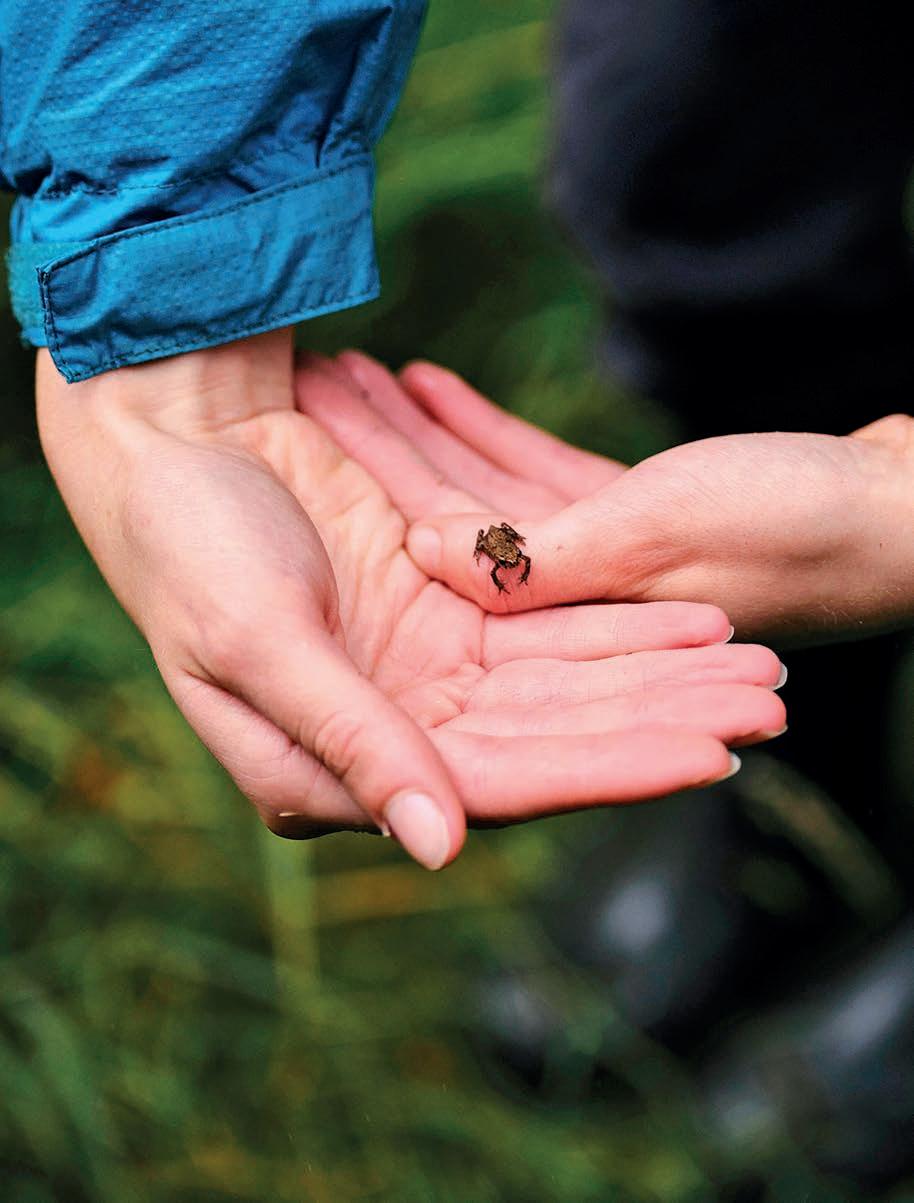
We Feed e UK is a storytelling campaign that pairs poets and photographers with 40 custodians of British land, soil, seed and sea – now compiled into a book for the rst time. is shot features one of the young people restoring wildlife at the Penpont Project – the UK’s largest intergenerational nature restoration project at a large, rural working estate in Wales. Ninety percent of Welsh land is currently used for agriculture, and this project aims to promote agroforestry and better practices.
We Feed e UK: Groundbreaking Stories, Told rough Radical Collaboration Between the Arts & Agroecology (£35, Papadakis. uk.bookshop.org)
Edited by Tessa Dunthorne
spotlights 12 innovations transforming the way we live, work and care for the planet
Gl obal issues require multi-pronged approaches and collaboration to drive truly transformational change. From the materials we build with to the clothes we wear and the way we produce food, regeneration is becoming a guiding principle. With contributions from Springwise and is Way Next, we explore the practices and innovations that are helping us improve agricultural e ciency, reduce CO2 emissions, regenerate ecosystems, and rethink how we interact with the world.
You don’t always have to dig deep to strike gold. Inspired by the warka tree of Ethiopia, this lightweight tower, made from latticed bamboo with a polyester mesh lining, collects litres of clean drinking water out of thin air, harvesting water from rain, fog and even morning and evening dew. The mesh netting captures the moisture in the air, which is then held in a tank, and there are reflective mirrors at the top of the tower to deter birds. Designed for use in remote developing areas and water-scarce communities, this is a towering example of circularity at work. warkawater.org
2

While climate change continues to wreak havoc on our ecosystem, computer scientists at Washington University in St Louis are employing Artificial Intelligence to help us manage and identify the real-time effects. TaxaBind is a multimodal AI model that helps identify and classify species while making it easier to map and monitor the groundlevel environment. This is good news because it will allow improved ecological research and the system is already able to use the combination of satellite images and groundlevel species images to retrieve habitat characteristics and climate data.


4
Felicia Neuhof is an architectural designer who sees food waste differently, particularly the seashells discarded by restaurants, which she’s transforming into regenerative building materials such as wall tiles and stools. Her work was presented to King Charles and her brand, Shellf Life, has also exhibited products at Hampton Court Palace. By repurposing shells discarded by the seafood industry she has developed an alternative to concrete, ceramic and plastics. ‘We’re implementing and testing these tiles in homes across Vermont, Rhode Island, New York and Pennsylvania,’ Neuhof says. ‘There’s something poetically circular about materials that once protected marine life now protecting human habitats.’ shellflife.com

By identifying the plants, animals, insects or microbes’ genes responsible for producing certain colours, Colorifix is pioneering a sustainable way to dye fabrics. These pigments are naturally found in nature and are recreated using engineered microbes that Colorifix is then able to reproduce in a laboratory setting. Conventional dyeing processes use between 30 to 150 litres per kilogram of fabric – with this innovative solution Colorifix is reducing water use by 90 percent and eliminating toxic chemicals entirely. colorifix.com
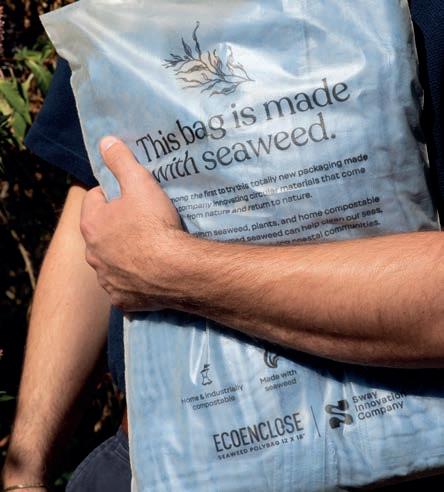
In 2023, US startup Sway won first place in the Tom Ford Plastic Innovation Prize for its plastic-free packaging solution. The company replaces traditional plastic packaging with a blend of seaweed, plants and compostable polymers. These ‘material innovators’ have created polybags, which will decompose naturally. It’s an oceanfriendly alternative to polluting single-use plastic. Sway’s aim is to connect with existing infrastructure to provide real solutions in a seamless manner, making it easier for companies to switch to this green alternative. swaythefuture.com
5

6
‘Our giraffe is our best-selling sculpture, with its graceful neck, commanding pose and beautifully detailed eyelashes,’ says Joe Mwakiremba, head of sales at Ocean Sole. ‘It captures attention and hearts alike.’ The giraffe is made from discarded flip flops found on the beaches of Kenya, which Ocean Sole transforms into art while creating jobs and a true sense of community.
The collected flip flops are glued together to form blocks that are then carved into sculptures, usually in the form of wildlife affected by pollution. The company recently collaborated with Italian designer Serena Confalonieri to create a collection of vases. oceansole.com
You may sleep better knowing that your bedding has been created using recycled materials such as feathers and down. UK-based EarthKind specifically recycles old bedding to create high quality, sustainable luxury versions. ‘We believe that choosing eco-friendly products shouldn’t mean compromising on comfort,’ explains Steven Duncan, group sustainability lead at EarthKind. ‘We use only quality recycled feathers and down.’ The feathers and down are collected, washed and sterilised in Britain using 100 percent energy from renewable sources, such as solar, wind and hydro power. earthkind.co.uk


UK-based biotech company CroBio has developed a product that farmers can apply around the roots of their plants to help them improve the soil’s water retention.
Specialising in soil regeneration, CroBio’s bacterial cellulose is a sponge-like material that is applied once during growing season. This cellulose naturally absorbs into the soil and has been proven to improve water retention in sandy soil by 200 percent. This is ideal for droughtprone areas and a potential solution for degraded soil – a major contributor to crop failure. crobio.com

At the Venice Biennale this year, curated by architect Carlo Ratti, the theme ‘Intelligens. Natural. Artificial. Collective.’ explores how architecture can harness various forms of intelligence, both natural ecosystems and artificial. At the Turkish pavilion, different research projects focused on how we work with soil and repurpose materials that are often discarded without thought for the possibilities they possess. Impressively, a large marble structure reminiscent of classical architecture was constructed using 3D printing and the principal material is stone dust – usually discarded as waste. Advanced printers are now able to reproduce complex structures by ejecting, layer by layer, a stone-based paste to gradually build the desired shape.


The Limbo Architecture Lab (the research arm of the Limbo Museum in Kumasi, Ghana) has joined forces with Bonnie Hvillum of Natural Material Studio in Copenhagen to run biomaterial workshops using Ghanaian local soils, agricultural byproducts and construction waste. The resulting prototype materials can be used on partition walls, as ceiling applications or external wall cladding in local building projects – bringing them back into use in a sustainable manner, which is a focus for the Limbo Architecture Lab. limbomuseum.org


From East Africa to West LA, coffee forms part of a daily ritual that brings people together and helps kickstart the day. In an effort to reduce waste, Lavazza has created Tablì 100 percent coffee tabs, which allow you to indulge in capsule-free coffee via its new coffee machine. The Tablì pods can be popped directly into the machine, eliminating the need to recycle any capsules as the only waste produced is the spent coffee grounds, which can be composted or reused for other domestic purposes. lavazza.co.uk

Italian design studio Winetage partners with winemakers to source and extend the life of French oak barrels. These 500-litre oak containers have already been in use for up to six years and so when they are repurposed by skilled artisans to create furnishings such as the Pienza floor lamp (right), the material goes on to live a third life. The rosetinted timber owes its hue to having aged wine, and this design also incorporates the offcuts from marble that would normally be discarded. It’s Italian handcrafted modern oak furniture without cutting down trees. winetagedesign.com n


MADE FOR LIFE ORGANICS
Hand-blended Cornish beauty products from the first UK B Corp-certified spa and wellbeing brand. Daily rejuvenating face oil, £53. madeforlifeorganics.com

INLIGHT WELLNESS
The only beauty brand in the UK to achieve a COSMOS Organic certification, InLight Beauty’s treats are as kind as they are lovely. Amethyst gua sha, £43. inlightbeauty.co.uk

SKYDIAMOND
Formed in 2018 by green entrepreneur Dale Vince, Skydiamond’s jewels are carbon negative. Pink asscher and 18ct recycled gold sky signet ring, £3,050. skydiamond.com

BLACKACRE
Timeless heirloom pieces from the first top tier British jeweller to achieve B Corp. Three carat tennis bracelet, £6,750. blackacreldn.com
GIBSONS GAMES
Enjoy Caravaggio’s art on family poker night. Gibson Games received an award from the King in recognition of its contribution to sustainable development this year. £5.49, gibsonsgames.co.uk

GOLDEN HOOVES
Golden Hooves’ products – ranging from cheese to delicious pantry staples – are farmed regeneratively. Sage and onion crackers, £3.65. goldenhooves.co.uk

PLENAIRE
Plenaire’s skin frosting deep face mask contains raw coconut oil, cocoa butter, shea butter and coveted Japanese tsubaki – and is carbon neutral. £32, plenaire.co

BRUICHLADDICH
An ambitious whisky house with aims to decarbonise the process of distillation this year, The Classic Laddie is a brilliant Islay single malt for any collection. £46, bruichladdich.com


ANNOUSHKA
Timeless, elegant, perfect for stacking – and Butterfly Mark certified. Whoopsie Daisy 18ct yellow gold pink sapphire ring, £2,500. annoushka.com

THE WHITE COMPANY
Your feet can stay cosy in these cashmere bed socks from The White Company as all of its wool meets the Responsible Wool Standard. £38, thewhitecompany.com

EQUINOX ORGANIC
Organic, B Corp certified – and available on subscription.
Equinox’s kombucha is available in a range of flavours. £23.99 for 12, equinoxkombucha.com

BIO D
This all-natural household cleaning brand has rolled out its first collection of handcrafted soya wax candles that will keep your home feeling fresh all day. Sustainable candle, £12. biod.co.uk


LA MAISON COUTURE
Jewels and gold that feature in the Forget Me Not Earrings – like lapis lazuli, black diamonds, sapphire, aquamarine and 14k gold – are fair mined. £4,840, lamaisoncouture.com

L’OCCITANE EN PROVENCE
A big company with a commitment to traceability in its supply chain – and incredible smelling products. Almond shower oil, £22. uk.loccitane.com

CRANBOURN LONDON
Crowned by ten natural reeds, English Garden Party is dreamily light and floral. The B Corp fragrance brand is cruelty-free and supports pollinator conservation. £38, cranbourn.com

THE BOTANIST
The Botanist employs two full-time foragers to responsibly source its Islay ingredients and care for juniper in the wild, with 60 plants on the go right now. Gin, £37. thebotanist.com

ST EVAL
Made with vintage drawing machines and finished by hand at the factory in Cornwall, these dinner candles are ultra-chic. Rose candles, £30. st-eval.com

S’ABLE LABS
A clinically proven, radianceboosting moisturiser which sources ingredients from smallholding farms around the world. £50, uk.sablelabs.co

In a year where net zero became a political football, these British and Irish hotels showed how hospitality can hold the line – with intelligence, integrity and impact. But which one has scooped the Country & Town House x Polestar Sustainable Hotel of the Year Award 2025? We reveal all

ustainability has never been more urgent – or more politicised. Once a subject reserved for scientists, systems thinkers and quietly committed businesses, ‘net zero’ has now been dragged into the culture wars. In the UK, we’ve seen Ed Miliband argue for green growth while Nigel Farage calls climate policy a ‘con’. Across the Atlantic, Trump is campaigning on climate rollback, framing environmental protections as barriers to business.
It’s a dangerous narrative. When sustainability becomes politicised, it risks being seen as optional –or worse, ideological. But amid the noise, progress is being made: governments may stall, but brands can still lead. Especially in hospitality, which connects everything – people, place, nature, food, joy.
at’s why we launched the Country & Town House x Polestar Sustainable Hotel of the Year Awards.
Over the past two years, entries have revealed a passionate network of purpose-led hoteliers already integrating sustainability behind the scenes – many without fanfare or recognition. is year, we saw even more ambition.
Our questionnaire went deep – covering food sourcing, biodiversity, carbon strategy, DEI, community initiatives, design and more – and the entries came in from every corner of the UK and Ireland. From the remote shores of Donegal to the heart of Knightsbridge, the best hotels showed us that sustainability isn’t a trend, it’s the only way to operate.
We also saw just how tough the path can be. Historic buildings, limited budgets, guest expectations, sta shortages, wage rises, a lack of clear regulation or shared measurement standards. Yet despite it all, passion and progress are in full view.
And so this year, we expanded the categories, because sustainability is not one thing. As well as crowning one Overall Winner, we’ve recognised brilliance across four key areas: Design & Architecture, Food & Drink, Nature & Gardens and Spa & Wellness.
Each category winner – and every highly commended hotel – represents an icon of progress. Some are heritage hotels adapting old frameworks for the future. Others are new-builds setting out with irreproachable practice baked in. But all are asking the right questions, making the right moves, and showing what it looks like to lead.
As one of our judges Juliet Kinsman put it: ‘ e goal isn’t perfection – it’s progression. ese awards spotlight what’s working, so others can follow faster.’
We couldn’t agree more.
We’re proud to partner once again with Polestar, the design-led EV marque, as committed as we are to purposeful innovation. e company has set ambitious targets for climate neutrality and circularity. In 2023, it launched the Polestar 0 project – a moonshot to create a truly climate-neutral car by 2030, without relying on o setting. ‘Polestar’s ambition isn’t just to be “better than before” – it’s to reinvent what’s possible,’ says Lucy Cleland, editorial director of Country & Town House. ‘ at’s exactly the kind of thinking we want to champion in hospitality, too.’ n







FIONA DUNCAN
Hotel critic for the Daily Telegraph since 1999, Fiona has over three decades of experience in hospitality writing. She founded the Charming Small Hotel Guides series and currently edits Country & Town House’s Great British & Irish Hotels, with a sharp eye for character and comfort.
SARAH LANGFORD
A former criminal barrister turned author and regenerative farming advocate, Sarah manages a Suffolk farm transitioning to organic methods. She is the author of In Your Defence and Rooted, and speaks widely on sustainable agriculture, rural reform and the future of land use in Britain.
FRANCISCA KELLETT
Self-proclaimed eco-nut and hotel junkie, and one of the UK’s leading travel writers and editors, Fran is a regular face on panels about conservation and philanthropic travel. Fran is Country & Town House’s travel editor-at-large and writes a column on philanthropy for Times Luxx
PETRA PETTERSSON
Petra is Inclusion Lead at Polestar, specialising in ethical supply chains, circularity and human rights. With over a decade of experience at brands including MQ and KappAhl, she holds a Master’s in Advanced Textile Engineering and drives Polestar’s equality and environmental agenda.
LUCY CLELAND
As editorial director of Country & Town House, Lucy has spearheaded the brand’s sustainability strategy, including its 2023 B Corp certification. She leads on responsible editorial policy and is a regular speaker and panellist on regeneration, sustainability, and purpose-driven publishing.
MARIAN BOSWALL
Marian is a leading landscape architect known for her regenerative, ecologically sensitive designs. Her work spans floodplain restoration to heritage gardens, combining deep respect for land, people and place with sustainability and storytelling at the heart of every project.
JULIET KINSMAN
A journalist, broadcaster and sustainability expert, Juliet was Condé Nast Traveller’s first sustainability editor and is the founding editor of Mr & Mrs Smith. She now runs Bouteco, a non-profit consultancy promoting responsible tourism, and frequently appears on BBC and Sky News.
Awarded for a wellness offering that supports human flourishing and planetary health WINNER

‘ is is the future of spa – meaningful, grounded and rooted in nature.’ Lucy Cleland
More than a spa, Broughton Sanctuary is a 3,000-acre blueprint for a di erent way of living. Located within a rewilded estate in North Yorkshire, it seamlessly connects inner healing with outer restoration – a rare feat in luxury hospitality. e Avalon Wellbeing Centre is powered by renewable ground-source heat, while its woodland sauna, wild swimming pools and ice bathing rituals o er guests a visceral reconnection with nature. e judges were unanimous: this is not wellness as indulgence – it’s wellness as alignment with the land. Juliet praised its hybrid of regenerative estate and healing retreat, while Francisca admired how ‘you can feel the soul of the place in everything from the forest trails to the therapy programmes’. e Sanctuary’s citizen science project, where guests help monitor biodiversity and plant trees, earned further praise for giving visitors a sense of contribution as well as calm. ‘Broughton shows that you don’t need to pump in fragrance or turn up the heat to create a transformative spa experience. Let nature lead,’ says Fiona. broughtonsanctuary.co.uk

HIGHLY COMMENDED
‘A classic country spa that’s evolving with care and credibility.’ Francisca Kellett
South Lodge may look like a traditional vestar country house spa, but beneath the surface it’s making serious strides towards sustainability. e judges commended its thoughtful transition away from excess and towards experience, with nature-led spa days, wild swimming weekends, and vinotherapy treatments using local grapes. Fiona acknowledged its value in reaching a more mainstream audience: ‘It’s doing what the big heritage hotels must do – meet people where they are, but o er a better way forward.’ Petra highlighted the importance of South Lodge’s guest education and carbon awareness initiatives. exclusive.co.uk/south-lodge
‘It’s a sector built on comfort and delight – but comfort can no longer come at the planet’s expense. That’s why awards like these matter.’
LUCY CLELAND
Awarded for buildings that tread lightly, celebrate place, and prioritise both aesthetic and ecological intelligence

‘Proof that o -grid doesn’t mean o -trend – design-led, low-impact, and utterly beautiful.’ Francisca Kellett
From its hemp lime rendered walls to its hand-thrown ceramic sinks, Native Ballydehob rede nes the potential of sustainable design. is new o -grid guesthouse and retreat in West Cork was born from a simple yet radical idea: that regenerative architecture should be accessible, sensory and joyful. Built using as many natural and recycled materials as possible – many sourced on-site – it demonstrates that low-tech can still be gorgeous. Francisca admired its immersive design that gently guides guests back into nature. Six carbon-neutral cabins powered by renewable energy and supported by solar power are planned, while the architectural approach allows the buildings to almost disappear into the landscape. native.ie

‘A grand dame going green – showing others how it’s done in the city.’ Juliet Kinsman
For a luxury hotel embedded in London’s Knightsbridge, the sustainability challenges are steep – but the Mandarin Oriental is rising to them with style and substance. is year, it became the rst luxury hotel in London to install Naked Energy’s solar thermal system, helping signi cantly reduce its carbon emissions. e panel also noted its use of AI-powered food waste tech (Winnow Vision) and plastic-free operations. What impressed judges most was the ambition within constraints – nding ways to cut impact while retaining the hotel’s sense of occasion. ‘ ey’re not greenwashing,’ said Petra. ‘ ey’re changing systems behind the scenes –and that’s where real impact starts.’ ‘A heritage building, a global name, and yet they’re pioneering some of the most cutting-edge environmental tech in hospitality,’ adds Francisca. mandarinoriental.com/en/london/hyde-park
Running a sustainable hotel is harder than ever – but the rewards are growing too. Here’s what the landscape looks like today:
of UK travellers now say sustainability is important to them when choosing accommodation. (booking.com, 2024)
of UK hotels have a formal carbon reduction strategy in place. (Green Tourism UK, 2023)
Energy accounts for up to
of a hotel’s carbon footprint, followed by food waste and water use. (Sustainable Hospitality Alliance, 2023)
Food waste in the UK hospitality sector equals nearly one million tonnes per year — with only
Staff training and team engagement are now top priorities for forward-looking hotels – with 70% ONLY 5% 60%
currently recycled or composted. (WRAP)
Retrofitting old buildings is cited as the
NUMBER 1 18% 46%
barrier to progress among heritage hotel owners. (Historic England/UKHospitality)
planning sustainability-related education in 2025.
Awarded for reimagining hotel dining through sustainable sourcing, zero-waste thinking and culinary creativity

The Bull Inn, Totnes
‘ ey’ve proved it’s possible to be both ethical and exciting – and to run a business with soul.’ Francisca Kellett
e Bull Inn, Totnes, has been ying the sustainability ag in food long before it became fashionable. It was one of the UK’s rst organic pubs, and today continues to radically reshape what hotel dining can look like, from sourcing and supply chain to storytelling and joy. Everything here is intentional: they work only with organic farms, buy animals whole, create menus around availability rather than demand, and make their own ethanol to avoid global commodities linked to unethical practices. Even their wine list reduces glass waste through Bag-in-Box. ‘Geetie [ e Bull Inn’s founder] is not going to let anyone get away with saying, “It’s just too hard to do that” – because she’s done everything. From the very start, she’s looked for a better way,’ says Sarah. bullinntotnes.co.uk

‘A heritage hotel making real changes in the kitchen – and showing what scale can look like responsibly.’ Fiona Duncan
At first glance, Ashford Castle is the epitome of grand tradition – but dig deeper and you’ll nd a forward-thinking food programme underpinned by solid sustainability principles. From partnerships with local organic farms to seasonal menu redesigns and ongoing use of food waste tracking (via Winnow), this is a kitchen committed to improvement. Marian highlighted the property’s waste reduction mindset, while Francisca noted the value of large hotels like this setting the tone for the luxury sector. ‘ ey’re a quiet but powerful presence,’ she says, ‘with the potential to in uence guests who aren’t already converted.’ ashfordcastle.com
Awarded to a hotel that nurtures the natural world through habitat restoration, rewilding or biodiversity stewardship

Broughton Sanctuary, Yorkshire
‘Broughton doesn’t just respect nature – it gives it space, time and structure to thrive.’ Marian Boswall
For many, Broughton Sanctuary is the gold standard in regenerative hospitality. Beyond its outstanding wellness o er lies an ambitious rewilding and biodiversity restoration programme that is unmatched in England. With more than 3,000 acres under nature recovery, it combines ecological science with guest participation in ways that are truly unique. From beaver reintroduction to native tree planting, from citizen science wildlife tracking to the 30km Odyssey Trail that encourages an immersive exploration of the landscape, guests are invited not just to observe nature but to be part of its revival. ‘ is isn’t wellness in a marble basement – it’s birdsong, forest bathing, ritual. A pivot back into the world. And that’s what people want,’ says Sarah. broughtonsanctuary.co.uk

‘ e fact they’ve audited their land and are working through a management plan – that really shows commitment. Not just doing a bit of this and a bit of that. It’s methodical.’ Sarah Langford
A more traditional country-house hotel with a modern outlook, Calcot impressed judges with its clear, structured plan for biodiversity improvement. Unlike many who make vague claims, Calcot has completed a full land management audit and is acting on it – with pollinator-friendly planting, tree protection initiatives, and community engagement. ‘It’s a great example of a heritage hospitality business applying contemporary environmental thinking – and doing it without shouting,’ says Fiona. calcot.co
‘The goal isn’t perfection – it’s progression. These awards exist to spotlight what’s possible, share what’s working, and inspire the sector to go further, faster.’
JULIET KINSMAN
Awarded to the hotel that demonstrates leadership, ambition and accountability across every aspect of sustainability – from carbon to community

‘Mandarin Oriental is retro tting sustainability into a grand Edwardian pile. at’s not easy. And yet they’re showing it can be done.’ Juliet Kinsman is year’s winner may come as a surprise to some, but the Mandarin Oriental Hyde Park impressed the judges on every metric – and all from within the constraints of a Grade II-listed building in one of London’s busiest postcodes. Where others have tiptoed, they’ve taken bold steps: installing Naked Energy’s solar thermal collectors (a rst for a luxury London hotel), which will allow the building to generate its own renewable heat to provide hot water for the hotel’s 181 rooms and suites, integrating AI-driven food waste systems that have cut wastage by 50g per cover, and delivering measurable annual impact targets across water, waste and energy. Sustainability at Mandarin Oriental Hyde Park is not a bolt-on – it’s a strategic priority. Judges were particularly impressed by the breadth of its approach: from near-total plastic elimination to Fairtrade procurement, DEI training and ongoing team engagement. Mandarin Oriental is setting the benchmark – and with its global in uence and impact, others should take note and follow. mandarinoriental.com/en/london/hyde-park

HIGHLY COMMENDED
Inn,
‘Soulful, values-led, and wildly creative. ey make hospitality feel joyful.’
Francisca Kellett
Once again, e Bull Inn has captured the judges’ admiration for its radical transparency, low-waste ethos and deep connection to place. is nine-bedroom inn runs on principle as much as on pro t, with a regenerative food system, on-site re ll store, in-house natural cleaning products and a Scope 1 and 2 carbon tracking framework. ‘If you want to understand what “regenerative” really means, go to e Bull Inn,’ says Juliet. While it may not have the same scale or legacy systems to rewire as the Mandarin Oriental, nor can it (due to the physical building) be easily accessible, e Bull Inn is a lighthouse for small independents, proving that ethics and experience can – and should – go hand in hand. bullinntotnes.co.uk n


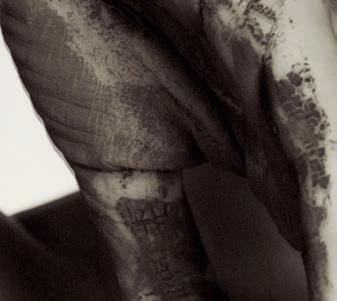














Will the ‘Regeneration’ ditch the screen to save the planet, asks James Wallace


We humans do like to procreate.
If you, or more likely your lovechild, were born in the past 20 or so years you/they have the privilege of an extended life expectancy that our horny ancestors could only have dreamed of. According to Statista, in 1910 the UK average life was only 52 years; by 1960 it had rocketed to 70, and now you can look forward to 82 years on Planet Earth.
With 15,000 centenarians in England and Wales, never before have so many people smacked a century out of the park thanks to modern wealth and health. We can sit back and relax in the knowledge that our Gen Z or Gen Alpha o spring will bene t from nutritious food, novel cancer treatment and the joys of a ful lling and active lifestyle.
But there’s a deeply ironic catch to all this good news. Our life support system – nature – is about to snu it. is beautiful blue galactic space-marble will soon no longer support the eight billion people suckling from her once over owing teets. She giveths hope with one hand and takeths away sustenance with another. Despite the promise of longevity and abundance, many of our immediate descendants will not live full lives. is deeply unsettling truth will break many hearts as eyes are opened.
Everything we hold dear is at risk, as other societies across the globe can attest. Many parts of the world are becoming uninhabitable already, thanks to extreme weather – oods, drought, wild res – and extreme politics. Simply put, there will not be enough food, water, shelter and stability for us all to live.
But that’s okay because our kids will x the problems. Or is it? As parents we haven’t exactly helped them prepare. Just
getting through childhood unscathed is a miracle. Never before have so many people been so privileged yet so at risk of being overwhelmed by the worries of inheriting an ecological desert, the e ects of deprivation from mother nature and the temptations of highly addictive screens. Even the small things, like having the right shaped eyebrows to survive social media, would bring us oldies out in hives.
ankfully though, there is hope in some exceptional, young people who see what the tidal wave of corporate greed, conspicuous consumption and genocidal leaders is doing to them and their planet. ere is an enlightened ‘Regeneration’ getting ready to rebuild our infrastructure, regrow our ecosystems and unleash the wisdom and experience of youthful leaders and collaborative workers.
Inspired by hundreds of young activists, there is a new trend in town – bucking the sel sh ideals of capitalism, harnessing the digital tools threatening the mental health of millions, and challenging the system with a positive alternative reality. In the words of First Nation Canadian Autumn Peltier (20): ‘We can’t eat money, or drink oil’. Creative educators like Singaporean Qiyun Woo (28) are literally rewriting our global economic model.
From local food collectives and citizens assemblies to ethical online trading and alternative currency start-ups, never before has a group of dispersed and determined individuals formed a global community building a new future for the bene t of the many, not just the few. Will the rest of the Regeneration reject the false security of ickering screens in the Net ix cave to join the mutually bene cial ranks of youth changemakers in broad daylight?
THINK DIFFERENTLY, ACT NOW
Time to mobilise our youth

WATCH
The Emmy-winning Live to 100: Secrets of the Blue Zones with author Dan Buettner, as he explores the places where people live the longest. netflix.com
UNDERSTAND AND TREAT
Digital addiction and screen dependency disorders at NeuroHealth Associates, which helps children, teens and adults to increase focus and reduce brainrelated stress. nhahealth.com
SUPPORT The next generation of climate leaders. theresilienceproject.org.uk
EDUCATE
Your love child in climate justice by signing them up for the Friends of the Earth and Richard Sandbrook Trust mentoring programme. friendsoftheearth.uk n
Sarah Angold turned away from celebrity to create an alternative to cotton , raising thousands of banana farmers out of poverty in the process. Lisa Grainger reports
ananas are not something Sarah Angold ever expected to become an expert on. e 42-year-old had previously been a jewellery designer whose pieces had been worn by Kim Kardashian and Cara Delevingne. She was a textiles expert, with a masters from the Royal College of Art. She’d overseen exhibitions for the Design Museum and created car interiors for Toyota in Japan.
And then came a growing sense of unease. Like many of us during Covid, she suddenly had time to consider her choices in life – and think about the state of our planet. ‘When there is so much shit going on in the world, it comes into focus that solving a celeb’s red-carpet look really isn’t of global importance,’ she says. ‘I started to feel that you had to be insane to work in the fashion industry – and, if you did, you had to have an irrational love for the game.’ And like many of her contemporaries, she adds: ‘We started to experience extreme guilt about the thing we loved. It was like a dysfunctional relationship. It felt upsetting. Eventually I realised I couldn’t be part of it unless I was part of the solution.’
Like many women with small children who’d previously had careers, she’d also begun to feel a loss of identity and purpose. Her jewellery had been sold in famous stores internationally, but was never going to provide her with a regular income. And while her creativity had been ‘harnessed to solve material challenges’ for artists from Grayson Perry to Yinka Shonibare, she didn’t have the tools, she felt, ‘to understand how the world works. If you want to gure out the landscape in which the climate crisis and humanitarian crisis lie, you have to understand nance, economics and policy. And I didn’t. I began to realise that a lot of women my age were in theory successful, but at what? We were all thinking: “What the fuck is this? Our world is broken but we don’t know how to x it.” I needed to change that.’
Banana plant stems, Angold soon learned from him, only bear fruit once – and then are chopped down. Although in some parts of the world bres from the banana trunk had been used to make mats and baskets, no one had successfully created machinery and ecological softeners to turn them into thread for clothing. So once the plant had fruited, the plant stems were cut and burned, producing an estimated 315 tonnes of waste globally.
Today, two years later, the two founding partners of 29Acacia (named after the address of e Beano comic book character Bananaman, who lived at 29 Acacia Road) haven’t only developed a way to transform banana trees into thread, but to do it in the most e cient, environmentally friendly way possible. First, the duo developed a simple-to-use, solar-powered, mobile-phone-controlled decorticator machine that ts on to the back of a truck. is can be taken to farms to macerate the tree trunk, leaving the farmers with only compostable waste – and payment for the extracted bres.
‘When there is so much going on in the WORLD, it comes into FOCUS that solving a celeb’s RED-CARPET look really isn’t of GLOBAL importance’
So, bit by bit, she set to work – over six years – to expand her knowledge. Her rst step was to do a course in sustainability at Cambridge. en she started sustainability supper clubs, inviting experts to come together over Zoom and talk, ‘from MPs to economists to people in the UN’. She enrolled in a course on nance and policy, which resulted in her writing a chapter in a book about sustainable governance in the fashion industry. And nally, she went on a venture builder programme, run by an impact fund called Zinc, that invests in solutions on the climate. ‘ ey pay 70 people to sit in an o ce and come up with solutions to shit.’
It was there – in a situation she describes as ‘a sort of Apprentice meets Love Island ’ – that she met the 25-year-old Varun Raheja, who would become her business partner of their joint venture 29Acacia. e Indian entrepreneur was on a mission to try to lift farmers in his country out of poverty and had already successfully founded a business drying fruit that couldn’t be sold at market. And he had another idea of how to use fruit trees, but this time to make fashion, which was Angold’s area of expertise.

en they perfected an enzyme mix to break the bres down and soften them, so they could be spun into a cotton-like thread that’s pliable, hardwearing and can be dyed, and washed in the same way.
Compared with cotton, whose production requires huge tracts of land and water (about 2,700 litres for one T-shirt), ‘our bre has one-tenth of the carbon footprint, uses one-hundredth of the water, and zero extra land and insecticide,’ Angold says, proudly. And on top of that, she adds, by giving the farmers an additional fee for their bres, ‘we think we can raise 100,000 of them out of poverty in ve years’.
Excitingly, in April she wore the company’s rst pair of jeans made from banana bres to Kingpins, the international denim conference. And Arvind, which makes denim for brands from Gap to Ralph Lauren, has agreed to trial the thread in their mills.
In the next six months, the duo hopes to make about half-a-million metres of 20 di erent types of fabric, and get them formally approved and trademarked so they can roll out the business internationally. While currently their banana- bre thread is not as cheap as organic cotton, it should be once they’ve scaled up the process, Angold says. And if that works, they can start to look at other crops that have dual use. ‘With bananas, you get fruit and bre. And that’s crucial. Right now, we use land, water and energy for fashion while local populations starve. Who wants that?’
Plus, she adds, global fashion produces about 3.3 billion tonnes of CO2 a year – and most of that comes from producing fabric. More than 16 per cent of all insecticides are used on cotton and 300 million trees are cut down annually to make viscose – a third of them from endangered forests. ‘If we just used bananas, we would have none of those problems,’ she adds. ‘And they’re the most popular fruit on earth. So it’s a no-brainer.’
29acacia.com n




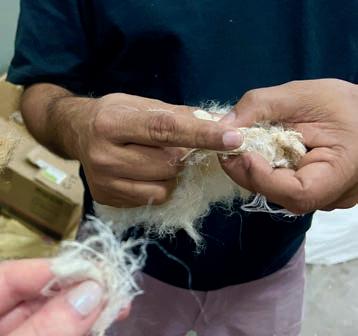

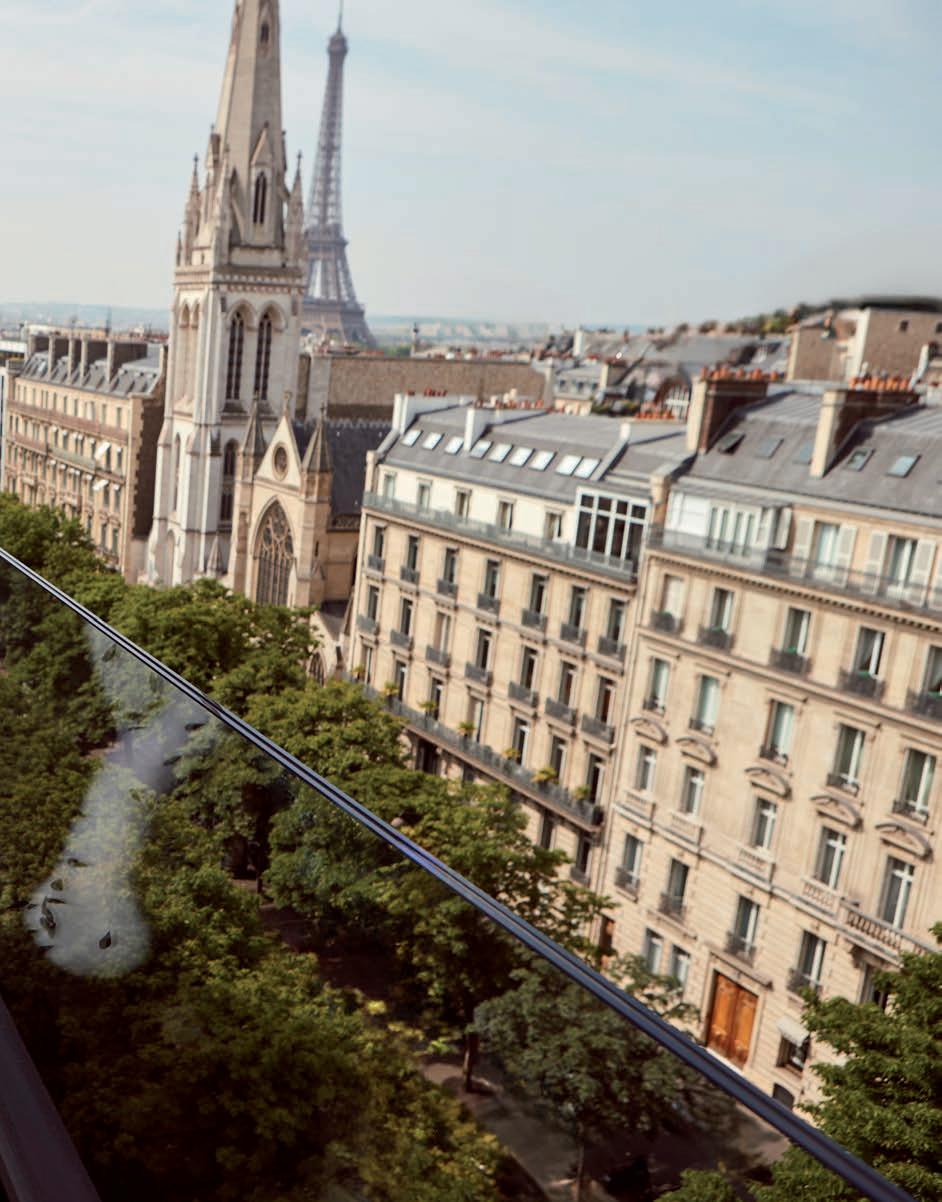





Elie

TEAM Photographer’s
assistant: Molly Farrell
Fashion assistant: Lacie Gittins
Make-up: Phophie
Mathias @ Wise & Talented (Paris)
Hair: Celine De Cruz
@ Capsule Agence
Model: Manon
@ City Models
Video: Nicholas Visuals
@nicholasvisuals
Production: KO
Collective Paris
Location: Bvlgari
Hotel Paris
at Bvlgari Hotel Paris... what could be more enchanting?

It felt tting to stage Country & Town House ’s rst ever couture shoot in the City of Light – where the rooftop gardens of the Bvlgari Hotel Paris more than set the fairytale scene. Planted with oaks, magnolias, philadelphus, apple and oak trees, this natural haven o ers 360 ° views of Parisian icons, from the Sacre Coeur and Grand Palais to the Ei el Tower, a 15 minute-stroll away.
e nest couturiers sent dresses, works of art with tiny pleats and pieces of chi on and lace hand-sewn and hand-beaded. ‘Until you see them up close, you don’t realise the detail and level of craftmanship involved,’ says C&TH fashion director Nicole Smallwood. ‘ e Dior dress [on the cover] stood up on its own.’ Most required two people to lift them onto French model Manon.
Little details at the hotel – with its 76 rooms and suites right on Avenue George V – cosseted the C&TH team: jars of Parisian chocolates left in the rooms each day (great for agging energy), the ‘rain mist’ showers, the beautiful 1,300 sq/m spa, tiled semi-Olympic pool and state-of-the-art gym – an essential for Smallwood, ‘although for Manon, wearing the dresses was like a workout,’ Smallwood says.



e shoot caused qu ite a stir – with each look featuring Bvlgari High Jewellery, the two security guards were never more than two feet out of shot. ‘It’s just a shame you can’t see the shoes,’ Smallwood says – most couturiers sent couture shoes to match the dresses. ‘It was out of this world – like playing dress up, only with couture on a summer rooftop in Paris.’
Doubles from €1,900 per night. bulgarihotels.com n






With her new label, AKYN, Amy Powney is rewriting fashion’s rules and the industry should pay close attention, says TIFFANIE

ith her new label, AKYN, designer and activist Amy Powney is taking everything she’s learned – from a childhood lived o -grid to fashion’s front row – and rewriting the rules. Grounded in circularity and community, her vision goes far beyond style: it’s a bold blueprint for a regenerative future, where clothes are made with conscience, and worn with intent. ree years ago, with a nine-month-old baby under her arm, Powney changed the view of an industry. With a raw and penetrating lm, Fashion Reimagined, she documented her journey to create a capsule collection from just three natural fabrics – cotton, wool and denim. Tracing her supply chains back to the root took her to Uruguay, Turkey and Austria, and the global complexity of the challenge opened the eyes of all who saw it. In the wake of Covid, everyone then began to ask the same questions.
But the moment she nished the lm, Powney already knew she wanted to do more. ‘ at journey was essentially me going, this is how we do fashion, can I do it better? But all I did was replicate the same system.’ e resulting collection for her erstwhile brand, Mother of Pearl, was not ambitious enough. AKYN is the sum of everything she has learned since then – about design, fabrics, manufacturing, and about community and process. ‘I realised circularity had to be the approach. Circularity isn’t just reselling or repairing, it’s a whole idea –how you’re growing your crops in a regenerative way, how you are managing your factories from renewable energies, how you’re managing waste streams, how you are giving to your sta and your community and creating this entire business model where you’re putting people, planet and pro t all into the equation.’
Powney is a radical, and that is a rare beast in fashion these days. AKYN begins with a tight, minimalist collection of hero pieces, with design echoes from Mother of Pearl. But its vision is to prove to the industry that circularity, conscience and responsibility can be intrinsic to the process.
Powney’s entry into the fashion world was not textbook. She grew up o -grid, living in a caravan in a eld in Lancashire, with her dad pouring buckets of water through the roof so his two daughters could take showers. ‘My passion for fashion came out of the bullying I got from not being able to t in,’ she says. ‘Because my visual appearance re ected my nancial background. At that time in the nineties it was the sports era – logos, three-stripe tracksuits, Spice Girls. I got obsessed with having to have that because I wanted to t in. But that journey gave me understanding. Most kids don’t question where electricity or food comes from – things just arrive, switches get pressed. I had to live through the hardship of where water came from, which was a well in our ground. We could only turn on the television if there was wind outside, because that’s how we got our electricity. It gave me a very deep, raw experience of resources and a base respect that I’ve never lost.’
her circular vision, but to invent her own brand and design from the ground up. Her understanding of clothing is forged in the re of her own experience, as a mother, as a partner, as a designer, as a CEO, as an activist (watch her thrilling TED talk) and now as a founder. ‘Women have so many di erent shades to who they are. We are mothers, we are children of mothers, we are career women, we are sometimes having to be boss bitch, sometimes maternal, nurturing human beings. We have days where we’re deeply rooted and connected and other days we’re in a frenzy.’ Anyone who has worn Mother of Pearl knows the design team understands this. We don’t have time to think most mornings – we just need to put something on that signals our values and our mood and will also practically and comfortably get us through the day. And yet clothes are everything to us. Our con dence, our personality, our attitude, our intellect. ‘Women don’t need me to make them who they are. eir best skin is their own skin and I just need to give them something that makes them not feel like everybody else. To make them feel the best that they possibly can.’
And so the Elsie jacket and trousers in 100 percent wool is the kind of suit that will last in your wardrobe for decades. Made from Portugal’s merino sheep, it is undyed and woven in a local mill, then cut and sewn there too. e jacket is tted, but with an interesting cocoon sleeve and oversized button detail. Just enough edge to get you noticed. e slouchy trousers are inspired by menswear with pleats down the front, and a 100 percent organic cotton waistband (most are polyester).

You will nd a pearl shoulder on a long Tencel robe that shapes to the body like a dress. ere is easy denim and uid black and navy dresses that will take you through the day and out into the night. Sweatshirts and t-shirts have been added as entry points (discreet slogans, ‘Soil not oil’ and ‘Girl Moss’, signal AKYN’s magic and intent). ‘ ere’s nothing plastic except in the trimmings. Part of my work is embracing new tech and innovation. Where I stand today on regenerative bres and not using synthetics – maybe in ve years we will have solutions.’ Tiny percentages of elastane or recycled nylon have been added to some of the garments to give longevity and performance, but the balance is creating clothes that last, because these are wardrobe keepers, ones that should march through life with you.
‘It’s progress not perfection,’ says Powney, with the experience and knowledge of taking the hard road for a number of years. ‘We’ve landed the best possible suppliers that use the best possible bres at the price that we can produce at, at the scale we’re at. But I will never stop my ght to be perfect.’ AKYN comes from ‘kin’, meaning folk. ‘Because it’s not about me. It’s about the girls that work here, the factories we work with. And it’s also about you. I can’t produce if I don’t make things you can wear. We all have to do this together.’
After school, Powney enrolled at Central Saint Martins. She got her rst job at Mother of Pearl, where the small size of the label allowed her to get involved with all facets of the brand. After 19 years, working her way up from assistant to creative director, she evolved the minimalist design aesthetic that has become her trademark. Transitioning her work at Mother of Pearl into AKYN has given her a new freedom, allowing her not only to hone in on
As for process, Powney is ready to take on the industry. ‘I’m trying to nd the balance of how to have a regenerative business model and still have a seat at the table. I want to sit with those big CEOs and say we are turning over X and we have achieved Y, and we are using these bres, we have scaled up and we have all these regenerative business practices. And here’s our sustainability reports, and it can be done.’
akyn.com n



‘I had to live through the hardship of where water came from, which was a well in our ground. We could only turn on the television if there was wind outside, because that’s how we got our electricity. It gave me a very deep, raw experience of resources and a base respect that I’ve never lost.’ Amy Powney




Elizabeth Day has shared her heartbreaks with millions – but it is her capacity for hope that shines, says LUCINDA BARING
Elizabeth Day and I are discussing life – and in her case, success – in our forties. As she publishes her tenth book, there is no doubt she is thriving but not without her struggles to get here. ‘In my 20s, I didn’t know who I was – but I thought I did which is a terrible combination. I now understand my 30s were for me to sort out my personal life: I went through a divorce, started fertility treatment and had my rst miscarriage. I don’t think I could have managed professional success at that moment in time because I was emotionally so invested in sorting out my relationships and my desire to become a mother.’
She has certainly been busy: Day is best known as a writer (of ve novels and four works of non- ction) and creator-host of the How To Fail podcast (now in its 21st season, guests include everyone you’ve ever wanted to hear from: writers, musicians, actors, politicians, from Jilly Cooper and Salman Rushdie to Bonnie Tyler, Jane Goodall and last week, Monica Lewinksy). e threads that bind Day’s work are connection and storytelling but it is writing that’s ‘nestled in her soul’ from a very young age. ‘I consider it one of my great loves, where I make most sense.’ While she has OG readers who have been with her from the start – and she craves the quiet and space writing delivers – she acknowledges her bigger audience came through the podcast. ‘It’s a lot of work, but it’s work I really value and that teaches me a lot.’
She once said that heartbreak is a great fuel for creativity. Now that she’s happy in love, with second husband Justin Basini, might that creativity dry up? ‘I still remember my heartbreaks so vividly, but I’ve learnt from Justin that there is so much creativity in feeling safe. And there are many other ways to experience heartbreak, like friendship heartbreak or the heartbreak of letting go of something you thought was your lifelong dream.’
Day is generously open about her ‘fertility journey’ and recently revealed she has stopped receiving treatment after 12 years. No longer grieving the idea she will become a biological mother, she says she has nally found peace. ‘Grief is such a powerful word. I don’t want to trivialise it. Sadness seems more appropriate now. ere’s an ambivalence because I will always live alongside the sadness of not having children, but it’s also given me the life I’m living now.’
at means focusing on the podcast (still compelling in what has become a crowded eld) and this September, her sixth novel One of Us is published. It’s a sequel to 2017’s e Party, a psychological thriller with strains of Brideshead and e Talented Mr Ripley, and an antecedent to Saltburn, in which scholarship boy Martin inveigles himself to the Fitzmaurice family through his boarding school and Cambridge friendship with glamorous Ben Fitzmaurice. One of Us picks up the same cast: Ben is on the cusp of power in British politics just as his family begins to unravel and Martin nds himself unexpectedly invited back into the fold.
ey are a fascinating, well-observed and mostly loathsome bunch and Day admits damaged characters who behave in despicable ways have always intrigued her. ‘ ey give us a window into this [aristocratic, politically elitist]
world that we might have prejudices about but we also envy. And that’s an interesting contradiction. Often a character like Serena [Ben’s wife: vapid, lonely, unful lled] will trigger something in us and so it’s a clarion call not to allow those initial judgments to cloud our need for understanding.’ e search for understanding – and empathy – is a big driver for Day, ‘whether it is a podcast episode asking you to look beneath the bonnet of success or writing a character who might seem unlikable and hopefully revealing that they’re much more like you than you imagined’.
Day always secretly liked Martin – who in e Party is a creepy borderline sociopath whose sexuality is repressed – and wanted to give him his redemption. ‘When I started writing novels, I had no compunction about putting my characters through really di cult situations. I still do that because it’s where some of the most interesting material lies, but I also want them to have hope. ere’s much more hope in this book.’
Being less critical of herself has also allowed her to write more freely. ‘In my early ction I was struggling so hard to be taken seriously. I confused being a serious writer with being serious in prose, but writers who get you by the throat and pull you into their pages are ones who understand light and shade and the humour in life.’
Day has always been a sharp observer of people, rst in her job as a young newspaper diarist, and then as a journalist. Now in the podcast – each episode essentially an intense and revealing therapy session – might her guests worry she will mine their aws for her novels? ‘Half of them don’t know I write books,’ she laughs. ‘It probably all goes into the primordial soup of trying to understand human nature. But I take seriously creating a safe space where someone can be vulnerable. When someone meets me on that level, I would never betray it.’
I can see Day turning her hand to acting, perhaps in a piece co-authored by (and co-starring) her pal Phoebe Waller-Bridge. ‘You’re not the rst person to say it but I dismissed it because I didn’t want to sound like a twat. I did have a psychic reading once where they saw directing in my future. Recently though I have found myself writing more poems, “she said to the sound of everyone’s heart plummeting”.’
She strikes me as considered and highly evolved. What makes her feel vulnerable? ‘Conversations like this. I am so used to being the one asking the questions.’ What doesn’t she want to be asked? ‘Anything about my ex-husband [BBC journalist Kamal Ahmed]. at is his story to tell.’
Her happiness coda is simple. ‘I remember reading the incredible White Teeth at university. Zadie Smith had got a massive deal for her rst novel and I hoped for the same. Obviously, I got a tiny advance – as is only right – which meant there was minimal expectation. I’ve realised the secret to contentment is to approach things with your whole heart, but with managed hope. en if something exceeds your expectations, you’ll feel so much more ful lled.’
One of Us (£18.99, 4th Estate) is available to pre-order now. Elizabeth Day will be discussing One of Us with Marian Keyes at Chelsea Arts Festival on 21 September (chelseaartsfestival.com) n

‘It all goes into the primordial soup of trying to understand human nature. But if someone meets me on that level, I would never betray it’
Violet Manners is on a mission to future-proof Britain’s grandest homes. With her new platform, HeritageXplore, she’s reinventing heritage tourism for a new generation, says SKYLAR PI NCHAL


t’s a very special, cool, and unique concept in this ever-so sped-up world,’ says Violet Manners, as a chau eur drives us down a scenic road in the Scottish Highlands. Dressed elegantly in a tweed jacket, she’s explaining how she aims to save and bring awareness to Britain’s privately owned heritage properties that are open to the public. More speci cally, she’s talking about her new venture: HeritageXplore.
‘It all started in 2020 on a road trip in America, when my mother and I came up with this podcast idea called Duchess.’ Duchess (which garnered a staggering 2.5 million listeners within its rst 18 months) segued to Hidden Heritage, a second podcast launched last year under Manners’ new platform of the same name, covering everything from history chats with the V&A’s director, Tristram Hunt, to the ins-and-outs of archival research with the archivist at Glamis Castle.
From this success, Manners identi ed a bigger opportunity for the UK’s independent historic properties. As Hidden Heritage brought global interest to Britain’s heritage tourism, people began to go to her for advice about how best to visit these places. ‘When I went to plan trips to these wonderful houses, I was frustrated there was no central point of contact,’ she says, ‘and I just remember thinking that this really shouldn’t be this hard.’ One important factor that institutions such as the National Trust and English Heritage have in common is a uni ed website: something these independent homes lacked. ‘I thought, “why does each house have a di erent URL?” ey’re all functioning independently, but they all want the same thing,’ she says. So, HeritageXplore was born.
‘Instead of having multiple tabs on your computer open to compare places like Newby Hall, Blenheim Palace and Stansted Park, you can simply go on to HeritageXplore and see everything in one place, saving you lots of time,’ Manners says. ‘I am such a big believer in marketplaces. I use them for everything from ordering food to booking train tickets. ese sites provide options – they give you places to compare and decipher what is most worth your time, as well as what suits your interests: a concept that we have now seamlessly applied to heritage tourism.’
HeritageXplore eliminates the ‘you don’t know what you don’t know’ factor within the genre, as lesser-known houses visitors never would have known to search for are easily found. Currently, 34 houses have become members of HeritageXplore – and Manners hopes to bring that number to 100 by the end of the year.
Not one to sit still, Manners is already upping the platform’s o ering. ‘We are launching our membership this year, which will take us from being just a market-based platform to being a full-blown community that caters to all budgets,’ she says. An online book club, candle-lit supper clubs and black-tie events held within the homes are all some of the perks experienced with a HeritageXplore membership. ‘Over the next few months, there will be nearly 400 events across all of these properties,’ she adds.
Perhaps the most extravagant and exploratory of all are the HeritageXplore Luxe tours, which take members to some of Britain’s most treasured and storied houses, castles, and palaces. I tagged along with Manners and her guests for one of these three-night visits, which incorporated Boughton House, Blair and Glamis castles, Scone Palace, and her own family home, Belvoir Castle. We had the privilege of touring each one with the custodians themselves, and instead of staying in hotels, we stayed in our own bedrooms at Belvoir and Scone. Dinners
‘I really want this to be a membership for that next generation.
Heritage properties are such an important part of the United Kingdom’s story, a story that can only continue if people still go and visit these incredible places’
were held in formal dining rooms with the custodians and their families, and we were spoiled with thoughtful and tting activities such as whisky tasting and bagpipe performances. Even when we were dressed in black-tie under gilded ceilings, it was all refreshingly informal. In the private quarters, snooker was played, wine owed, and everyone became well acquainted with one another (turns out Manners’ granny is a killer Bridge player). ‘I just really want everyone to feel like they’re on a magic carpet,’ Manners says of her luxury tour. Being chau eured by sleek Swedish EV marque Polestar from place to place, experiencing some of the most beautiful homes in the world through the eyes of their custodians, she’s succeeded in doing just that.
Manners is keen that a visit to one of these homes can help visitors reconnect with a sense of place and nd calm. ‘ ere’s a mental health pandemic among the younger generations,’ says Manners, ‘and I truly believe that these places give us a bit of respite from the very confusing and busy world that we live in.’ She’s right; at a time when our lives are dominated by screens, we need activities that encourage us to unplug and see the beauty in our surroundings by simply being present. ‘At HeritageXplore, we always talk about the concept of looking up – at that mural, say, from the 17th century – versus looking down at your screen,’ she says. Manners encourages members to lie on the oor (if this gives you anxiety, fret not; the custodians and caretakers have been warned). ‘If you can lie down and look at the ceilings in Boughton House, you’ll have a sense of being grounded, while lying on stones that have been walked on for hundreds of years. ere’s something about looking up that is so fundamentally good for the soul,’ she says.
‘We also strive to be an instigator of cash ow for these homes,’ Manners adds, ‘and homes of this scale do need to make a signi cant amount of money – that’s a big reason why they partner with us.’ She would know, as she’s spent most of her life watching her parents preserve and rehabilitate Belvoir. ‘Financially speaking, when my parents moved into Belvoir, it was like Titanic slowly heading toward the iceberg, and if my parents hadn’t been so thrifty and clever, we wouldn’t be there today,’ she says with a palpable sense of gratitude. HeritageXplore seeks to be an additional outlet for this next generation of custodians to be thrifty and clever themselves. ‘Ultimately, this is a partnership,’ Manners says, ‘as there are a lot of nancial incentives for them in selling these memberships and joining HeritageXplore in general.’ Houses receive 85 percent of ticket sales if they’re purchased via HeritageXplore. Twelve
of her investors happen to be next-generation custodians themselves: a strong sign of faith in Manners and her venture.
‘ at next generation is the future,’ Manners says, ‘and the stories that exist within these homes have never been shared in a modern medium – nor from the perspective of the new and upcoming custodians of today.’ Every generation of HeritageXplore custodians has done their part to ensure the longevity of the homes they have inherited.
‘It was my great-grandparents who opened the palace, despite all their friends saying they were bonkers,’ shares Viscount William Stormont, custodian of Scone Palace. ‘Every generation since has done their best to follow suit, and supporting a platform like HeritageXplore is part of my push. We are doing a lot of di erent things, really trying to break boundaries, and HeritageXplore is part of that puzzle.’
e next generation of heritage tourists are equally part of the consideration. ‘I want this to be a membership for that generation. Heritage properties are such an important part of Britain’s story, a story that can only continue if people still go and visit these incredible places,’ she says. By looking to the future and creating convenient, visible and accessible ways to explore these gems, HeritageXplore helps to make much-needed space for the past in today’s world.
heritagexplore.com n



















FEATURING
Elizabeth Day





Ekow Eshun
Dame Zandra Rhodes

Annie MacManus
David Shrigley
Rupert Everett
Tigris Li

Jordan Stephens
Jack Edwards






18-21 September 2025























Can a writers’ retreat in Morocco run by three industry heavyweights – plus a very special literary guest – make LUCY CLELAND feel she has anything worth writing about?
On day two, Alan Hollinghurst leads a session. Is there anything more daunting than reading out your work in front of the legend who wrote Line of Beauty?
Have you got a book in you?’ is a question I’ve always found faintly ridiculous. As if it were an alien entity lurking inside that only you – by means of some kind of alchemic mix of talent, energy and magic – could birth into being and set free upon a grateful world, hungry for your every word.


I’ve been asked it many times – after all, much of my job involves writing – and simply hedged it. e answer is: I don’t know. Obviously, I’d love to think a creative embryo was residing somewhere warm and safe in my literary uterus waiting for the seed to spark its journey to life. I fear, though, that I’m far too pragmatic and know that writing, proper writing (here I mean literary ction), is really, really hard work and doesn’t happen in a vacuum. But, in a year of attempting to get out of my comfort zone, I put on my big girl pants and head to Jnane Tamsna in the sun-drenched Palmeraie, outside Marrakech, for ve days of serious literary endeavour in the form of Silk Road Slippers, a writing masterclass run by three of the most formidable women in the business. (And those on the course can be pretty formidable too; in my cohort, there was a poet su ering from PTSD, a well-known British journalist, a proli cally published crime novelist, a Palestinian activist, a shadow worker and a Californian architect – you don’t have to be in the trade to be here.)
Alexandra Pringle, founding director of Virago Press and former editor-in-chief of Bloomsbury Publishing, has worked with some of the greats including Khaled Hosseini, Ann Patchett and Kamila Shamsie – and it’s her whom another of her authors and my friend, Kamin Mohammadi, says I just have to be in the presence of (mere proximity rubs o , she says). At 72, Alexandra is still attention-grabbingly beautiful, dresses only in black with lots of jangly silver jewellery, and appears as if a glossy bird of prey, eyes bright and darting, ready to swoop in with pinpoint acuity on your work – not so much to rip it apart, but to pick out its true essence. Being truthful – which is akin to nding your voice – in your writing is a big lesson from this week. ese women can spot fraudulence from 100 feet (as I learnt).
Faiza Khan, a former Bloomsbury editor (now freelance) – and writer, coach and mentor – who speaks as though singing and whose voice is sharper than the most cut-glass of colonial British accents, dishes out the prompts each day for our morning pages. One day it’s a poem; another, a picture or a postcard. is practice – journaling by another name – urges us to just write, write, write unedited and uninhibited, ridding us of the fear of the empty page (a writer’s worst nightmare). After this purge is when the more serious work can begin.
Finally, Alex von Tunzelmann: historian, broadcaster and screenwriter, with purple hair and glasses that remind me of Maud in e Worst Witch. She completes the trio, who ri and ripple o each other like nely tuned instruments – complementing, not jarring. ey are a marvel.
I can’t say it’s not nerve-wracking. After dinner together on the rst day, we start our work each morning around a big table, under the shade of a huge carob tree in the beautiful garden of this hotel-cum-creative hub, bitter co ee and mint tea on tap. We dip between studying and commenting on passages from other authors (perhaps Esther Freud’s Hideous Kinky or Hanif Kureishi’s Intimacy), the three women drawing out of us the elements that make the work striking and teaching us

how we can learn from them. We also do our own writing exercises. e rst time Alexandra tells us we have seven minutes to write a book blurb – which demands far more skill than you might think – or a rst-person monologue, it’s pure panic. I’m back at school, only a pen and paper to hand while a clock ticks menacingly. But, as I overcome any self-consciousness (which you need to do pretty quickly, because you have to read out your work aloud in front of everybody – and get the three-pronged feedback), feelings begin to shift. It’s like I’m waking up a dormant muscle – the memory is still there, it’s just been neglected. rough practice, the pen and paper begin to make sense; they start to connect, and words – not always bad – tumble forth. I nd this extraordinary, as I haven’t really written with a pen properly for decades – the keyboard is my tool. I didn’t even believe I could write the pages that ow out of me because my hand would be physically too weak. It’s a revelation, then, that after a few days, I have an almost full notebook of words. My words. Like with anything, there are tricks and tips that must be learned and observed and that form the most basic rules. ‘Show, don’t tell’ is the most important, the one that is hammered home to us each session. Adjectives are loathed with a passion. And don’t ever use a pretentious word to sound brainy when a short one will do.
It seems cruel – and lazy (another literary sin) – to call them the three witches, but such is the command of their craft and their criticism that each of us receives their verbal sucker punches like they are an oracle. A well-judged phrase, a challenging question, an arch look – always delivered with kindness and grace – can have us reach inside ourselves for something fresher, more original, less hackneyed, more truthful. ey’re changing the way we write with their instruction. It feels like a gift and we greedily take copious notes and rewrite, change and alter narratives accordingly.
On day two, Alan Hollinghurst sits at the head of the table to lead a session (each of the four annual masterclasses sees an appearance from a literary star: think Esther Freud, Andrew O’Hagan or Monica Ali, just to set the bar pretty high). Can you imagine anything more daunting than reading out your work in front of the legend whose book Line of Beauty was cult reading? His gentle, almost shy manner avoids any soul-destroying criticism – but in turn (and more usefully), we learn so much about his style and approach to his craft. After all, he’s a man who likes to leave a tantalisingly long pause between publications – seven years for the latest. But, for us, it was worth the wait to hear him read aloud from Our Evenings in front of the re later that night for a deliciously intimate literary soirée.
Towards the end, we have to le a thousand words and are granted an hour’s one-on-one with one of our three teachers. Here, I was outed as a fraud. My literary voice was inauthentic, I was told candidly, in the scene I’d set on Bournemouth beach (most people here come with a project they’re already working on. I had nothing). However, on the last night, and our nal writing exercise, I nailed it. Alexandra (yes, Alexandra!) told me what I’d written was ‘very accomplished’. I was lost for words – and that was enough for me.
Five-day masterclass £3,200 (not including accommodation). silkroadslippers.com
Lucy’s return ights from London Heathrow to Marrakech had a carbon footprint of 693kg of CO2e. ecollectivecarbon.com n


Not every luxury house has The One – a bag so timeless and enduring that it defines a generation. For Dior, that bag is the Lady Dior. Born of chance, made famous by Princess Diana, and reimagined through every fashion era since, it remains a cultural talisman of modern luxury. And now, with a new creative director at the helm, LISA ARMSTRONG can’t wait to see its next iteration

very luxury brand needs e One – the bag that becomes a perennial bestseller. e value of a talismanic product that already exists, that doesn’t require a 50-strong design team toiling away on a bunch of misses until they eventually (maybe) come up with a hit; a bag that’s steeped in more, not less, relevance and mystique as the years roll by, makes e One a unicorn of modern luxury. It’s the antithesis of a product that has a lifespan of two to four years, fuels a brand to unprecedented nancial heights (and unprecedented shareholder expectations) before imploding, bringing reputations and CEOs down with it. e keepers come along rarely. Often there’s a woman in the picture.
Chanel, the brand, had been in existence 45 years before the black quilted 2.55 arrived in 1955 initially as a side note to Gabrielle Chanel’s shaky comeback.
Hermès was almost 150 years old before the Birkin was launched on an unsuspecting world in 1984 after the then CEO, Jean-Louis Dumas sat next to the British actress Jane Birkin on a ight from Paris to London. Birkin, then a young, bohemian mother with a fashionable reputation to maintain, struggled to cram her straw tote into the overhead locker and explained how hard it was to nd a bag that answered all her needs as well as her aesthetic values to Dumas. He sketched out a possible solution then and there. e rest is fashion industry legend.
e Lady Dior didn’t explode on the scene until 1994, a full 47 years after Christian Dior opened his fashion house in a still grey, war-weary Paris in 1947.
Perhaps explode is overstating it. It was Gianfranco Ferré, arguably the most underappreciated of the seven creative directors who have worked at Dior, who designed it. A neat yet chunky, top-handled bag in leather cannage (a criss-cross motif that echoed the patterns on the Napoleon III-style ra a chairs on which Christian Dior seated guests at his fashion shows), with dinky little charms that spelt the brand name dangling from one handle. Uno cially it was called the Chouchou and was politely rather than rapturously received.
Perhaps it was the name – chouchou is an a ectionate term in French akin to darling or sweetie and may have seemed rather twee at the time – or the fact that the era of It bags was still a year or so
away, but its ripples were initially con ned to the ladies who lunch who made up the faithful troops of Dior customers, rather than the loucher gures – Kate Moss, Courtney Love, the Gallagher brothers, Quentin Tarantino, who were on the rise.
en in a fortuitous twist, two leading female gures of the era entered the story. In September 1995, Princess Diana touched down in Paris to visit a Cézanne exhibition. is was two months before her fateful Panorama interview with Martin Bashir would air to 23 million Brits (in a country that then boasted a population of 58 million). She had been o cially separated from Charles for three years, but the couple had not yet divorced. at would come a few months after the Paris trip, precipitated by that interview.
Jacques Chirac was president of France. His wife Bernadette was charged with nding a suitable present for the princess who had everything. Everything, it would seem, but a Dior bag. Madame Chirac duly presented Diana with a shiny black Chouchou, with gold hardware. Unlike many gifts the royals receive, including, notoriously, a model-sized ship in solid gold from a Middle Eastern prince, this one didn’t end up stu ed into a cupboard. Far from it. Diana, freed from many of her royal obligations, including the ones pertaining to wearing British accessories, wore her Dior bag, now renamed the Princesse, on repeat.
In the minds of the public, that bag became, subliminally at least, a visual manifestation of the princess’ radical enfranchisement. Her wardrobe, masterminded by Gianni Versace, and hair, tended to by Sam McKnight, became sleeker, her heels higher (separated from Charles, she no longer had to underplay her height) and her bags more international and luxurious. She loved that Dior.
Apart from anything, its precise, symmetrical angles meant that unlike many of the dainty clutches she had carried as an HRH, it was su ciently roomy to house useful items – a wallet, car keys, passport, all symbols of her new freedom.
e fashion world took note of its repeated outings. How could they not? ey coincided with the fashion world’s version of Big Bang: namely the advent of the It Bag. Prada had already had a notable hit in the early 90s with its nylon rucksack, supposedly an anonymous piece of kit (except for that anything-but-anonymous triangle) that was deliberately utilitarian.
Prior to that, bags just hadn’t been that much of a thing. Shortly before her wedding in 1981, Diana burst into tears on a visit to Bellville Sassoon, the team charged with designing her going-away out t. She’d forgotten to organise a coordinating bag. at’s how minor bags were in 1981. Bellville Sassoon made one to match her peach-coloured suit from some leftover fabric, setting the pattern for the next nine years.
When Madame Chirac gifted Diana her rst Dior, fashion was on the cusp of an era of supersized fashion deals, jet propelled by a succession of It bags that would be as eye-catching as candy and become a major part of fashion’s narrative.
First came a fresh iteration of Gucci’s horsebit bag in 1995, dreamed up by a young new designer at the house called Tom Ford. In 1997, Fendi launched the Baguette, a decorative ibbertigibbet


‘If I carry a Lady Dior bag, I’m just a little bit like Lady Diana’

ABOVE: Princess Diana wore her Lady Dior on repeat
LEFT: A new popup in Harrods this summer will see infinite ways to personalise your Lady Dior

that became such a pop cultural sensation, it rocket fuelled the family rm to supernova status. In 1999 Fendi was 51 percent acquired by Prada and the LVMH group in a deal that valued it at around £700m, an unprecedented sum of money for a mid-sized fashion brand at the time, and one that underscored the mighty-mouse potential of the right bag.
Dior’s Princesse, now renamed yet again as the Lady Dior –a play on Lady Dee, the a ection name the French had always called Diana and, more obliquely, a reference to Christian Dior’s beloved, courageous sister, Catherine, who had been in the French Resistance during the Second World War and imprisoned in a Nazi death camp before being liberated in 1945. is time, the soubriquet would stick. Perched neatly at the intersection of glamour, functionality and celebrity, in the wake of its repeat appearances on the arm of Diana, 200,000 Lady Diors sold in the following 24 months. Dior’s leather accessories business increased ten-fold.
It was somewhat eclipsed during John Galliano’s tenure by the Saddle Bag. But with the arrival of Raf Simons in 2012, it thrived. Simons seized on the Lady Dior as a central pillar of Dior identity, deconstructing it, making it oppier and more in keeping with the silhouettes of the oversized, slouchy bags of the time. He designed versions with almost-neon pink or yellow interiors that lent it a cool pop-art attitude as well as teeny tiny iterations for a show in Tokyo that ri ed on Japan’s cult of kawaii (or cuteness). e Lady Dior revived.
It was Maria Grazia Chiuri, the rst female creative director, who supercharged the Lady Dior, reimagining it in multiple leather nishes but also canvas toile de Jouy and animal print. (In 2019, Diana’s daughter-in-law, Meghan, was spotted with a black canvas version.) Chiuri loves bags – earlier in her career at Fendi she was part of the team that came up with the Baguette. ‘Accessories have become a sort of language to say what kind of woman you want to be. e Lady Dior is part of that tradition,’ she said in 2020. ‘If I carry a Lady Dior bag, I’m just a little bit like Lady Diana.’ Chiuri miniaturised and maximised the Lady Dior and created an East West version. Dior’s bestselling Book Tote, introduced in 2018 and the supernova of recent It Bags, is essentially an oversized Lady Dior, minus the charms. It was birthed through Chiuri’s own love of books and her need for a bag to carry them all back and forth on her weekly ights between Dior’s Paris HQ and her home in Rome e Lady Dior’s seemingly endless variety will be on display soon in a new pop-up in Harrods, where Dior fans will be able to customise their Lady Diors, Dior Toujours and Book Totes with a wardrobe of charms. Alongside the alphabet, there will be butter ies, owers, pearl drops, D dice and metal and leather stars. e zodiac signs tap right into the spirit of the early days of the house. Christian Dior, like his rival Gabrielle (Coco) Chanel, was one of the earliest ‘woo’ designers. Unashamedly superstitious, he consulted clairvoyants before making big decisions and was fascinated by numerology, which holds the number eight as propitious. He opened his rst boutique in Paris on the eighth of the month on Avenue Montaigne in the 8th arrondissement of Paris and, from his New Look collection, christened an out t Eight. While the Harrod’s pop-up gives Lady Dior fans an opportunity to turn designer, Dior’s new creative director – Chiuri’s successor – will doubtless have his own aspirations for this now totemic bag. Jonathan Anderson is the man responsible for Loewe’s Puzzle Bag, one of the most famous new classic bags of the past decade. Stand by for intrigue and spectacle when he takes the Lady Dior for a spin. n
Perched neatly at the intersection of glamour, functionality and celebrity, in the wake of its repeat appearances on the arm of Diana,
200,000
Lady Diors sold in the following 24 months


Edited by Carole Annett
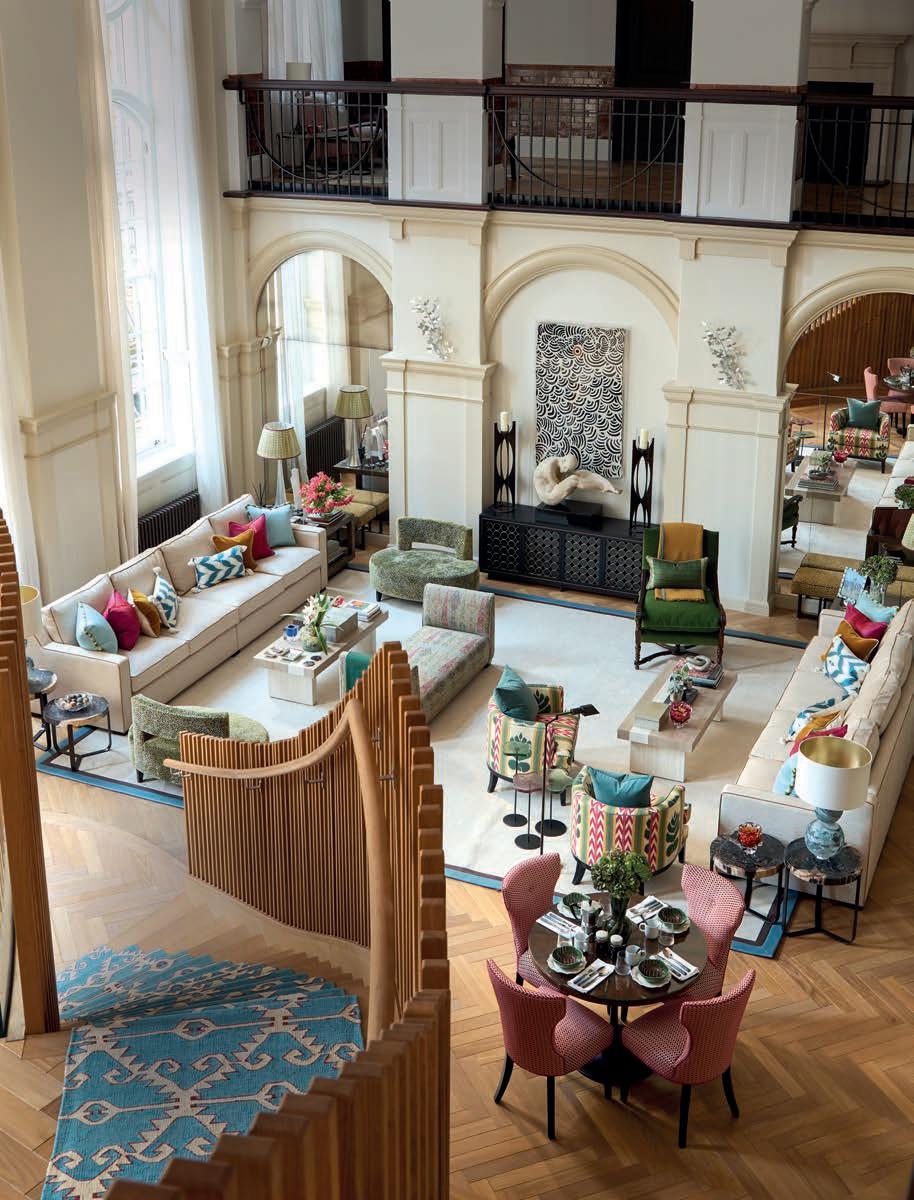

The EDWARDIAN building was designed in 1908 with ceiling heights over 7.5m. The brief was to TRANSFORM it into a COHERENT living space using plenty of COLOUR






When Hattie Hansard of Joanna Wood took on an old school house project, it had been recon gured by an architect leaving a vast white space, the only detail a contemporary wooden staircase. ‘It was a bit daunting when we rst saw it,’ says Hansard. e Edwardian building was designed in 1908, spanning more than 6,000 sq/ft and with ceiling heights over 7.5m. Downstairs is an expansive living, kitchen and eating area with a formal dining space located under the hang of the staircase. Upstairs, a gallery landing leads to three ensuite bedrooms. ‘It has plenty of architectural charm,’ says Hansard. ‘Our brief was to transform it into a coherent living space to maximise the potential for entertaining, using plenty of colour.’
e rst thing Hansard did was to add mirrored glass to two sections of arched wall either end of the living room. ‘Normally, we use mirrors to expand a space but it also creates a cohesion, because as soon as you enter, it allows you to see other parts of the room.’
Much of the furniture is custom-made and because the space felt too immaculate, Hansard was keen to introduce antique textiles. ‘We call it “knocking the starch out”,’ she laughs. e vibrant stair carpet is one such nd, sourced from a dealer in Wembley. ‘I rummaged around the warehouse until I found two the same and our studio’s carpet maker cut and stitched them on the curve to make a runner. We could have gone for something really plain and let the staircase speak for itself but we went the other way and matched statement with statement.’ e colour of the carpet is mimicked in the edging of a huge rug delineating the living area. Furniture includes Tom Faulkner lily pad cocktail tables and two chairs upholstered in a dazzling pink and green fabric by Pierre Frey.
Upstairs the mezzanine was so vast the team introduced a study area. ‘It seemed a waste not to use some of it,’ says Hansard. Each bedroom has its own character and in the ‘best guest’ room, gigantic tulips blossom over the headboard. ‘ e scheme for this room started with a Riviere rug, which the client already owned. e colours are quite unusual and, instinctively, I tend to nish a design with a rug, but that can actually also lead to its own issue. So for this room it was quite fun to start with the oor,’ she explains. e client didn’t want a traditional wallpaper so the studio opted for a tulip design from Andrew Martin. ‘It comes in di erent sized tulips – we plumped for the largest,’ says Hansard. Most of the accessories, including four lampshades which sit at either end of the bedroom – on alabaster lampstands by the bed and orange glass stands on the console opposite – are by Guinevere. ‘We chose to use the same lampshade as there was so much else in the room to attract the eye.’
One of the highlights of the project was sourcing and commissioning the beginnings of an exciting art collection. ‘We curated an array of contemporary pieces in various mediums to contrast with the classic architecture.’ Notable works include the striking blue Arizona Needle sculpture by Tom Faulkner and a series of Aboriginal textiles sourced from Loom Designs Gallery. With its layers of colour, texture and character, this listed school house is a striking lesson in contemporary decorating. n
Home Park, a collaboration between Historic Royal Palaces + GP & J Baker, £189 per roll. gpjbaker.com


HAPPY ANNIVERSARY
Hästens celebrates with the Jack Ryde 100 Year Anniversary Limited Edition 2000T, honouring the man behind the brand’s iconic blue check. The special issue features blue saddle leather details, bronze accents, and a handembroidered signature. From £28,890. hastens.com
LADY LOVES
Nina Campbell's new tiles for Fired Earth draw on travels to India. Cochin in blue, £3.47 each. redearth.com

HOLIDAY VIBE
British Seaside
Delft tiles by Petra Palumbo, £27.50 each. petrapalumbo.com


Balcoon, Patricia Urquiola’s latest bathroom design for Duravit, from £436 at CP Hart. cphart.co.uk





Inspired by Regency-style curves and with traditional spoke wheels, Neptune's new galvanised steel loungers cut a dash poolside. Cheltenham sun lounger and showerproof cushions, £1,850. neptune.com
DESIGN BY
PATRICIA URQUIOLA






Every layer tells a story
Natural colour shades and the layering of materials and textures create a long-lasting, warm aesthetic.
duravit.co.uk

Landscape architect Marian Boswall combines conservation and regeneration in gardens for historic estates, private homes and community sanctuaries as beautiful as they are biodiverse
Like many people compelled to act to protect the natural world, I went through a portal of pain about 30 years ago that created a paradigm shift for me. In the introduction to e Kindest Garden I speak about the deep connection and oneness I experienced one night when I slept outside aged four. I have always loved being outside. When my second daughter died, I gave up a high-powered job as a management consultant to return to that sense of oneness and wonder you can feel in nature, and which I try to bring to every garden I co-create.
I have always gardened organically. As a historic gardens conservation specialist I have a deep respect for the land, for craftsmanship and local vernacular, and my studio works on large-scale land restoration, creating nature corridors and rewiggling rivers. en several years ago I spoke on land energy at a conference and a large-scale grower came to me at the end with tears in her eyes to tell me my talk had deeply resonated. She had her agricultural soil tested every year to measure how much fertiliser to add to raise thousands of hectares of vegetables for supermarkets. is time, the readings said her land was essentially dead. ‘We are growing our food in a chemical soup,’ she said. ‘What do I do?’ I realised
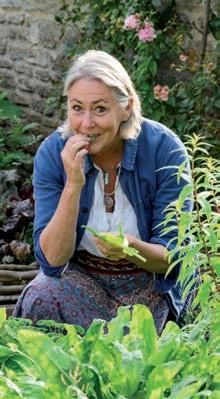
I needed to take a deep dive into soil and the most progressive regenerative growing knowledge to be able to answer her question – and from there to be part of the long-term solution. I spent a couple of years studying with world-leading soil biologist Elaine Ingham, agroecologist Nicole Masters, and talking to people at the forefront of regenerative practices. en I just had to share it.
This time of year it’s all about revelling in the fruits of the land; lots of sitting outside in the evenings or reading under a tree. In the veg garden there are leafy green salads, tomatoes, cucumbers and lots of owers like calendula, borage and nasturtium for salads and teas, and wild sorrel and chicory from the lawn and woods. Weeds like chickweed and fat hen will be added to salads as well as ground elder for risottos, and meadowsweet and wild strawberries for teas and sweet syrupy deserts.
I find inspiration everywhere. Last week I was working on a garden in Braemar, Scotland, and was inspired by the way the water falls and pools around the rocks in the river Clunie. is morning it was the striations of the clouds across the sunrise and the di erent layers of sound between the



nearby wren and the far-o cuckoo. I listened to poet Sir Ben Okri last weekend talk about the way we talk or write in codes and how artists can transcend those codes to share ideas, and thought how that applies to landscape design too.
We source our plants from Palmstead, How Green, Beth Chatto and Hillier, people we have worked with for many years. We love English grown trees for projects in England, so we love using New Wood Trees in Devon. We’ll use Kent Wild ower Seeds and Emorsgate for seeds, and David Austin for roses. A trip to Derry Watkins or one of the specialist nurseries at the Great Dixter Plant Fair (4-5 October) is always a treat to nd something special.
As to my gardening uniform,I am often in my favourite Acre & Holt sleeveless tunic; it is made from natural wool tweed and has usefully reinforced pockets. Designed by Zara d’Abo and woven in a family mill in the Scottish Borders, the tunics are made up in small runs by local seamstresses in a workshop in Frome. e pocket will usually have a copper trowel poking out of it, made by Implementations (implementations.co.uk), based at the biodynamic centre at Waltham Place. My clothes are generally made or found, which often means an Indian sari wrap skirt made up for me locally in Kent or a Nepalese hemp top from Totnes market. Shoes are Vivobarefoot unless I need steel toes.
The first step we can all take towards regenerative gardening is to be kind to ourselves and ditch the comparative mindset and all the excess shopping that comes with it. We can start eating nutrient-dense food, grown or foraged without chemicals – and then use a bokashi bin or wormery to turn the waste food into soil food and then use that to create healthy soil. is soil will hold onto water when it oods, lock up carbon and create healthy plants to support lots of wildlife or be eaten by us again. e microbes in our guts and our soils are very similar, so it’s important to reduce the chemical pollution and plastic put into both.
Introduce pollinator friendly plants to your gardens.Plant families have different shaped flowers that appeal to different pollinators, so I would always choose from a variety of families, which also helps build a resilient ecosystem. Starting with the generalists with their wideopen owers – these are the party owers, with everyone welcome and nectar on tap: I’d have asters or knapweed, and something from the lamiaceae family like marjoram. Umbellifers are also covered in insects in the summer and so add some cow parsley, ammi, angelica or orlaya. And to cater for long-tongued bees and moths who like tubular shapes add clover, foxgloves or honeysuckle.
‘We are growing our food in a CHEMICAL soup,’ she said. ‘What do I do?’ I realised I needed to take a deep dive into the most progressive REGENERATIVE growing knowledge’
When it comes to garden furniture, we tend to seek out ancient troughs and pieces that look as though they have always been there, and love working with Henry White at Reclaimed Design who nds stunning timber or gates that we have used for boardwalks and benches. Sebastian Cox is a favourite for contemporary pieces made from local woodlands; we’ve placed some outside the new winery at Domaine Evremond in Kent. And we love using Edward Bulmer paints as they are very earth friendly and the colours are heavenly.
Take a moment to look at the plants, flowers, insects and birds around you. I am always moved by the way nature shows us that there is always enough – and we just need to trust and learn how to work with it.
e Kindest Garden: A Practical Guide To Regenerative Gardening is out now (£25, Quarto) n





Edited by DAISY FINER

The villas, the yachts, the lifestyle enquiries@fivestargreece.com www.fivestargreece.com





Welcome to the 2025 Country & Town House Wellbeing Guide is year, we’ve curated a celebration of the best in European icons, both old and new. While Asia has long held the crown when it comes to pampering pilgrimages, we don’t always need to travel so far in the quest for rest and regeneration. Closer to home – and without the air miles – Europe’s spa scene is quietly blooming. In fact, I believe the continent is entering a new golden age, o ering one of the most progressive blends of diagnostics, detox techniques and holistic healing available today.
From mountain medi-clinics to regenerative rural retreats, this guide is here to o er direction and discernment for those seeking real health results. Stress, sleep, hormones, overwhelm… we are living through times of profound transition, where we are asked on a daily (or should that be hourly?) basis to process more information than our brains were ever designed to handle. Which of us signed up to be parttime nutritionist and full-time wellness strategist to our own nervous system, while also remembering 72
passwords and keeping up with whether bananas are friend or foe this week? ere’s no o cial opt-out button for multitasking – which is why we need to create our own.
e call to press pause and nourish our deeper selves has never felt more urgent. We don’t need trends: what we crave are holistic, realistic and grounded approaches to wellbeing that can actually t into our lives. ese icons deliver just that. ey are inspiring sanctuaries for those seeking balance, vitality and new ways to be. We know because all have been tried and tested by our close-knit team of experienced writers. Whether you seek restoration, transformation or simply space to breathe, these are the places we trust. e ones that stay with you. e ones where a quietly powerful human touch o ers an antidote to the digital age. AI couldn’t make them up. And for that, we are so grateful.


is game-changing Greek retreat is tackling emotional health through a brilliantly balanced East meets West approach, blending heart-nurturing practices with a scienti c outlook. A focused programme was just what I needed after a few hectic, rollercoaster months. An initial consultation revealed that my earth element was unbalanced: according to Traditional Chinese Medicine, this can show up as worry and anxiety –exactly how I’d been feeling. Cue a stress-releasing ve days in the luscious Peloponnese countryside, lled with deep meditation, nurturing aquatic massages and neuro-fascia release treatments designed to ease tension stored in the body’s connective tissue. But what stayed with me most was the emotional release work with head therapist Vladia, who blends movement science and visualisation techniques to uncover and unlock trapped emotions through targeted massage. It was surprisingly powerful and left me feeling so much lighter. e healing Kneipp path and the serenity of oating in the indoor-outdoor pool, with its backdrop of pine trees, added a further sense of calm and restoration. e Byzantium-inspired bedrooms are super comfortable and the Mediterranean food exquisite, using local produce to create the likes of shrimp mille-feuille and octopus risotto. Overall, this is a beautifully curated reset – and a powerful reminder that true emotional harmony begins with reconnecting to your true self. Harriet Compston BOOK IT: Five-day Emotional Harmony programme from €2,000 inclusive of 17 treatments, plus accommodation from €374 per night B&B. euphoriaretreat.com
THIS IS A BEAUTIFULLY CURATED RESET – AND A POWERFUL REMINDER THAT TRUE EMOTIONAL HARMONY BEGINS WITH RECONNECTING TO YOUR TRUE SELF
LAKE GARDA, ITALY
Letting go of emotions, people and concepts is easier said than done. As someone who struggles to surrender control and accept life as it comes, I went to Lefay eager to nd out if it could soften my grip. e new three-day Letting Go programme, rooted in Traditional Chinese Medicine, promises to restore your ability to go with the ow. First on the agenda was the Prima di Vera ritual, an energising body scrub designed to open meridians and dissolve emotional blockages. A breathwork session followed, which revealed how shallow breaths trap tension while deep, diaphragmatic breaths release it. Next was a combination of massage and guided meditation to ease overthinking. With mind and body more open, I wandered the herb garden, had a cooking lesson with what I found, and hiked along the lakeside, experiencing what Lefay calls a ‘return to wonder’. en, the nale: water shiatsu. Floating in warm salt water, I felt I had surrendered to what Lefay was trying to achieve –no resistance, just a freer version of me. I emerged lighter, accepting that holding onto negative emotions only weakens my ability to embrace and enjoy the here and now. Note to self: stock up on bath salts – they might just keep this feeling alive. Camilla Hewitt BOOK IT: ree-night Letting Go programme from €1,370, inclusive of all treatments and meals. lefayspamethod.com.

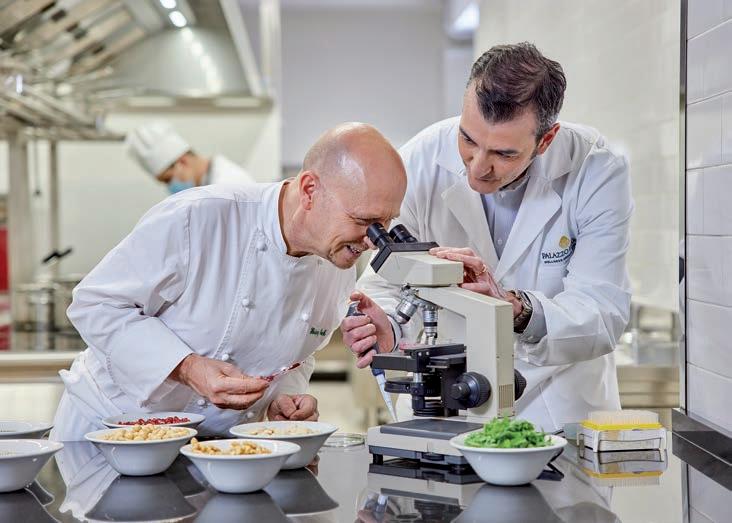
If you thought modern spa food equals the ubiquitous chicken quinoa salad, then you haven’t come across Heinz Beck. If a foreign cook can please the Italians, that’s saying something. is German-born chef runs the only three-Michelin-starred restaurant in Rome – La Pergola – which has been going strong for over 30 years. He’s also the maestro behind the superlative food at Palazzo Fiuggi, a results-driven medi-spa just over an hour’s drive from Rome. I tried the Optimum Weight programme, designed to encourage sustainable healthy eating instead of the feast-famine yo-yo ride. I was surprised to discover that a seven-night stay of measured, regular meals left me 3.5kg lighter, despite the lack of starvation (maybe even because of it).
Days are punctuated by u y breakfast omelettes, well-timed fruit smoothie snacks, seed-packed salads sprinkled with pomegranates and deeply avoured soups. ink cream of borlotti bean with goji berries and pumpkin seeds. ere’s always enough protein to keep you energy-fuelled: chicken breast with parsnip puree and basil sauce, veal carpaccio with pesto and redcurrants. Everything comes with a surprise factor. Turbot is served with a nashi pear infusion. Minestrone with spicy pu ed rice. It’s a melodious adventure that leaves taste buds humming – and, blissfully, lunch and dinner are both two courses. By chance, Beck happens to be at Palazzo Fiuggi during my stay. As soon as I meet him, I feel I am in the presence of a genius. It takes a certain kind of brain – and heart – to not only cook with wild invention, but to care enough to work out and chart the quantity, calories, proteins, fats and minerals of every mouthful being served to every guest on every
di erent programme. e calorie count of your meal plan is listed every day and is meticulous: 1,239 calories one day (with 78g of protein), 1,242 calories the next (with 77g of protein). ‘It’s not only about the creativity of the food, the knowledge of the avours and knowledge of the ingredients. Behind what we are doing, it’s really structured. Nothing is improvised,’ Beck says. ‘I know everything about what we are doing here. Everything.’ I believe him.
Way before Tim Spector, there was Heinz Beck. For 25 years, he has been studying the nutritional impact of food – including research in 2006 into the oscillation of insulin in the body after eating. He is now the only professional chef to contribute to Nutrients, an American medical scienti c journal. Its researchers are currently exploring oxidative stress in the body after eating. ‘ is is really important because we all have low grade in ammation, and we have to keep it on a low level because it’s responsible for most cancer cells,’ Beck explains.
e anti-in ammatory menu at Palazzo Fiuggi is the result of over 1,000 recipe testings that Beck undertook during Covid. No red meat, sugar, salt or alcohol is used. Everything is ‘ buono ma pochino’: good, but small. at, however, is no re ection of Beck’s mission. Next, he’s jumping aboard Orient Express to oversee menus for six of its trains – with 12 di erent itineraries – as well as ve of its hotels, all in Italy. ‘Bravo’ doesn’t really cut it. Daisy Finer
BOOK IT: Seven-night Optimal Weight programme from €4,950, inclusive of all health assessments, medical and wellness treatments and food and drink. palazzo uggi.com
It’s my great fear; the health hazard we all rightfully dread. Dementia. Scientists’ once broadly-upheld theory about its cause – amyloid plaque on the brain – has been shaken by autopsy research, showing that although many brains of those with dementia do display excessive amyloid deposits, many don’t. Bleakly, once you’ve got dementia, that’s pretty much it.
Grim, huh? at’s why I’m at SHA, the ultra-advanced Spanish medi-clinic aiming to stay at the cutting edge of global health research. In its cognitive health department, Joaquín Juliá Salmerón – warm, bearded, 51 – is the resident neuropsychologist.
‘Dementia has no cure. at tells us to focus on prevention,’ says Salmeron calmly. ‘When neurons – brain cells – die, the functions they provide disappear. at is, however, usually a gradual process that can start 20 years or more before dementia becomes evident. So it is never too soon for new habits to keep your brain healthy.’
SHA’s cognitive boost programme – combining ‘science and technology to assess and enhance mental performance’ – is punctuated by truly fabulous food and time to lie on the huge terrace drinking in the views of mountains and sea. It starts, rather unnervingly, with an online cognitive test: memory puzzles, pattern recognition and so on. (‘No one ever gets 100 percent,’ the therapist reassures me.) Health, functional and bioenergy assessments follow, plus cryotherapy, ozone therapy, acupuncture and yoga. During the Icaros session, I lie spreadeagled on the machine, put on a VR headset, and am exhorted to ‘ y’ through rings on a simulated mountain valley oor using hip movements. (No chance. Can’t stop laughing; don’t care.)
Best is the hour with Salmerón, which includes a transcranial electrical stimulation (tES) session. First, I take the Montreal Cognitive Assessment (30/30, hurrah). en – big excitement – Salmerón ts a grey rubber tES cap with sensors onto me, which he often uses daily on himself or his wife. It leaves me jubilant with energy and enthusiasm. (Easy to see why tES has proved e ective on depression.)
ose crucial new habits to keep your brain healthy? Don’t smoke, drink minimal or no alcohol but plenty of water, get plenty of sleep and exercise and consult the website Food for the Brain on what to eat. Avoid plastic. Chillingly, one study has found the amount of microplastics in the brain tissues of people who died in 2024 (7g in some) was generally double that found in the tissue of people who died in 2016. ‘Don’t buy, microwave, consume or store food or drink in plastic containers,’ Salmerón warns.
Avoid statins, too. ‘Statins reduce cholesterol – and a fth of the brain is cholesterol.’ he explains. Ensure you get into sunlight every morning to enhance immunity-boosting vitamin D and improve sleep. And increase your neural pathways by learning, doing, reading or listening to something new every day.
‘Look after your brain as well as you do your body. Better, even. Future you will thank you,’ Salmerón says. Agh. Please, God. Adriaane Pielou
BOOK IT: Cognitive Boost pack from €1,350 inclusive of all treatments, plus accommodation from €500 per night. shawellness.com
‘LOOK AFTER YOUR BRAIN AS WELL AS YOU DO YOUR BODY. BETTER, EVEN. FUTURE YOU WILL THANK YOU’



for...
My face is being blasted by ultra- ne jets delivering a cocktail of active ingredients deep into the dermis at speeds of up to 720km/h. JetPeel may feel like the beauty equivalent of a car wash, but I know the results will be worth it. ‘It’s like a mini lift,’ beams the therapist. is new non-invasive treatment is designed to bridge the gap between Villa Stéphanie’s traditional spa and its renowned medical centre, a Harley Street-like tardis housing assorted medical, dental and aesthetic practitioners. Headed up by preventative medicine titan Dr Harry König –whose advice Victoria Beckham describes as ‘life-changing’ – Brenners Medical Care combines holistic therapies with advanced diagnostic techniques. Most popular are the weight loss and detox programmes with nutritionists on hand to create tailored menus. Relaxation, though, is key – as it has been since stately Brenners was at the epicentre of 19th-century high society life in this historic spa town. e hotel’s Beaux Arts-era annex, Villa Stéphanie, is its jewel: residents are made to feel totally at home (Frau Beckham included), and encouraged to pad around in slippers and a bathrobe. Take a hike in the nearby Black Forest or simply stroll in the private gardens, which run alongside the famous Lichtenaler Allee. I left feeling lighter and calmer – and believing I can tackle any kind of mountain. Juliet Herd BOOK IT: Programmes are bespoke with prices available on request, plus accommodation from €400 per night. oetkercollection.com
I LEFT FEELING LIGHTER AND CALMER – AND BELIEVING I CAN TACKLE ANY KIND OF MOUNTAIN
MARIA WÖRTH, AUSTRIA
Does the Mayr Cure work? I’d heard about the previously unknown cancers that are often detected here by the doctors (skin and bowel are the most common), and the miracle babies conceived shortly after a stay. For some, arthritis eases. Others give up sugar. For me, a stay here was the ultimate mind-body booster. We now understand that gut health goes far beyond digestion: often called our second brain, the microbiome plays a crucial role in everything from skin and immunity to mental health. In fact, 95 percent of serotonin is produced in the gut. So, it’s no surprise that by the time I nished a week-long stay at Original Mayr, I was high on happiness. Daily Epsom salts, comprehensive blood tests, vitamin drips, superb treatments (don’t miss the extraordinary Ortho-Bionomy with Bernhard) and natural, alkalising food leave you not only lighter on the scales, but energised and glowing from within. It’s as if a powerful vitality switch has been ipped. ose morning dips in Lake Wörthersee – one of the purest in Europe – are uplifting for the soul; the sleek beach house and jetty are wonderful places to decompress with nature wrapped around you. ere are other Mayr outposts, but the original (it opened in 1976) remains, in my experience, the blueprint best. DF BOOK IT: Seven-night Detox and Gut Health programme inclusive of accommodation from £4,810. original-mayr.com
for... A GUT MAKEOVER
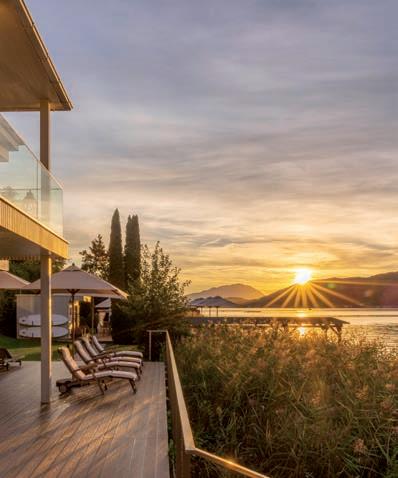
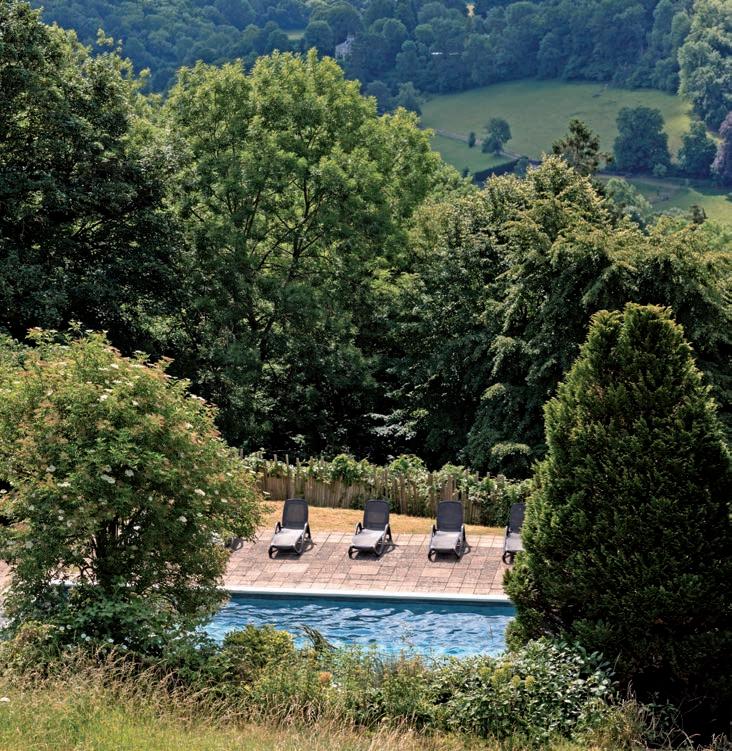
NEAR BATH, UK
ere’s one crystalclear goal at the UK’s most results-driven wellbeing destination: improve metabolic health. Achieve that, and pretty much everything else falls into place: blood pressure lowers, fertility rises, type two diabetes can be reversed, menopause monsters and sleep demons tamed. Weight automatically normalises. I always thought my lifelong battle with the scales was down to weak willpower and greed, but at Combe I’m told it’s not my fault – I have an addiction to sugar. is requires a complete overhaul of my relationship with food. Sugar and starchy carbs are out, but there’s no depressing deprivation. e high-protein diet is delicious and plentiful. I eat way more than I would at home and still lose weight (it feels like a miracle). No wonder I keep returning, and every time I do I feel my spirits lift and my stress levels dive. e 18th-century manor with its nature-chic rooms and woodland walks is magical. Treatments are superb, the diagnostics incisive. Optional consultations with medical gurus – such as menopause whisperer Juliet Balfour – add nuance. Game-changing? Yes. For some, potentially even lifesaving. Return home feeling inspired and determined, knowing you can boomerang back for the inclusive three-night follow up. Clever. Jane Alexander BOOK IT: Five-night Metabolic Health programme, inclusive of accommodation, treatments, meals, tness facilities and a three-night returner’s retreat at 12 weeks. Early bird spots from £2,600. combegrove.com

When Hans Jürg Bu discovered that his 82-year-old mother was being prescribed 18 standardised pills a day by her doctor, he decided to take matters into his own hands. Rejecting the pharmaceutical approach, he curated a regime of natural supplements and took over her care himself. She went on to live two years longer than predicted by a cancer diagnosis – something Bu credits not only to alternative therapies, but to the power of personalised, preventive health.
His passion for this pathway sparked the hugely ambitious vision for BUFF – a brand-new medi-clinic on the sunlit shores of Lake Constance. No newcomer to hospitality, Bu owns six boutique hotels under ‘ e Swiss Mountain Hotel Group’. He is also a father to eight children, several of whom now work alongside him – ensuring that BUFF remains an almost patriarchal family a air. e aim? To seamlessly blend ve-star service with cutting-edge diagnostics and holistic therapies. e foundations of this project stand solid: rooms are slick serenity (although I did nd myself wishing I had a degree in electronics just to turn o the lights) e food and gut-focused philosophy are FX Mayr accredited and you can opt for spartan fasting or for the GourMED menu, where I was surprised to discover roast potatoes are allowed, alongside sh from the lake, beef brisket, or beetroot and goats cheese salad melodies. ere are some highly specialised wild-card doctors in place. With a focus on health-span rather than lifespan, their areas of particular expertise include heart health, digestive health, metabolic and muscle health and hormone health. O erings also include postural and gait
analysis. If it’s discovered that you need insoles, they’ll apparently be made bespoke overnight.
And yet, BUFF is more than a clinic – it’s one man’s bold, nearobsessive statement to the world. Rooms have been engineered to o er adjustable altitude simulation – up to 4,000 metres, in order to stimulate red-blood-cell production and enhance cellular regeneration. (At soft launch, the system is temporarily o ine, but Bu insists he holds the patent for the necessary x.) ere’s also a bulletproof presidential suite with its own car park, a gold-leaf ceiling above the indoor swimming pool, and a private cardio MRI. ‘ We are the only ones in the world to have this,’ says Bu . ‘Our approach is to treat, teach and care. e pharmaceutical industry makes people dependant. We try to make our guests independent, so they can take responsibility for their own health.’
Cardio care is a strong focus. I’d never experienced a heart ultrasound and was relieved to discover all was normal. ankfully, a di erent kind of heart medicine is also available. Healing hands deliver exceptional treatments with real intent, from Ayurveda, outstandingly intuitive osteopathy and re exology to a Team Dr Joseph facial – an organic, biodynamic ritual rooted in the Alps. I’m not sure if the neck massage was part of the protocol or if my therapist was simply responding to what my body asked for. I oated out wondering if maybe, just maybe, Bu is onto something. DF
BOOK IT: Seven-day Bu Med Vitality erapy €3,400, plus accommodation from €940 per night. bu -medical-resort.com




The Mayr Method may dominate Austria, but Mount Med Resort – which opened this year in the sleepy alpine Wildschönau region – takes a very different approach. The clinically tested, scientifically stringent Mylife Changer method is designed to reduce biological age and support long-term health and wellbeing without even a whiff of deprivation. The alpine-luxe interiors feel like a hug and everyone is kindness incarnate (though Google Translate may come in handy). After a week’s stay, I left lighter (by seven pounds), younger (by five years) and without the chronic back pain that has plagued me for the last three years. No cranky diets here – just sublime food. Orthopaedic consultant Dr Stephan Papp packed me off for an MRI and then prescribed laser therapy, plus Emsculpt and Emsella sessions to strengthen small muscles in my back (pleasant side effects included tighter abs and a perky pelvic floor). Meanwhile, longevity guru Dr Alexander Papp (yes, they’re brothers) is everyone’s dream GP – erudite, kind, funny, stern when necessary. Smart diagnostics, high-tech biohacking alongside superb bodywork, immersive sauna experiences, an indoor-outdoor pool with mountain views: Mount Med has the lot. It’s an icon in the making. JA BOOK IT: Healing Holidays offers a five-night Quick Prevent programme, including transfers and full board, from £3,299. healingholidays.com. mountmedresort.com
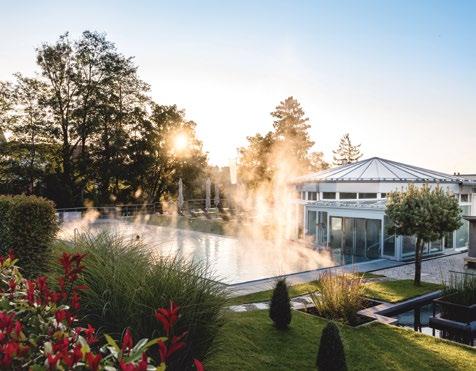
If therapeutic fasting has a spiritual home, it is here, above the still waters of Lake Constance. Founded in 1953 by Dr Otto Buchinger – a naval doctor who healed his rheumatoid arthritis through fasting – this family-run clinic is quietly rigorous and backed by decades of medical research. I arrive frayed at the edges: too much travel, too much peanut butter, mind in a frenzy. I’ve fasted before, but never like this. There are no juices here, no fancy nut milks or cold-pressed promises. Just the warm elegance of apple-skin tea (so good), the odd medicinal spoonful of honey and perfectly clear vegetable broths. Somehow, it is enough. In fact, it’s astonishing how I never feel hungry despite a purely liquid diet. Days fall into a reassuring rhythm: medical consultations, liver compresses, gloriously relaxing holistic treatments, lectures on the benefits of fasting (increased endorphins and immunity). Unmissable daily walks through forests that smell of pine and possibility. The whole experience brings me closer to my inner self. Indeed, there are times when it feels like the noise of the world, and the film inside my head, have gone quiet. Some nights I have dreams I want to remember. Less really is more at Buchinger. In the end, it’s not about deprivation, but illumination – a clearing of physical and mental clutter. Experience a deep, cellular exhale. A remembering of what it feels like to be well. DF
BOOK IT: Ten-day Compact fasting programme inclusive of accommodation from €4,078; three-night non-fasting Relax stays from €1,356. buchinger-wilhelmi.com
IT’S NOT ABOUT DEPRIVATION, BUT ILLUMINATION – A CLEARING OF PHYSICAL AND MENTAL CLUTTER
I’m swimming straight into the sun at Lanserhof, surrounded by meadows and mountains, steam rising off the outdoor pool, blue skies ahead. This place is not what I expected. I had imagined a sci-fi medical clinic where the uber rich come to chew their way into Barbie-thin versions of their former selves. But while the Mayr Cure is in full swing, the atmosphere here is far softer and more inclusive than I had assumed. The medi-spa smells of palo santo, there are hot water bottles in my room (for liver compresses) and within minutes my doctor, Dr Dinah PutzGergely, is advising me that ‘the breath is serotonin’. We talk about mantras, and she recommends a session with the in-house shaman, Leo, who purifies my aura with a smoking totem. I expected to leave with a clean gut – I wasn’t anticipating a return to my soul self. Putz-Gergley’s advice also includes four solid life rules. No snacking unless it’s protein (dates with almond butter are out). No meat in the evenings; fish or soup are far more digestible. Eating early is also encouraged, or alternatively: ‘cancel dinner’. And lastly, no wheat. ‘Read The Wheat Belly,’ she advises. I leave Lanserhof truly inspired, a new routine in hand. I had thought the measure of a good time here would be balanced purely on the scales. But I felt lighter in body and spirit, and that was enough. ‘I am enough’ is the mantra we all need, Putz-Gergely and I concluded. DF BOOK IT: Healing Holidays offers a seven-night Cure Classic programme from £4,599pp. healingholidays.com. lanserhof.com

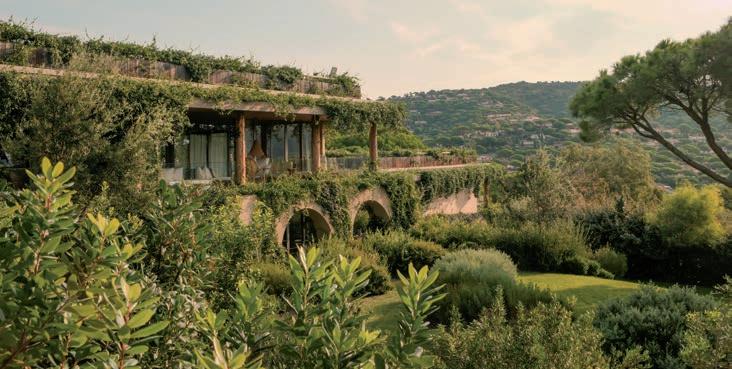
‘Mediterranean longevity’ is the goal at this newcomer in Spain, where terracotta rooftops and olive trees meet a cutting-edge medi-spa, and deep relaxation goes hand in hand with serious diagnostics masterminded by 25 specialists. After extensive tests, I follow a highly personalised programme that oscillates between clinic and spa. I have my rst colonic; after a great massage, I lie like putty in the physiotherapist’s (gigantic) hands; an Emsella chair rolls electromagnetic waves through my nethers – part of the gynae-led Intimate Boost, as while I have no ailments down there, I’ve had four children. I learn I have a metabolic age of 29, a wellness age of 40, and a skin age of 51 (I am 44). I detox my organs in the MLX i3Dome (which is like lying in an infrared co n with my head in a space helmet lled with plasma and oxygen) and sleep through a dry oat session, cradled in a womb-like waterbed. ere’s more: laser IV drips; longevity testing with a geneticist; the food – anti-in ammatory, Mediterranean, delicious, with 75 percent sourced from ZEM’s own nca. I’m allowed co ee and I see one guest having (sshhh) wine. is newbie is still nding its feet, but I leave retuned, informed, and with a much-tightened pelvic oor. Lucinda Baring BOOK IT: Seven-night Essential programme inclusive of accommodation, spa access and full nutritional plan from €10,800. zemaltea.com

Upon entering the grounds on a cool late summer’s day, it isn’t the meditative thrum of a gong bath or an ‘om’ that greets me, but the roaring purr of a vintage Porsche and the re ned yap of a prize-winning chihuahua. Lily of the Valley is everything you want rolled into one. Housing some of the most cutting-edge treatments in the South of France, it is known for its detox and better ageing programmes. Alongside this, it o ers one of the most exquisite low-calorie menus (I still dream about my morning turmeric omelette with garden veg). For non-dieting pals –and sybaritic locals or holidaymakers – the wine list stretches all the way to a 2005 Le Pin. e 2,000 sq/m spa is also to be taken seriously. After a consultation, I begin a bespoke three-day programme of high intensity exercise, treatments such as Indiba body sculpting for weight loss, and drop-in classes including the rather eccentric but circulation-boosting sea wading (I choose to take the coastal path for a lung-blasting ramble on an eiderdown of pine). Philippe Starck-designed warm white rooms with wooden accents make it one of the least institutional retreats. If you are the type who needs thimblefuls of broth with no other temptations, this is not the place for you (the regular menu features the full gallic spread, from caviar to cognac- ambéed beef). But where else can you seamlessly mix mobility training with Montrachet? I raise a glass to that, even if it is just Voss Gazeuse. Jemima Sissons BOOK IT: Four-day Discover detox programme €2,500, plus accommodation from €450 per night. lilyofthevalley.com
WHERE ELSE CAN YOU SEAMLESSLY MIX MOBILITY TRAINING WITH MONTRACHET?
Best for... THOSE SEEKING A SLEEP GENIE

It’s the food I’ll miss most. Even if I hadn’t had a wink of sleep all week (more on that later), the daily 850 calories are so cleverly calibrated that each meal brings a quiet joy. Yes, you’re fasting (and yes, you lose weight, I promise), but it’s a feast of avour and imagination. Not a dash of oil, a morsel of meat or a lick of dairy has touched my tongue, but yet, the ingenuity and beauty of this vegan cuisine has to be seen to be believed. ink unctuous aubergine parmigiana made with macadamia nut cheese, or the daintiest starter of amaranth and blueberry in a coconut and lemongrass emulsion. And this is just the gurative icing on the cake (god forbid there’d be real cake) of the detox bubble that makes Chenot Palace, overlooking glittering Lake Lucerne, such a cosseting treat.
Despite e White Lotus vibes (this place attracts the global elite), the palace oozes taupe-coloured calm, all wrapped up in an obviously slick and sophisticated operation. I’m here to sleep – or, at least, as Dr Fee points out, to give myself seven days to recharge and energise my cells and learn that rhythm and repeat is the best tool for a good snooze. It begins in the bedroom – one of just four specially designed for optimal rest. At night, it’s set to a cool temperature (heat is not your sleep friend) and I slip into freshly laundered PJs and sheets which keep my temperature regulated throughout the night. Just before bed, I press the digital panel on the wall and a nature-inspired light and sound show plays, lulling me into a calm, natural state before I pop on the (extra blackout) eye mask and waft o to dreamland (ideally). Come morning (the system is set to go o at 06.30), birdsong and warm pink light rouse me to a calm waking. I’m encouraged to get up and ing open the windows for that rst burst of light before heading
out for a morning walk along the lakeshore heading – explicitly –towards the sun.
is ritual kick-starts your ‘sleep pressure’, says Dr Fee, with the whole programme designed to build it up throughout the day. Cryotherapy rst thing (three minutes at -110°C, survived by ailing and singing wildly) gives you an electric jolt of energy and lowers core body temperature –another tick for sleep. e rest of the day is busy in a lying down being pampered sort of way, with a raft of treatments that optimise cellular function and calm the parasympathetic nervous system. ere’s neuroacoustic therapy (headphones + rhythmic frequencies = dreamy state), acupuncture and even photobiomodulation, which is like a sunbed without the damage – red LED and laser lights reduce in ammation and help cells repair.
e sciencey bit about sleep is that as your body uses energy during the day, it creates adenosine, a chemical that signals tiredness. Sleep clears it, and the cycle starts again. e better your cell function, the better your adenosine build-up – and the better your sleep. Sluggish cells therefore equate to sluggish sleep.
So yes: it comes down to routine, light exposure, movement, good food and serious rest. Simple in theory, tricky in practice – which is why coming to Chenot and its warm embracing arms, epic treatments (the to-die-for daily massage comes as standard), supercharged tech and excellent, empathetic doctors might just be enough to scare the sleep monster away. Or, at the very least, give you the tools to try. Lucy Cleland BOOK IT: Seven-night Sleep Cycles programme from £7,150, plus accommodation from £368 per night. chenot.com

ROUTINE, LIGHT EXPOSURE, MOVEMENT, GOOD FOOD AND SERIOUS REST. SIMPLE IN THEORY, TRICKY IN PRACTICE

It’s true to say the Grand Resort Bad Ragaz is built on water. More speci cally, it was founded on the healing properties of the thermal springs that bubble from the nearby Tamina Gorge at 36.5°C. With 12 di erent pools to choose from, including the magni cent Tamina erme public thermal baths (free for hotel guests), you’ll nd yourself water hopping all day – and wishing you were a Swiss local, so wholesomely do they appear to embrace this natural treasure. It’s no wonder these restorative waters are integral to the resort’s wellness packages, medical services and even gastronomy (the Michelin star tally is an astonishing six). ‘You don’t need Botox – just water,’ declares sommelier Stephanie Mieth during our aqua tasting (yes, really), explaining that the unique mineral composition and temperature help to stimulate metabolism and improve blood circulation and heart function. Traditionally known for its rehabilitation programmes, the medical centre is pivoting to a more preventative approach with longevity at its core. Healthy living seems easy when you’re surrounded by the verdant hills of Heidiland. I power along the Rhine on an electric bike before veering o to explore bijou vineyards and villages – but nothing beats the feeling of bliss that comes from oating in the thermal garden pool, the late afternoon sun on my face. JH BOOK IT: Two-night Pure Relaxation package inclusive of accommodation, breakfast, treatments, tness classes and spa access from approx. £1,180. resortragaz.ch
FLOATING IN THE THERMAL GARDEN POOL, THE LATE AFTERNOON SUN ON MY FACE – PURE BLISS
MERANO, ITALY
is Belle Époque beauty has risen triumphantly through di cult times, including the passing of its legendary founder Henri Chenot – king of Italian detoxing – in 2020. Now under new ownership and with Dr Massimiliano Mayrhofer at the helm, everything that once de ned Chenot has been newly remoulded into the Revital Method. It’s 14 years since I last visited; I barely recognise the interiors or the vibe. Old-world glamour sits alongside upbeat contemporary cool, inclusive of serene garden spaces, the top-tier medi-centre and the beautifully revitalised spa. e new Sport & Recovery Lab o ers technologically prompted memory tests as well as performance and posture assessments for everyone from athletes to your granny. But it’s the integrity of the original detox philosophy – where Traditional Chinese Medicine meets modern diagnostics (blood and bone density tests are standard) – alongside the expert delivery that wins my heart. Most sta have been here for decades – and their advice and empathy is as bene cial as the delicate plant-based meals. Daily hydro-mud therapy, incredible cupping massages and electric acupuncture lull my racing mind into blissful submission; my body follows suit. Bioenergetic testing shows my energy has more than doubled on departure. ‘Breathe, dance, catch yourself a boyfriend,’ my doctor says. Alright then. If the palace can reinvent itself, then surely, so too can I. DF BOOK IT: Four-day Detox & Longevity programme from €5,349, inclusive of accommodation and treatments. palace.it n


Where London comes to unwind: inside Kensington’s serene spa
Your Bayou journey begins from the moment you pass its doors. A secret garden in the heart of Kensington, this jewel-box spa centres around nature in its restorative programme and is a rising destination for a loyal London clientele and growing guest base.
Bayou Spa’s philosophy is all about reestablishing harmony in your life, as well as providing a personalised approach to preventative health. Expert therapists achieve accessible, wellness-driven results through use of carefully selected natural products and contemporary wellbeing practices. Each treatment begins with a one-to-one consultation and ends with expert advice for skin, stress and lifestyle support, bringing together an integrated collection of holistic services that provide a unified approach to both health and beauty.
Treatments at Bayou Spa include a range of massages, rejuvenating facials, body therapies, and deeply restorative holistic rituals, prioritising longevity, balance and beauty that goes beyond the surface. Regular wellness workshops and brand partnerships make Bayou Spa a rising destination for savvy Londoners.
67 Kensington Church St, W8. bayouspa.com


Introducing new tiered pampering packages
Our new packages offer a curated wellness escape, combining results-driven facials, therapeutic massage and beauty treatments, all in one visit. Every detail of your day is designed to soothe the nervous system and elevate everyday wellness, from lymphatic massage to deep-cleansing facials, accompanied by relaxing with herbal teas and fruit platters.
Bayou Balance Package: A 30-minute massage and 45-minute facial, £114.75. Bayou Signature Experience Package: A 60-minute massage, 60-minute facial, fullbody scrub, luxury manicure & pedicure, complimentary teas and fruit platters, £290.40.
Scan the QR code to receive 50 percent off all Bayou Packages using the code C&TH and step into a sanctuary of holistic wellness tailored to your personal needs






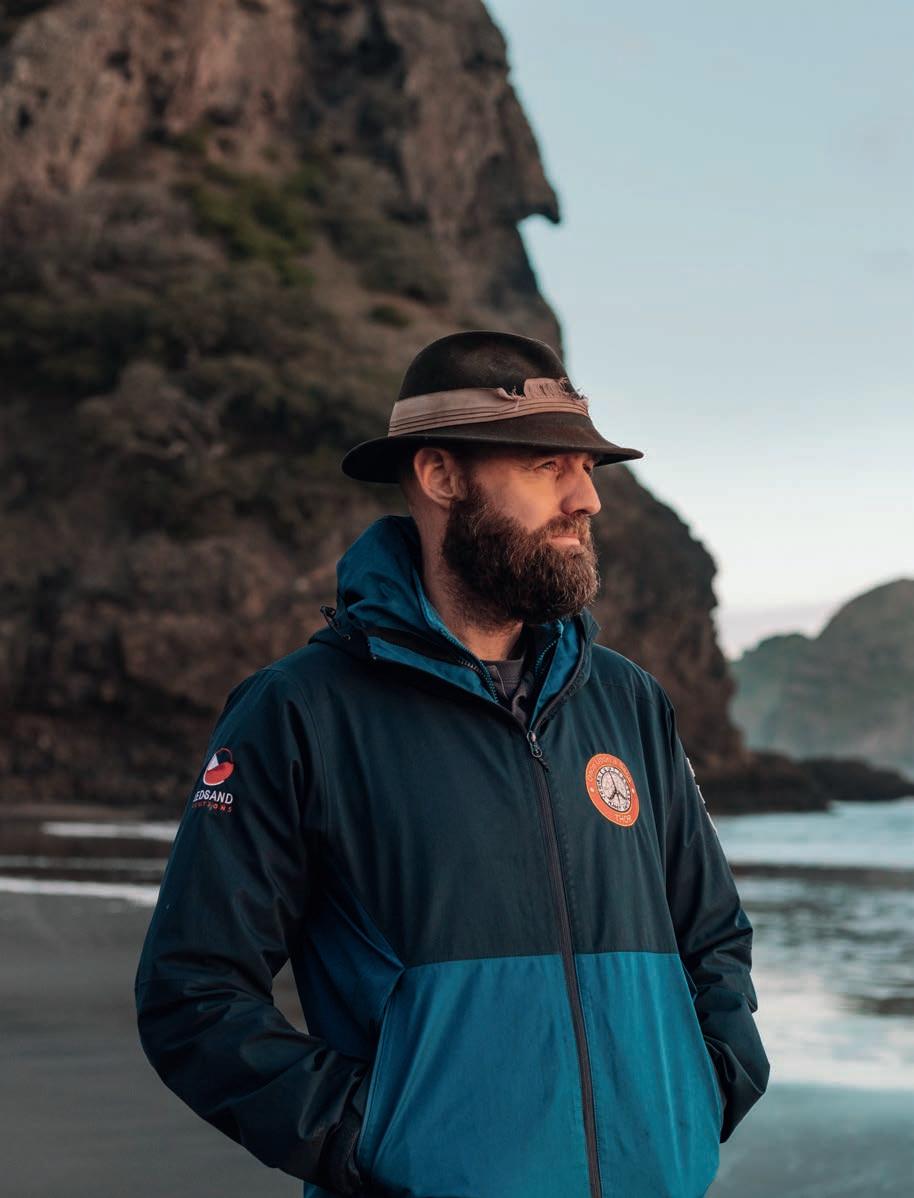
3,576 days
Thor Pedersen made an impossible journey – travelling through every country in the world without flying. He tells Katie Scott how it became a pilgrimage of people not places
Thor Pedersen would be the rst person to tell you not to do what he has done. is tall, quiet Dane now holds the title of being the rst person to have travelled continuously through every country of the world without ying. And it nearly killed him on more than one occasion. It also took him close to a decade.
His newly published book isn’t a gallop across the world. It doesn’t read like a list of sights seen or a tick-box exercise. e book doesn’t document every country – that would take tomes. It does record a logistical feat beyond comprehension for most of us – and a journey that pushed Pedersen almost to the edge of sanity.
When I speak to Pedersen, he’s apologetic. ere is a thrum of American voices around him. He’s travelling again – a road trip across the US – and is trying to nd a quiet corner in the World of Coca Cola in Atlanta, Georgia to talk. Curious tourists in baseball caps occasionally appear behind him on screen as Pedersen recounts the moment armed (and drunk) soldiers waved guns in his face at a checkpoint in Central Africa.
On this trip, Pedersen isn’t alone. Just before he logs o , I say hello to his wife, Le, and he proudly shows me his baby daughter. Le is one of the only constants in the book. ey met at a wedding just before Pedersen left Denmark, and she visited him, buoying him, when his itinerary allowed. e prospect of losing her sinks him deeper into despair during his moments of visceral doubt. When he nally came home, Le helped him adjust to life in Denmark. ‘I think I might be the kind of person who is always in doubt about who I am and what my place is. I might spend the rest of my life looking for something. Becoming a father has given me identity in a di erent way and I’m living with a wonderful woman, my wife, which has also given me an identity.’
Pedersen writes about how he set out to court glory, like the explorers he read about as a child. He’s become a member of e Adventurers’ Club in Denmark, but the book has yet to be published in his home country, which hurts him. roughout the trip, he didn’t get the accolade he dreamed of; there were no crowds of fans clamouring for his time at every country border. Even his return to Denmark – after ten years of travel – feels at. ‘I felt no major wave of happiness,’ he writes. e quest for glory fades though Pedersen’s competitiveness remains – it’s hardwired into him. But, as he moves through the 203 recognised and partially recognised states listed by the UN, it’s the people who show him kindness that give him the strength to keep moving. ‘Quickly, I understood that countries are nothing without the people that live in them,’ he writes. Even messages through social media provided strength when he faced constant derision, especially from authorities. ere was the woman in Suwalki in Poland, who invited him into her home as he wandered the snow-covered streets with no phone coverage, no idea which direction to walk in and a storm threatening. e friends that he made in Hong Kong, where he was trapped because of the pandemic, not only found him a place to live and a job but walked with him as he explored the mountain trails to calm his mind.
e book documents what blew away his preconceptions, even as a man who’d travelled widely before he started on this quest. As a UN peacekeeper, Pedersen was posted to Eritrea and later worked in Libya for a shipping and logistics company. People still surprised him, especially in war-ravaged countries. ‘A lot of these places, they do not expect a tourist. It brings hope and suggests, perhaps, we’re going back to normal times,’ he tells me. ‘In Herat, this old man asked me to come with him and took me straight to this tree. We went through a maze of buildings and he explained that this tree was almost 1,000 years old. He then told me that what I know of his country is just its 40 years of war.’ ere are moments of sheer terror and despair too though. is isn’t a saccharine ode to the beauty of human nature. ere were countless embassy sta who viewed Pedersen with absolute disinterest, bordering on contempt, especially because he was refusing to travel by plane (and therefore ungratefully bypassing the expensive border facilities they had put in place at their airports). His run in with malaria nearly cost him his life. A walk down a beach in Lebanon saw him come across the bodies of four immigrants, and that night he could hear the bombs destroying communities just 20 minutes from where he lay. e book shares the many moments where Pedersen not only questioned why he was pursuing this challenge but was consumed with the fear that the physical and emotional damage he was in icting upon himself would stay with him for life. It has. ‘Even now I feel heavier, as if I’m dragging around with me an enormous burden of accumulated sensory and emotional debris.’
There are moments of SHEER TERROR and despair too. This isn’t a saccharine ode to the beauty of
en there was the small child who reached out to touch his face after 100km balanced precariously on ve metres on luggage stacked in the back of a lorry from Brazzaville, Republic of Congo. Sitting, exhausted, and surrounded by people who he couldn’t understand and couldn’t understand him, Pedersen writes, ‘the feeling of being misunderstood and ignored, and knowing just how much land and sea separated me from the people I loved most’ threatened to overwhelm him at this moment. e child showed kindness and perception that life can drive out of us. It was a moment of connection when he felt deeply lonely.
Re-entry has been hard. Pedersen talks about how his viewpoint has shifted for good. He says: ‘You hear astronauts come back from the International Space Station and say that they looked down at the planet. ey’ll explain that the rst time, they were trying to nd their home country. e second time, they were trying to work out the continent and the third time, they just saw the thin atmosphere that goes around the whole world and that allows us all to exist.’ He now feels the connections that cross borders. He sees the whole, whereas most of us see what surrounds us and not beyond.
As a result, after a decade of counting countries, it’s people he recounts, not places. He sees his journey as movement between these people – from the Philippine sailors on the tankers who danced and sang like professionals to Pastor Frazer in the Solomon Islands, a village elder who asked him to show the local kids a lm on his laptop. Pedersen picked e Jungle Book and noted how ‘the butter ies, vegetation and trees we saw in the movie felt like a mirror of everything that surrounded us’. e very nature of his path – slow travel, sometimes tortuously slow – meant that these chance encounters could happen. Instead of a dash through an airport and a generic trip through the air, Pedersen sat on trains, stowed on boats, travelled in all states of taxis and cars; and walked. He was among people constantly.
Pedersen admits he has more challenges in mind – he’s already ticked o his ambition to visit Antarctica. ‘I need to achieve stu to feel more assured, less self-conscious,’ he writes. But the man I meet seems to have a peace about him. e Pedersen who started the journey carried a desperate need to prove himself, especially to his parents. He has realised that the challenge itself may have ‘a half-life that diminishes with each month that passes’, but the human connections he has made have no expiry date. And that is, perhaps, a lesson to us all. It’s not just the places you visit but the people you can meet – if you only take the time.
e Impossible Journey: An Incredible Voyage rough Every Country in the World Without Flying (£25, Robinson) n
















With its Bees & Friends campaign, Switzerland Tourism is turning the spotlight on the smallest – and perhaps most vital – hotel guests: wild bees, birds, hedgehogs and insects. Through charming mini-retreats, architectural innovation and a powerful sustainability message, nearly 50 Swiss hotels are showing how true hospitality starts at ground level
News from the beeline about how Switzerland’s hotels are making room for nature’s most important guests

Game of Thrones actor James Faulkner has turned his attention to wildlife, lending his voice to Switzerland Tourism’s film on their latest international campaign, Bees and Friends. The campaign sees the launch of nine insect hotels, birdhouses and hedgehog shelters across the country to promote biodiversity and the diversity of Swiss hotels. The film shows the smallest inhabitants and their matching hotels – cleverly presented in the style of a nature documentary. Check it out on youtube.com
Enjoy a peek at the making of the campaign with award-winning Swiss filmmaker Roman Willi, as he documents the extraordinary story of Bees and Friends. Learn about the famous Baur au Lac Hotel in Zurich and their miniature bee hotel, which is home to 80,000 bees. Plus get an insight into why bees go on holiday during the Street Parade, Zurich’s techno festival. youtube.com
On a stunning walk between Andeer and Cluginin in the canton of Graubünden, beekeeper Bruno Walder shares enthralling insights into bee life. Guests can then visit the beekeeper’s hut (complete with protective gear) and see the buzzing creatures at work. switzerland. com/en-ch/experiences/andeerclugin-forest-trail
Hotfoot it to pretty Comano and sample some of the best honey in the Lugano region. Guide Oreste, who runs apiaries across Ticino – –will share his passion for bees and their precious produce. There are also special school and summer courses for children and teenagers. switzerland.com/en-ch/destinations/lugano
Take time out to visit the Swiss Open-Air Museum in Ballenberg. One of Switzerland’s largest museums, it gives a fascinating insight into the country’s everyday life and culture. This includes a beautiful apiary from Gwatt, Bern, dating back to around 1900. And it’s utterly charming, looking just like a doll’s house. switzerland.com/en-ch/ experiences/open-air-museum-ballenberg


Kick back and relax with a honey-fascia massage at Hotel Schweizerhof Bern’s spa (the city’s only hotel spa), which uses honey from the three colonies of bees on the rooftop. The massage is a delicious stress-busting treatment, where the sticky honey is ideal for loosening the tissue using rolling movements of the hand. switzerland.com/ en-ch/accommodations/hotel-schweizerhofbern-the-spa
Grindelwald Youth Hostel has come up with a genius idea, doubling up their aviary as a bedroom for guests. Set in the spacious garden, the cosy wooden hut offers a double bed and use of the hostel’s facilities. The roof features a two sq/m oval glass pane, which is perfect for stargazing. There is also a barbecue, an outdoor hot tub and phenomenal views of the iconic Eiger’s north face. switzerland.com/en-ch/accommodations/ grindelwald-youth-hostel-swiss-lodge
You’ll find yourself spoilt for choice at this delightful beekeeping shop, Bergimkerei Guarda. The bee colonies sit in the Engadin mountains and the beekeepers work biodynamically, which means sustainably, organically and in keeping with nature. Apart from honey, you’ll also find bee pollen, beeswax candles and beeswax wraps. switzerland.com/en-ch/destinations/guarda

1 Honegg honey
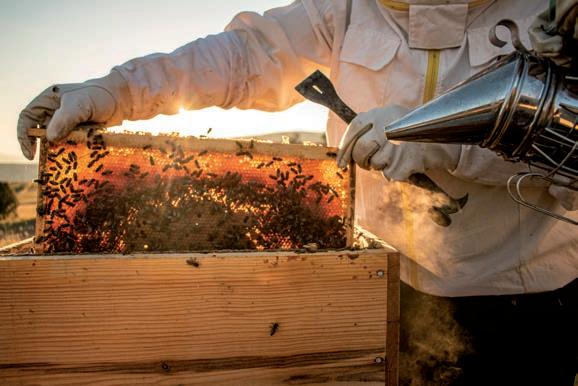
Book a 45-minute beekeeping workshop at spectacular Alpina Gstaad. Join professional local beekeeper Stefan Neuhaus and discover the fascinating world of bees, the production of honey and what Alpina’s busy bees need to create this sweet treat. Protective clothing is provided. switzerland.com/ench/accommodations/ the-alpina-gstaad
Delicious local honey is produced by thousands of industrious bees in their hives at Villa Honegg, around an hour from Zurich. Snap up a jar or two direct from reception –it’s also served as a breakfast staple. villa-honegg.ch
2 Niesen honey
Along the route of the Niesen Railway, leading to the Berghaus Niesen Kulm, keep an eye out for the bright red bee hotel shaped like the iconic Niesen funicular. The honey is available to buy from the kiosk next door to the Berghaus. niesen.ch
3 Hotel Eden Roc
High above Lake Maggiore sits Hotel Eden Roc with eight beehives. Guests can get up close to the bees, enjoy their produce at breakfast and buy jars of honey from the hotel to take home. tschuggen collection.ch
in Switzerland with inventive sanctuaries for their winged guests of honour

BEST FOR FAMILIES
The enchanting ‘fairytale hotel’ Märchenhotel Braunwald has got family-holidaying down to a fine art. Alongside modern rooms and outstanding childcare (available 12 hours a day), there’s an incredible range of offerings, from thrilling activities to playgrounds, family pools and a seriously good wellness programme. During the summer, hotfoot it to enjoy a small zoo with alpacas, bunnies, goats, lamas and chickens. Come winter, it’s skiing and sledding galore. The huge ‘Hall of Kings’ will also astonish with ultra-modern technology such as flying tables, locomotive Emma and a bouncy castle floating in the air. The hotel’s latest arrival is ‘BeeMärchen,’ a miniature masterpiece for wild bees. Conceived by designer Sarah Rittmann and scaled at a delicate 1:50 ratio, this diminutive bee hotel mirrors the original’s fairy-tale splendour –complete with turrets no larger than thimbles, lovely bay windows and tiny rooms designed for buzzing guests. In ornate honeycomb structures, wild bees can settle into their storybook abode, surrounded by a delightful garden. Nearby butterfly and bird houses offer further safe havens, creating a magical menagerie which children love to discover. It’s also the perfect chance to teach little ones all about the importance of wildlife. maerchenhotel.ch /en


BEST FOR WINTER SPORTS
A sustainably designed sanctuary, Hôtel des Horlogers sits in Vallée de Joux, where master watchmakers have crafted timepieces for centuries. Created with raw materials from the region, this zig-zagging architectural marvel was commissioned by Audemars Piguet, with the hotel mere steps from its legendary atelier. Overlooking the Risoud forest, there are 50 incredibly elegant rooms and suites offering an exceptional view of the valley. Award-winning chef Emmanuel Renaut heads up the kitchen, producing exquisite dishes made of locally sourced produce in the forest-gazing restaurant, while the expansive spa by Swiss beauty brand Alpeor also uses regional products in treatments. Now this serene retreat is extending its green credentials beyond human guests with ‘Summnest’ – an avantgarde wild bee hotel for ‘sporty bees’ that mirrors the property’s commitment to sustainable luxury. Created by industrial designer Annina Mijatovic and inspired by the cross-country ski trails threading past the hotel, this striking column combines clean architectural lines with durable natural materials. Rising like a modernist sculpture in the hotel grounds, Summnest offers essential nesting space, while being a powerful statement for biodiversity that would make even the most discerning Swiss craftsman proud. hoteldeshorlogers.com/en



BEST FOR ACTIVE ADVENTURES
All-round fun is guaranteed at Peaks Place in Laax. Combining the privacy of a holiday apartment with the usual hotel services, there is a huge range of accommodation, with some apartments housing up to eight people. The s’nani restaurant serves fantastic food, reinterpreting ageold recipes and championing local ingredients. And you can work any extra calories off by getting stuck into Peaks Place’s incredible choice of activities – particularly when it comes to two wheels. This brilliantly equipped certified bike hotel has all you could need to start pedalling, including bike washing and repair stations . There are plenty of trails to choose from, with 205 miles of bike paths. Wildlife is not missing out on the action either thanks to a recentlyinstalled ‘hedgehog bike hotel’. Named Peaky Place, this miniature version of the original hotel is tailored for prickly friends. Built from spruce wood, its jagged shape blends seamlessly into the woodland. A cosy sleeping area in the back offers shelter, while two green rooftop sections provide food for insects and birds. Don’t miss the tiny pump track on the roof – just in case a little guest arrives on wheels. peaks-place.com /en
BEST FOR WELLNESS
The Dolder Grand has always wowed with its elegant bedrooms, Michelin-starred food and sparkling panoramic views of the Alps. Then there’s the fabulous multi-award-winning 4,000 sq/m spa, with a 25m swimming pool, whirlpools, sanarium, snow paradise, steam bath and outdoor sun terrace. Five tennis courts, a nine-hole golf course, driving range and minigolf course keep all generations happy, while winter brings the Dolder Kunsteisbahn, one of Europe’s largest open-air iceskating rinks. The art collection is eye-opening, too, with more than 100 works, including originals from Takashi Murakami and Salvador Dalí. Now, this storied resort – which began life as a sanatorium and wildlife park in 1899 – is returning to its roots, with the ‘Tiny Dolder Grand’, a charming miniature of the hotel for small guests at the edge of the forest. Conceived by mechanical engineer Josua Glünkin, who was inspired by the elegance of the original ballroom, it’s an intelligent balance of style, sustainability and functionality. The space, crafted entirely from local materials, has been beautifully thought out: hedgehogs have the luxurious ground-floor suites, while birds relax in style on the sturdy sandstone roof – which serves as part spa, part social club. Plus, there’s a species-appropriate entrance and removable roof for easy cleaning. thedoldergrand.com/en




Beautifully restored Villa Carona sits above Lake Lugano, bordering the same quaint village where Swiss-German poet Hermann Hesse spent many hours. With 18 individually decorated rooms, this family-run villa’s 200-year-old history is evident, with a wonderful array of antiques filling every corner, including original wall paintings. The food hits all the right notes thanks to head chef Gabriele Migliorati, who creates beautiful ItalianMediterranean cuisine using the freshest, mainly local ingredients. Breakfast on the terrace with a view of Monte Generoso is hard to beat and the service is superb. Outside in the flourishing Mediterranean garden is a refuge for up to 30,000 honeybees. Designed by Sarah Rittmann, this miniature bee hotel mirrors the architecture, colours and proportions of the original villa with delightful precision. Elevated on elegant stilts, it provides everything discerning bees need. Set amidst nectar-rich blooms, thoughtful features like a hinged roof, single flight entrance and capacity for ten Dadant frames ensure the local beekeeper can tend to residents efficiently and sustainably. The end result is an idyllic haven for honeybees, complete with all the heritage-inspired charm of its namesake. hotelvillacarona.com
BEST FOR TRADITION
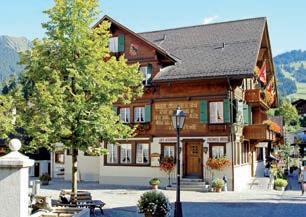
Built in 1845, Posthotel Rössli, the oldest guesthouse in Gstaad, has been lovingly run by the Widmer family since 1922. Brilliantly located in the town centre, just two minutes from the train station, there are 18 recently renovated rooms with typically Alpine touches. The family rooms are superb and can sleep up to five guests. The two restaurants offer a cleverly balanced seasonal menu of traditional and modern dishes, using fresh local produce. The buzzing Stübli restaurant draws locals and tourists alike for its delicious local food and authentic atmosphere. Meanwhile, the super cosy Alti Poscht, which is named after the inn’s former life as a post office, offers a stand-out buffet breakfast amid reclaimed wood interiors. In the summer, the lovely new terrace is the perfect spot to while away the hours. Adding to the hotel’s charm is Série Horns, a series of wooden birdhouses designed by interior architecture student Jaemo Lee, outside the front of the hotel. Inspired by the iconic postal horn in a nod to the hotel’s history, the musical hornshaped designs feature chalet-style roofs and clever symbolism – linking birds to messengers and nests to mailboxes. Each is a fine example of Swiss craftmanship, beautifully complementing Posthotel Rössli’s Alpine elegance. posthotelroessli.ch
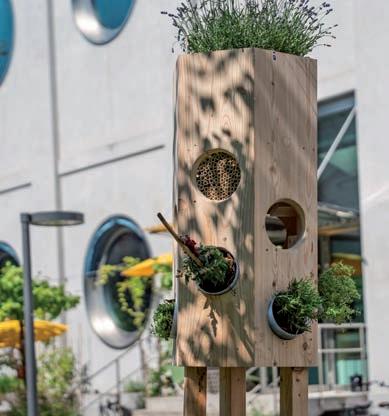
BEST FOR LUXURY
Set within ten acres of private gardens on the shore of Lake Geneva, this Belle Époque beauty was once the site of two peace-treaty signings in the early 20th century. Today, Beau-Rivage Palace is the epitome of luxury – starting with the 168 incredibly stylish bedrooms. There’s also a two Michelin-star restaurant, PIC au Beau-Rivage Palace, plus three other restaurants offering Japanese and Swiss cuisine, while the 75,000-bottle wine cellar contains many vintages from the nearby UNESCO World Heritage Lavaux vineyard. Add to that a Guerlain Spa with indoor and outdoor swimming pools, nine treatment rooms, a tennis court, a padel court and a golf driving range. A certified ‘Sustainability Leader’, the hotel has just installed a luxury retreat for wild bees in the park. Architects François Born and Adrien Clairac are the men behind BEE Rivage, which has been created as both a sculptural statement and ecological sanctuary. Drawing inspiration from the four seasons and local flora, this sensitively designed refuge caters to all the needs wild bees could possibly have. Within a protective circular boundary, a flourishing grove shelters diverse nesting structures, which are each tailored to different species. Beyond providing vital habitat, the hotel hopes that the project will serve as a compelling reminder of bees’ irreplaceable role in our ecosystem. brp.ch
BEST FOR DESIGN
One of Basel’s most striking industrial buildings (think futuristic-looking architecture with ultra-modern and lightfilled interiors), Silo Design & Boutique hotel, a former grain store, is breaking ground as Switzerland’s first boutique hostel. Smartly remodelled to create a budget-friendly option, there are ten double rooms with ensuite bathrooms and ten four-bed dorms, including special women-only dorms. An excellent breakfast of fresh local delicacies sets you up for the day. There’s also a living room for hostel guests and a meeting room used by creatives and small businesses. The latest guests to be catered for are bees with the just-launched Wild Bee Hostel, standing in the garden of the hotel. Created by designer and concept developer Sarah Rittmann, there are five elevated lodges that sit on slender wooden stilts, flawlessly integrated with raised planting beds. These hexagonal structures feature varying nest hole sizes to accommodate different bee species, while natural materials – bamboo, reed, hardwood, and clay – provide disease-resistant nesting conditions. The lodges’ ingenious design directly incorporates rooftop gardens and lush green cavities into the structure. This creates nectar-rich food sources within wing’s reach of their inhabitants, which means bees can feed and nest without venturing far. silobasel.com
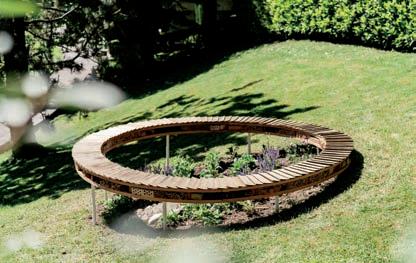

Nestled on the shores of Lake Constance, award-winning See & Park Hotel Feldbach is an all-rounder property that is perfectly placed for either business or pleasure. A former convent dating back to 1252, the original building houses the restaurant, which serves seasonal dishes, with carefully paired wine. The tower bar in the attic is a must-visit, with original wooden beams, a crackling fire and cosy sofas. The 36 bedrooms (all with balconies) are directly across from the convent in a modern building situated where the church once stood. There are also three auditoriums and seven group meeting rooms for up to 80 people, equipped with state-of-the-art technology. Couple all that with a beautiful rose garden, large park, lakeside terrace with spectacular views and a private pier. It’s also outdoors that the hotel’s latest project, the B-House, can be found. Inspired by the convent building, the concept was developed by architect Kosha Ahmadi and Laurin Schaffner, an industrial designer and design researcher. Cue the ideal retreat for bees, which offers thousands of nesting spaces. With a uniform design wrapping the structure, each nesting tube acts like a brick in the facade, while the metal roof provides weather protection – all amid a floral paradise. hotel-feldbach.ch



Crans-Montana is well-known for its exceptional panoramic views and beautiful scenery stretching from the Matterhorn to Mont Blanc. Six Senses is exquisitely placed to soak up the best of it all, with its slopeside position and direct ski-in and ski-out access overlooking the Alpine Forest. The 78 rooms and three-bedroom apartment have a delicious Swiss chalet feel. There’s also an array of fantastic bars and restaurants, a fabulous spa that blends high-tech biohacking with high-touch therapies, and an open-air cinema. Also part of the scene is five beehives, arranged down a slope, which feature the same chalet-style roof design as the main building. Each hive is named after the five senses, reflecting the brand’s philosophy (the all-important sixth sense being intuition). Complementing the apiaries are two insect hotels – both over 1.5m tall and in mirroring chalet style – which have been positioned in family-friendly spots to spark the curiosity of little ones and provide wildlife education. The initiatives are funded by Six Senses’ Sustainability Development Fund, which supports local environmental and social initiatives in line with the company’s focus on nature and community. sixsenses.com Switzerland Tourism has the perfect hotel for truly every need – find yours now. switzerland.com/hotels n
Farm-to-fashion? Enter a new breed of holiday experience, says Francisca Kellett
Of all the things I worry about when I travel, sheep is rarely one of them. Delays, cancellations, tra c jams, carbon footprints –these weigh heavily. Sheep? Not so much.

We’ve long enjoyed the spoils of the farm-to-table movement, with hotels falling over themselves to o er tours of their organic farms and tasting menus that showcase their regenerative practices. Local, seasonal and sustainable is a good mantra to have, but it need not only apply to food. What about what we wear? What about the sheep? Enter a new breed of holiday experiences that o er travellers the chance to see, buy and even wear produce from the places they’re staying in. Let’s call it farm-to-fashion, such as the wool experience you can join with Jess Ludwicki, a farmer in the Catskill Mountains in Gardiner, New York. Known for her ethical wool production at Wild ower Farms, part of Auberge Resorts Collection (aubergeresorts.com/wild ower-farms), you can watch a sheep-shearing demo, and learn about her ock of Icelandic sheep and their cruelty-free eece, before seeing how the wool is treated and buying products made from the fruits of Jess’s labour. en it’s time to hike, swim or lounge in the luxury cabins dotted across ower- lled meadows.
In New Zealand, Flockhill Station ( ockhillnz. com) in the Southern Alps, is a remote, 36,000-acre working farm, allowing luxe living in the wilderness. ere are 14 beautiful villas, plus y shing, rock climbing, biking and ATV tours. But the highlight, as the name would suggest, is mustering ocks of sheep for the day, joining the dogs and shepherds on the station. Guests can help move thousands of Merino-Romneys between lush pastures, and learn how the wool is transformed into ZQ Merino yarn, the world’s leading ethical wool. ese are, in other words, very happy sheep, producing very lovely wool.
Nearer home, the 400-year-old Baston Hall (bastonhall.co.uk) sleeps 18 on its regenerative farm in Worcester, where cattle and sheep roam in rewilded meadows fringed by ancient woodland. Sheep-dog training is on o er if you want to get up close and personal to the creatures, as well as help out during lambing season.
Even cattle can be sustainable, if done right. Caiman (caiman.com.br), a 53,000-hectare reserve and ranch in Brazil’s southern Pantanal, aims to be a blueprint for sustainable ranching operating hand-in-hand with wildlife safaris, protecting both the local culture and the biodiversity of the wetlands. As well as jaguarspotting expeditions, guests can join the Pantanal cowboys while they work with the cattle, from lassoing and cattle-herding by jeep and on foot, to joining their weekly churrasco barbecue in the cowboys’ shed, plus the chance to buy hand-crafted leather goods in the lodge’s shop. It’s about as local and sustainable as you can get – a good mantra to have, whether it’s what’s on your plate, or what you bring home. n

Guests can help move thousands of MERINOROMNEYS between lush pastures, as well as learning how the WOOL is transformed into yarn, the world’s leading ethical wool

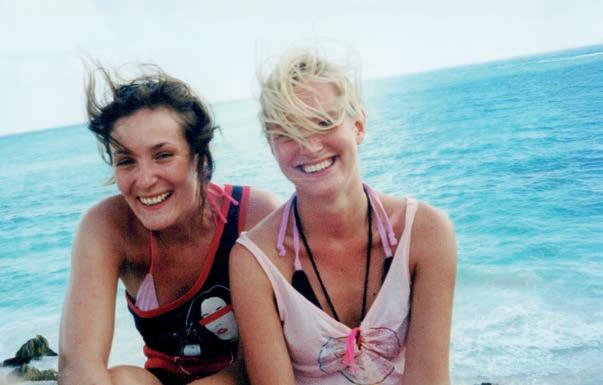
Melissa is my best friend. Aged seven we traded our My Little Ponies. Aged 18, we trade tips on homework and boys, and share our diamanté belts and white wine. We have been longing to step into a world beyond north London and, nally free of school, Ayia Napa in Cyprus will be our rst proper holiday as grown-ups.
We arrive at a towering apartment block in a dusty and neglected part of town, and slather ourselves in low-factor suncream, frying ourselves beside the pool. When the sun goes down we play drinking games with tequila, put on iridescent makeup and baby-doll dresses, and go out dancing to club anthems until dawn.
Melissa and I escape to a nearby beach where we tear into watermelon esh and laugh about the improbable number of men in Ayia Napa who claim to be remen. I decide it’s the perfect moment to tell her the most important thing that has ever happened to me: I’m in love with a boy. She con des she is too and for a moment we are giddy with the joy of it. Now we’ll have this in common, along with everything else. I ask who she has fallen for and discover we are talking about the same boy. With one minor di erence – he has declared his love for her.
I’m devastated, even though the boy is half my size and we’d look ridiculous together. In truth, I had been more excited about the drama of falling in love than anything this boy said or did. Melissa and I don’t fall out over it. On some level, even in the middle of the tears and the heartache, I know this boy will be a footnote in a friendship that will last forever.
After graduation, I dive head rst into managing the careers of comedians and Melissa goes into PR. Our lives are a charmed merry-go-round of wine bars, parties, comedy clubs, house-shares and ings. It is a time of possibility, of trying out everything and everyone, and Sri Lanka feels




like the kind of place we might have a real adventure. On the plane to the capital, Colombo, I take one too many of Melissa’s sleeping pills and wake to nd her wheeling me through the airport on a luggage trolley. is sets the tone for our entire holiday: she books and schedules everything from feeding baby elephants and trekking in the jungle, to a stay at the luxurious Hotel Kandalama and visits to temples where we sit for hours chatting. When we return to Colombo for our ight home we discover a tourist plane has been blown up on the tarmac by the Tamil Tigers. No one is hurt but our return is delayed by a few days. While she is delighted with the bonus holiday days, I feel sad: I have just started going out with a boy and, for the rst time, I’m in love with more than the idea of someone. It raises an anxiety in us both and we have been avoiding this subject.
Once home in London, we drink wine and tearfully reassure one another that boys won’t change anything between us, even if this one is more my size and also probably my future husband. But it does change things for Melissa because she meets his brother and falls in love with him. Everything is perfect – the soaring, albeit clichéd third act resolution of a movie. en everything changes again. Melissa’s beautiful younger sister is killed in a bus accident while on a medical placement in Uganda and the skies ll with black clouds in an instant.
In the months that follow, we go to a yoga retreat in Kent. We walk on carpets of cobnuts in the woods, and along the edge of chalk cli s in silence because we can’t nd words for such a seismic loss. We do yoga and meditation, eat vegetarian food, and go to bed early. One afternoon, we’re lying on our yoga mats when I turn to see Melissa, wrapped in her sister’s pink pashmina, tears running silently down her cheek. I hold out my hand and know then that my only job is to always be close, even if I cannot join her in the loneliness of grief.
Despite the profound absence in her immediate family, the years that follow have periods of immense joy. We marry the brothers in two laughter- lled days of singing, eating and dancing, and are swept into the embrace of a shared wider family, gaining new sisters, brothers and parents-in-law. We have our rst children and those children are cousins. Our rst holiday together as a new family is on the Jurassic Coast in

Dorset, where I get mastitis and Melissa takes my baby when I need to recover. We buy scones from the bakery in Corfe and our babies splash in the same baby-bath out on the decking. e air is warm and dry, and smells of pine, gorse and barbecue smoke. We sit on the jetty, our feet dangling in cold water, drinking rosé. We talk about her sister and the charity Melissa is setting up in her name. We laugh about leaking boobs, o ce politics and dysfunctional comedians.
In the next few years, we both give birth to our second children and it’s hard to nd time to run away on holiday together. Instead, we meet in our homes, in pubs and cafés. en one day, a nurse comes to give my new baby a follow-up blood test for cystic brosis, after the standard heel-prick test proved inconclusive. I tell Melissa that if my baby is given a formal diagnosis, I’ll give up my career in comedy, write novels, and campaign for access to the best medicines. All of that happens, in time, but rst it is my turn to go to the darkest of places. I hold my children tight and grieve the loss of their cloudless skies – and Melissa is always close by.
the High Line and over the Brooklyn Bridge, but Melissa is bone tired. Instead, we book a boutique hotel in the Algarve. By day, we swim in the freezing Atlantic and read by the pool. At sunset, we drink cocktails, eat Ibérico ham and play cards. We talk about how we both still feel exactly as we did when we rst met and yet completely di erent. e women and mothers we are now have been forged, like swords, in re. Mostly, though, we laugh, doubling over until our stomach muscles ache. On the last day, she takes a call from the GP, who says her exhaustion is due to low iron levels. She is prescribed tablets and we think little more of it.
Even in the middle of the TEARS and HEARTACHE, I know this boy will be a FOOTNOTE in a friendship that will last FOREVER
One day, when my son is admitted to hospital for CF-related tests, Melissa’s daughter is admitted to another hospital, su ering from pain in her right elbow and raised glands. By the time my son has been discharged, her daughter has been diagnosed with leukaemia. It is another seismic shock and the waves are felt far and wide. Melissa sets aside her civil service job, her future plans and her scheduled holidays, and her family focuses on the two-year treatment plan. It is a feat of strength and endurance for them all.
Her daughter makes a full recovery, walking out of her hospital ward to applause. When life in both homes feels strong again, we nally plan to go away together. I suggest New York for its distracting colours and sights, for the cocktails we could drink, and walks we could take down


Soon after, the pandemic hits. Amid global chaos comes more news. My son will have access to new, life-changing medicine. And Melissa is diagnosed with stage 3 bowel cancer, her low iron levels a symptom. We talk on the phone, unable to see each other, trying to process the shock and fear. Plans are calmly made. She leaves her job for the second time in ve years, and goes into treatment. Holidays are shelved and all focus turns to recovery. I watch her meet every phase with grace and determination. She goes into remission, building her strength beyond where it was even years before diagnosis, and we plan a holiday to mark our youngest children nishing primary school. is time it is me who calls for somewhere that is undemanding and close to home. My mum has recently died after a long battle with Parkinson’s, and my dad has just been diagnosed with terminal cancer. I am sad and unsteady, like the ground beneath me is giving way. I can’t go far. e idea of distance makes me anxious.
So we board a train to Margate with our children and visit the Turner gallery, the Tracey Emin gallery, second-hand clothes shops, Margate Bookshop and e Shell Grotto. Over sh and chips, we try to teach the kids our favourite card games, but they’d rather talk to each other about national ags and their future travel plans. We walk along the beach toward Broadstairs and talk about Melissa’s new business, her recently awarded CBE and the new book I’m writing – about best friends, set on the same stretch of Jurassic Coast we once visited with our babies. ose babies have now grown into the best of friends. ey are walking ahead of us, chattering away. When we nally catch up with them we ask what they’ve been talking about. Japan, they tell us. ey’re planning to go there together, as soon as they’re grown-up.
e Last Weekend by Hannah Begbie (HarperCollins, £9.99) is out now n


Mexico’s Riviera Maya is undergoing a quiet revolution. Luke Abrahams discovers how a marine-led conservation movement is redefining luxury travel
The Riviera Maya. For years, it has been dubbed a package holiday all-inclusive nightmare, with a consumption culture to match. Grand white sandy beaches and quixotically blue waters are part of the allure, as are cheap rates. But with a new narrative of luxury doing good, that’s all slowly beginning to change. While beach bods and cenotes are still high on the tourist agenda, Yucatán is slowly rewriting textbook travel to this region of Mexico by shaping a di erent kind of marine-led, conservation- rst tourism model. But why? Scientists classify this Central American wonder a ‘megadiverse’ country as it holds a signi cant portion of the world’s biodiversity. As well as being home to a high proportion of endemic species, Mexico is also a

centre for the origin of many globally vital plant and animal genera. Its ecological standing is just as pivotal. Mexico’s diverse ecosystems, including marine biospheres, are vital for maintaining global biodiversity and regulating the climate. In fact, few travellers realise that the country is home to the second-largest barrier reef system in the world: the Mesoamerican Reef. Stretching 700 miles, its importance goes far beyond the seas and gulfs of Mexico. Organisations like e Nature Conservancy and the World Wildlife Fund are working to protect the reef through several conservation initiatives, creating a network of protected areas committed to combating the threats the coral system is facing (political corruption, overtourism, global warming, pollutants and

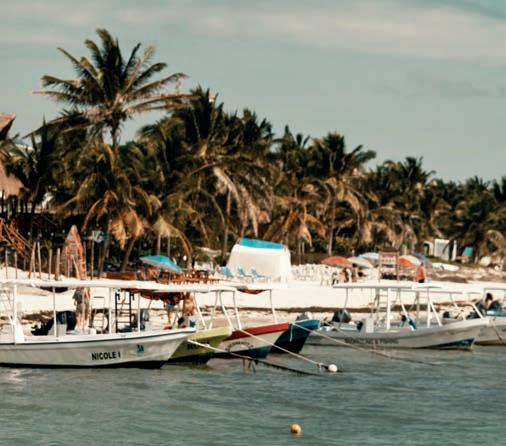
with global environmental organisation Parley for the Oceans. Its purpose is to connect the world’s greatest thinkers, creators and leaders to help raise awareness for the fragility of the ecosystems that make up the oceans – something they dub ‘Earth’s largest and most vital biome’. eir crusader on the ground is Claudia Padilla Souza, who I meet on an early morning coral reef mapping expedition. With over 20 years of experience behind her – thanks to a lengthy career at the National Commission of Fishing – Padilla Souza’s specialisms in reefs and community outreach programmes have struck a chord with guests and locals. ‘It’s all about trying to nd a solution to help control the e ects of climate change on our reef. Reefs are not as adaptable as us humans. ey take millions of years to grow, and the aim of the programme and partnership is to make people see the e ects their actions are having on it.’ Rede ning travel to this region of the Yucatán is as personal as it is necessary. Osvaldo Páez, the hotel’s sustainability chief, has spent several months crafting experiences to spur a new wave
‘Coral reefs are DYING, and it is the beginning of the end. The problem is us. People do not look to the FUTURE. They think of the now, and that is the real issue. ARTIFICIAL REEFS are good and all, but they are like makeup. They are not a SOLUTION.’
erosion). An internationally led report produced by the Global Coral Reef Monitoring Network – gathered across 73 countries, including Mexico – found that 14 percent of the planet’s reefs were lost between 2009 and 2018.
Yucatán’s tourism industry is responding by emphasising the need for new infrastructure, awareness and marine conservation programmes spearheaded by positive-impact tourism models. One of the rst hotspots to emerge from this conservation impulse is Maroma, a Belmond hotel. Set on the shores of the Riviera Maya, the hotel sits on a coast virtually swallowed whole by nature. On the horizon, reef sharks, manta rays and a medley of endangered marine turtles thrive in their nesting grounds, while inland, lowland tropical jungle runs riot through the lush bush of the Yucatán Peninsula – home to elusive jaguars, pumas, and nearly 500 species of birds.
Beyond the manicured beach and Tara Bernerd’s chic redesign, energy, carbon output and the oceans are all under the hotel’s microscopic radar. To help broaden its green credentials, the luxury brand has partnered


of interest in positive-impact-led tourism to the coral coast. Since its reopening as the ‘new Maroma’, the brand has implemented – in addition to the Parley partnership – several fauna research programmes and created arti cial reefs alongside scienti c experts like Padilla Souza.
‘We want to make sustainable tourism fun, as well as educational and interactive for guests and the people who work here. e mission is to bring a wider consciousness to the climate issues Mexico faces, while preserving our national heritage. It’s led by a passion to protect and to conserve and to show that luxury tourism can have a positive impact beyond what’s perceived, and we want other hotels like ours to do the same.’ e health of the coastline is also a focus of neighbouring hotel Chablé Maroma. e Mexican boutique brand’s philosophy is grounded in ‘responsible tourism for the nation’. Guided by a strategy adopted from the U N’s Sustainable Development Goals initiative, wildlife conservation and rubbish collection are integral to its scaled brand operations across the peninsula to the group's agship property, Chablé Yucatán.
Local experts advise the brand. In nearby Puerto Morelos I meet María del Carmen García Rivas. A researcher and ranger with 25 years of experience, she was one of Mexico’s rst diving instructors, and among the rst women to work alongside the navy in the country. Puerto Morelos National Park is very much García Rivas’ home turf, where she focuses on coral reef conservation and marine biology research. At our chance meeting at the port she gives it to me straight: ‘Coral reefs are dying, and it

is the beginning of the end. e problem is us. People do not look to the future. ey think of the now, and that is the real issue. Arti cial reefs are good and all, but they are like makeup. ey are not a solution.’
Over the years, she has seen the reef collapse at a colossal rate due to climate change, unsustainable shing practices, pollution, coastal development and ‘ignorance’. Perplexed, I ask her – so what’s the point if the future is so bleak, and what can we realistically do about it? She laughs, pauses, stares at me and tells me to look at the ocean. As I gaze at the cerulean and turquoise shades of the reef, she says:‘People don’t realise how important these places are to our future. Consumption culture is the principal problem – and the model of the capitalist economy. My clothes I am wearing right now are 20 years old. I don’t need Dior or Chanel. I need air in my lungs, and that is what these delicate reef systems give us. Without them, we would be dead.’
And with that, I returned home, not just enlightened but inspired to do more.
BOOK IT: Journey Latin America o ers seven days in Mexico’s Yucatán Peninsula combining the Riviera Maya with Mérida from £5,010pp, including ights, transfers, private excursions and accommodation at Chablé Yucatán and Belmond Maroma on a B&B basis. journeylatinamerica.com
Luke’s return ights from London Gatwick to Cancun had a carbon footprint of 2,359 kg of CO2e ecollectivecarbon.com n




Tapping into a gigantic global market, Inclu is setting a bold new benchmark for inclusive travel. Founded in 2022 by accessible travel pioneer Richard ompson, the brand is shaped by its philosophy of ‘conscious inclusivity’. At its heart is Veri ed by IncluCare, an accreditation ensuring hotels and restaurants aren’t just physically accessible but deliver seamless, stylish service to guests with mobility, sensory or neurodivergent needs. e brand’s other services include Inclu Academy and Inclu Consulting –which equip the hospitality sector with the know-how to get it right – as well as a hotel and restaurant concierge platform that makes bookings e ortless. inclugroup.com
More than a decade after rede ning barefoot luxury in Sumba, NIHI® is putting another hidden corner of Indonesia on the global map. Launching next spring, NIHI® Rote marks the brand’s rst expansion beyond its cult destination, with all the wild beauty, sustainability focus and free-spirited ethos fans have come to expect. Set on the secluded Bo’a Beach in West Timor’s Rote Island, the resort boasts 21 thatched pool villas and front-row access to worldclass sur ng waves. Expect signature experiences like the NIHI® Spa Safari™, diving, spear shing and cold-hot wellness rituals paired with new touches like padel courts. e resort will launch the Rote Hospitality Academy by NIHI® to equip local youth with vocational skills while protecting the island’s culture and environment. An evolution that promises to balance the same sense of adventure with a deeper commitment to legacy, rooted in the land and driven by community. nihi.com

Burberry is undertaking an exclusive takeover of e Newt. Encapsulating the essence of the quintessential British summer, the collaboration will embody the brands’ mutual love of British countryside and heritage. Guests will nd the West Country bucolic idyll re-dressed from head to toe in Burberry, from the newly chequered croquet lawns and branded badminton court to sheltering from the sun beneath Burberry parasols and taking to the Somerset skies in a bespoke Burberry hot air balloon (an homage to early 20th century ballonist Air Commodore Edward Maitland, who ew 1,117 miles wearing Burberry gabardine). In case you underpack, selected items from Burberry’s 2025 summer collection will be available to purchase, including Burberry check swimwear, hats and umbrellas. Until 17 August. thenewtinsomerset.com
Breathing bold colour into the traditional safari aesthetic, South African designer Liz Biden has created six individually themed tented suites in Masiya’s Camp, the new lodge at Royal Malewane in the Greater Kruger National Park. Taking palette inspiration from the brilliant plummage of her favourite bush bird – the lilac breasted roller – Biden intermixes vintage-inpired orals and stripes with bespoke and antique furniture, Persian rugs and collected artworks and design pieces to bring character and comfort to the suites, which all have freestanding bathtubs, decked terraces, plunge pools and outdoor showers. e lodge centres around a tented dining room with a pizza oven and outdoor braai, a lounge area and an outdoor swimming pool with umbrellas and sun loungers. As to branching out into the bush, the Royal Malewane guides and trackers are known for being the best in the business. theroyalportfolio.com

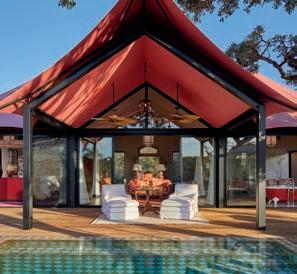

Experiential travel specialist Explorations Company has launched a portfolio of 12 new journeys designed to deliver meaningful wildlife encounters. e bespoke itineraries combine expert guiding with stays in luxury – but often remote – lodgings that provide privileged access to some of the planet’s most biodiverse ecosystems. In the 130 million year old rainforests of Borneo’s Danum Valley, for example, naturalists introduce guests to a host of primates, including orangutans, gibbons, proboscis monkeys, red leaf monkeys, silvery langurs and slow lorises. is 11-night Borneo trip also includes boating down the Kinabatangan River in search of pygmy elephants, and night safaris to catch a glimpse of the island’s most elusive wildlife such as clouded leopards and mouse deer. Other private tours include tracking leopards in Sri Lanka, assisting jaguar conservation in Argentina and snowshoeing untouched terrain in the Antarctic. explorationscompany.com

THE TELEGRAPH HOTEL, Tbilisi, Georgia
The former Tbilisi Post and Telegraph building has been given a new lease of life by Neri&Hu, which has layered the building’s Soviet bones with contemporary minimalism across 239 rooms, seven restaurants and a jazz club. A private art collection, rooftop cocktails and old town views complete the hotel that is making waves across the city. lhw.com

A new party playground lands on San Antonio Bay as O Beach teams up with Bonito for a 252-room escape. Designed for laid-back luxury, the resort unfolds around two pools, a spa and a rooftop restaurant. Expect Mediterranean boho vibes, open-air spaces, DJ-led brunches and that signature White Isle hedonism. obeachibiza.com

THE NEWMAN, Fitzrovia, London, UK
Perfectly placed between Soho’s buzz and Bloomsbury’s bookish charm, The Newman brings playful polish to London’s hospitality landscape. Inspired by Fitzrovia’s spirit, Lind + Almond blends Victorian and Art Deco interiors across 81 rooms, a chic brasserie, a cocktail bar and a Nordic-inspired spa with hot-cold experience cabins, a salt therapy room and a hydrotherapy pool. thenewman.com n

Rebecca Cox journeys to Marrakech and the Atlas Mountains, where Inclusive Morocco is pioneering safer travel for the queer community
In a year where the trans community has seen enormous legal challenges to (and consequential infringement of) their rights both in the UK and the US, and an Albanian lesbian couple successfully fought an asylum case to stay in Britain after being subjected to violent homophobia in their home country, the rights of the global queer community are still far from guaranteed in 2025. But the challenges are greater in some countries than others. Take Morocco, where same-sex relationships are illegal and there is no legal framework for changing your gender markers. But love is a force greater than laws, and queer people exist here in Marrakech where our story begins, with two queer individuals from di erent continents enjoying a glass of local rosé in the mid-afternoon sun. One of them is me, a bisexual writer from England; the other is Bilal El Hammoumy, co-founder of Inclusive Morocco, the country’s rst queer-owned, diversity-focused travel company.
First on our conversational agenda is the surprisingly good local wine, followed by some recommendations for unmissable street food I should seek during my visit. Because while the challenges facing queer travellers may be unique, the desires are, on the whole, no di erent from anyone else’s. We want culture, history and local avours; access to safe spaces; and connections to new places and faces. And, with the right guidance, they can be found in abundance in Morocco.
Finding these destinations, and navigating them safely, is easier said than done. Each year leading travel companies and publications release listings revealing where queer travellers should and shouldn’t visit. But these lists don’t tell the whole story; they tend to be based on law, rather than the cultural temperature of a destination. ‘While there are laws against being gay here, they’re rarely enforced,’ El Hammoumy tells me. He gives an example of one case eight years ago of two women being prosecuted for kissing at a party, though they were later acquitted. In many conservative countries there are safe spaces and thriving queer communities – and tourism has a role to play in protecting them.
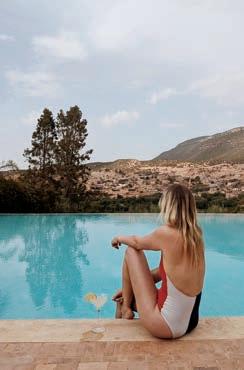
In Morocco, as tends to be the case, money makes change. When governments see a diverse cultural landscape is a lucrative one, the needle moves. For countries that heavily rely on tourism, this is huge. As El Hammoumy says: ‘By continuing to highlight and celebrate the diversity within Morocco, we can ensure tourism becomes a force for unity and understanding.’
is is something recognised by Uwern Jong, who I met six months earlier onboard a rather more liberal voyage on the Venice Simplon-Orient Express, packed end to end with queer folk and
allies speeding on an especially rambunctious Pride journey celebrating queer music, fashion and culture. ere it was not about blending in but coming together and standing out – because gathering the LGBTQ+ community en masse is always an expression of explosive joy, however challenging the political landscape.
Jong is co-founder and experientialist-in-chief of Out ere, a multi-award-winning luxury and experiential travel media brand rooted in diversity, discovery and discernment. On this very rst meeting (after dancing late into the night and reconvening for a slightly woozy, champagnefuelled lunch on board), Jong explains his vision for inclusive travel needed to go above and beyond these carved-out spaces, wondrous as they are.
‘I want us to step outside the bubble more,’ he says. ‘To connect to the stories of the intersectional queer people in the world who are creating unique adventures that celebrate the history and richness of the communities they are part of. I want to share that.’
e global queer community has a place not just in the future but rmly rooted in the past, too. In Morocco, El Hammoumy and I visit the YSL Museum and exquisite Jardin Majorelle, a monument to the openly gay designer who found

freedom in Marrakech at a time where being gay in the US and Europe was less tolerated, showing that a culture of tolerance and acceptance (or a lack of) can run deeper than law.
With the highs come lows, and I ask Jong about the tide turning away from positive progress. ‘In the short term, I believe the world will get smaller before it gets bigger for LGBTQ+ travellers,’ he says. ‘We’ll see people returning to places they feel safest. But there are also emerging destinations where society has become more accepting over time, who are decriminalising being LGBTQ+, and some even actively promoting themselves as safe and inclusive havens.’
It would be remiss not to address the additional challenge of intersectionality in nding these ‘safe havens’. Queer women will have di erent needs to gay men; trans travellers face a whole new set of challenges; plus there are additional age, race and socioeconomic factors at play. ‘Businesses, hotels, guides, agencies – whether they’re run by LGBTQ+ people or by allies are important, because not only do they bring safety to the equation, they bring authenticity,’ says Jong, highlighting the need for on-the-ground companies such as El Hammoumy’s.
The worries I had about finding my place in this rich cultural tapestry evaporate quickly because I’m treading the path carefully laid by Inclusive Morocco, crafted with a queer woman in mind

With El Hammoumy, I travel from the bustling medina to the Atlas Mountains, meeting tour guides, chefs, drivers and regular visitors. I spend much of my time chatting to our driver Nisserine, one of the country’s few female drivers, who relied on her family’s tolerance and acceptance to allow her to follow her dream to succeed in a maledominated eld. I also meet Rashid, a Berber, who expertly guides me on a mountain hike, greeting everyone he sees like family, their reciprocal warmth extending to me, an outsider. e worries I had about nding my place in this rich, cultural tapestry evaporate quickly, because I’m treading the path carefully laid by Inclusive Morocco, crafted with a queer woman in mind.
Companies such as Inclusive Morocco and Out ere, with queer people like El Hammoumy and Jong at the helm, make safe travel possible for all those that love outside the lines. ‘ ere are LGBTQ+ people everywhere in the world,’ says Jong. And this is where progress lies: telling the stories of, and nding safe passage to, the underrepresented and at-risk queer communities around the world. It’s one of the best ways to keep love alive, even in the most challenging places.
Rebecca’s return ights from London Gatwick to Marrakech had a carbon footprint of 686kg CO2e. ecollectivecarbon.com
Read a full review of Rebecca’s journey through Morocco, plus more from her interview with Uwern Jong at countryandtownhouse.com n
Fee


After a ten-hour drive from Monaco through relentless rain, arriving at Reschio after many years of anticipation felt like crossing into another world. My two daughters, entranced by Greek mythology podcasts, fell silent as we approached the gates of this 3,855-acre Umbrian estate. We were greeted by uniformed doormen and the warmth of a generous roaring re in an open stone hall lled with cut owers; there was no reception desk to be seen, re ecting a quiet, unassuming luxury that set the tone for everything that followed.
Reschio – once a medieval fortress, now a hotel – has been painstakingly restored by the Count and Countess Bolza. eir family’s creative vision is embedded in every detail, from the hand-dyed yarns in the shop to the velvet slippers laid at our bedsides. is is not just a hotel, but a home shaped by three generations of passion, craftsmanship and reverence for the land.
Surrounded by forested hills steeped in heritage, Reschio invites guests into a slower rhythm. e family lives by the seasons, drawing inspiration from the smallest natural shifts. eir ethos – of presence, patience and attunement – informs every corner of the estate. Nowhere
is this more evident than in the stables; the horses of Reschio are integral to the estate’s identity.
Count Benedikt discovered his deep love of horses in his fties, transforming Reschio into a world-class centre for classical dressage. Today, it is home to 32 Spanish horses, including a blend of Andalusian and Lusitano breeds known for their agility, elegance and intelligence. e estate’s bit-free riding philosophy resonates with me as I explore my own deepening relationship with horses. My guide, a former showjumper, shared how her so-called ‘incurable’ horse was transformed here under the count’s guidance, prioritising empathy and compassion over control, and using a completely di erent set of tools that has kept her at the estate for 15 years.
O ver breakfast with the Countess, we swapped stories about raising children close to nature. Her creativity permeates the property: she dyes the yarns, presses the owers, and designs the daily details that elevate the everyday. at morning, my daughters and I delighted in the estate’s almanac of ancient activities, choosing a day of pottery and foraging.
Reschio is a place where time unfolds deliberately, with grace. Here, luxury is not de ned by extravagance but by care of the land, in design and the rituals of daily life.


Our rst meal was a midnight minestrone, made with beans freshly picked from the estate gardens. e method is the same I use at home, only here it is poured from a silver teapot by an immaculate but casually dressed butler, neatly encapsulating Reschio’s signature blend of grandeur and ease.
At dawn, I took a solo yoga session in the estate’s 16th-century chapel. As shafts of light streamed through arched windows, the atmosphere turned both mystical and sacred; I breathed in the building’s long history as I owed in and out of the poses.






Riding with my girls across wild ower elds and through shallow streams, lost in a romantic vision of this Tuscan idyll and a life lived so purely. Later at the estate’s Teatro Equestre, we watch mesmerised by the Spanish schooling and silent command, taking turns in horse whispering.

Reschio’s spa, a network of stone caverns beneath the castle, is a sanctum combining modern wellness practices with ancient ritual. With the girls, we slipped in and out of steam rooms and candlelit cave pools, scrubbing each other with salt and honey balm and bathing in cast-iron tubs by a crackling re, enveloped by a sense of peace, blissfully lost in time.
Reschio is more than a retreat, it is a living philosophy. It o ers not escape, but return: to nature, to rhythm and to taking care – to live presently, in togetherness. We’ll be back. n




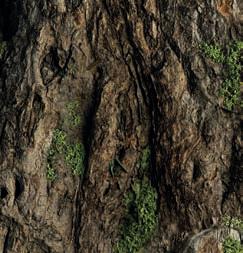







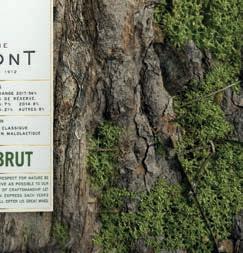







Can we harness the power of aquaculture to help forge a sustainable future for British food production, asks Jenny Jefferies
We are an island nation – and with more than 19,000 miles of bountiful coastline, 11,000 shermen, and about 950 independent sh shops, market traders and shmongers, the British shing industry brings in more than £1bn to the UK economy. UK shing individuals and businesses work hard all year round to ensure that the seafood on our plates is environmentally, ethically and economically sustainable. Regenerative aquaculture goes one step further – and this is now an opportunity for us all to come together and nd out how so many di erent people help put British sh and seafood on to our tables in a low-impact way, conserving not only the sh and seafood stocks, but also our sustainable shing communities.
Seaweed and shell sh aquaculture can improve ocean health and biodiversity, meaning it is also regenerative for our oceans. e sustainability of global mussel farming and keeping our oceans beautiful is a huge passion for many in the marine and shell sh industry. Mussels can be grown on ropes suspended in the water, meaning there is little to no habitat disruption. ey feed naturally by ltering algae and other plankton, which improves the quality of the surrounding water. In addition, many mussels are free of any growth promoters or other additives such as fertilisers, making them an all-natural product.
Mussels are little powerhouses of nutrition and are often referred to as ‘the superfood of the sea’. Shell sh are amazing. Containing nearly ve times the amount of vitamin B12 as salmon and three times the haem iron of a rump steak, they are also extremely high in omega-3, selenium, iodine and protein, are a great source of bre, and often have a low carbon footprint. e reputation of mussels as a sustainable, nutrient-dense protein source continues to grow and they should be an integral part of our diets – both in the UK and around the world.
‘Our innovative o shore rope-grown farming techniques have been designed to create thriving ecosystems beneath the waves,’ says Sarah Holmyard of O shore Shell sh. ‘By growing mussels in a regenerative way, we contribute to both high-quality food production and the restoration of the ocean’s delicate balance – enhancing biodiversity, providing a sanctuary for a diverse array of marine life, and supporting the health of the surrounding environment. By establishing our farms o shore, they can operate in harmony with nature, far from the pressures of land-based systems.’
Another super-sustainable natural product is seaweed – or ‘nature’s silk’, as I like to call it. ‘With increasing competition for land, more extreme weather patterns, and increasing risk to our national food security, seaweed cultivation can and should play an increasingly important role as a versatile crop,’ says Tim van Berkel of the Cornish Seaweed Company. ‘It does not compete for land, and does not require fresh water, pesticides or arti cial fertilisers to grow. Seaweed farms are even known to boost biodiversity and absorb the nutrient run-o from terrestrial farms.’ Seaweeds also grow fast; with its ample coastline, the UK is one of the best-placed countries to capitalise on its potential.
Apart from its use as a food source, seaweed continues to be developed into novel products, and Cornish Seaweed is involved in several research projects. ‘We are conducting trials on how to cultivate seaweed onshore,’ says van Berkel, ‘and we are also researching the e ects of our biostimulant, made from our sugar kelp grown in our o shore farm, on soil health, seed germination and the growth of various crops, and are collaborating with research organisations to develop a textile made from seaweed.
‘Challenges remain though – seaweed is still relatively expensive compared to subsidised conventional crops and
petroleum-based products, so the price needs to come down, which we are trying to achieve through mechanisation, scaling and smarter cultivation techniques.’
Technology is innovation’s best friend – and scallops are no exception. In the UK, about 95 percent of scallops are caught by dredging, a destructive shing method that involves dragging heavy, toothed metal sleds across the seabed. However, pot-caught scallops o er a low-impact alternative where the scallops simply swim –attracted by LED lights – into modi ed crab pots. Unlike towed dredges, scallop pots are static and therefore aren’t destructive to marine habitats and species.
e discovery that scallops – which have 200 tiny eyes – could be caught in pots tted with LED lights was made in 2022 by scientists from Fishtek Marine, a world leader in bycatch prevention technology. It happened while trialling small underwater lights, invented by the Devon-based company to protect sh stocks by replacing the need to use sh as bait in crab and lobster pots
Working with Jon Ashworth, a sherman based in Newlyn, Cornwall, Dr Rob Enever and his team at Fishtek Marine discovered that the lights, combined with specially modi ed pots, were attracting unprecedented numbers of scallops in addition to the crabs and lobsters Ashworth was targeting.

A new low-impact inshore shery – o ering an alternative to damaging dredge-caught scallops – has now been created. More than 40 boats are using the technology to commercially catch Disco Scallops™. Together with Fishtek Marine and restaurant entrepreneur Lee Cash, they have registered the brand and created the Disco Scallop Collective to market the sustainable shell sh and encourage more shermen to access subsidised shing gear.
‘By putting modi ed pots in the water, shermen are being given a chance to diversify their catch and secure new income streams, while consumers gain access to a sustainable, seabedsafe scallop they can enjoy guilt-free,’ says Rachel Walker of the Disco Scallop Collective. ‘It’s exactly what environmentally conscious diners have been calling for – delicious seafood with a story they can stand behind.’ As awareness of Disco Scallops grows, the hope is that a ripple e ect will extend across the UK. ‘More crab and lobster shermen will learn how they can diversify their existing catch, moving toward a more secure and balanced future for their livelihoods – and more restaurants will join the movement toward responsible sourcing, making this ethical alternative the new standard.’
Pete Kibel, co-founder and director of Fishtek Marine, adds: ‘ is is a great example of how a technological innovation can deliver real and sustainable bene ts for the marine environment, and the communities that depend on the sea for their livelihoods.’ rough Open Seas’ ‘Dived Not Dredged’ campaign – which champions hand scallop diving and low-impact seafood – the organisation collaborates with low-impact shermen, the hospitality sector and food in uencers to spotlight the importance of sustainable and transparent seafood sourcing and labelling. Catch method is a key factor in seafood sustainability and by fostering informed conversations, it aims to drive positive change – bene ting marine habitats, coastal communities, and seafood lovers alike. e phenomenal harvest of mussels, seaweed and scallops –along with the ingenuity, passion and integrity of humankind – can be enjoyed in a sustainable way. We can now continue to look forward to a regenerative future, which must include lending respect and wonder to the power and magic of the sea, and to what lies within.
Jenny Je eries is an award-winning author, food columnist, producer and campaigner n







Regenerative farming has countless benefits – but how do we distinguish the wheat from the chaff, asks Tessa Dunthorne
Regenerative farming holds all sorts of promise – a study by the Royal Agricultural Society found that crops produced in this way measured 30 percent higher in vitamins K, C, E and B1 than ‘conventionally produced neighbours’. And then there’s the impacts on the planet: while traditional farming kills o organic matter in our mud (scarily, we might not be able to produce food in under 60 summers) regenerative farming brings that soil back to life, with a trebled health score. Plus there’s the sex appeal: everyone from Groove Armada’s Andy Cato – whose company Wildfarmed grows regenerative wheat in Wiltshire (and is best known for its our, available from Waitrose to Tesco) – to model Arizona Muse is welly-deep in this radical soil-loving farm practice.
But how we de ne regenerative farming is currently nebulous – and not yet legally enforceable. Geetie Singh-Watson, the publican behind the Bull Inn, Totnes, has long been a champion for the organic scene in Britain as well as trustee of the Soil Association.
‘ ere’s no legal de nition of the term,’ she says. ‘Regenerative farming is absolutely the future but if the criteria isn’t there, someone – a major pollutor – could change one part of their practice and still continue in other terrible ways, all while calling
themselves regenerative. And a food citizen would not know what to trust.’
But there’s hope in the wings. Since 2023, the UK has been leading the way with a certi cation scheme for regenerative farmers. Regeni ed was founded by, among others, Gabe Brown (whose book Dirt to Soil was considered seminal upon its 2018 publication). Kitty Grubb, who switched headhunting for championing regenetrative agriculture and is ‘Farm Success Manager’ at Regeni ed, says there is gathering interest from British food producers. ‘We currently work with just under two million acres worldwide, but this year we’ve incorporated a number of farmers in the UK, and are collaborating with some forward-thinking retailers and processors via their supply base.’
Just getting started? Grubb recommends Dirt to Soil and documentaries like Kiss e Ground, narrated by Woody Harrelson. Groundswell festival in Hertfordshire is an in-the- esh experience, where punters can attend talks and forums around regenerative practices. And, of course, nothing beats eldwork. (And until certi cation is universal, here’s a rule of thumb. If a huge polluting brand is claiming regenerative products, take it with a pinch of salt. But if it’s Andy Cato? at’s groovy.)
New-release sustainablyproduced summer sips




1 Bollinger PN TX29 Blanc de Noirs Brut £99. champagne-bollinger.com
2 Clase Azul Blanco Ahumado smoky tequila, 700ml, from £325. selfridges.com
3 Akashi-Tai Junmai ginjo sparkling sake, 72cl, £35. akashisakebrewery.com
4 Luscombe Mango and peach crush sparkling drink, from £2.75. luscombe.co.uk
& Town House
a
This May, volunteers from Country & Town House headed to Wick Court in Gloucestershire to spend a day with our charity partner for this year, Farms for City Children, which was founded in the seventies by Michael and Clare Morpurgo to give school children the chance to become farmers for a week, embedding in nature and learning where our food comes from.

In the bristling heat, members of our team fed the livestock in our fetching overalls, got to work pulling weeds and mulching the willow beds, and cleared the play area from pesky nettles so the children could avoid stings as they build dens and muck around outdoors.
The best bit was sharing lunch around the firepit with 30 Year 5s from Catford, who each had to tell the person next to them something wonderful about them. It wasn’t that that moved us so much as one of the teachers, who’s



been accompanying children to the farm each year for the past 30 years, who broke down when he said how good they’d become at leaving their dorms immaculate. The fact that they’d started on 5/10 (unmade beds and clothes everywhere) and were now on 10/10 (shoes lined up, sheets straight, clothes folded, toothbrushes in line) had brought him to tears. A small thing perhaps, but he knows the impact of a week spent in nature where kids are stepping out of their comfort zones in all sorts of ways. Many of them have never spent a night away from home, let alone tended pigs, poultry and ponies.
And it was good for team C&TH too, rolling up our overall sleeves and getting stuck in.
farmsforcitychildren.org @farmsforcitychildren














The Silos, Swinton Grange, Malton YO17 6QT Four bedrooms, four bathrooms, 4,629 sq/ft £4.25m, plus additional land available
Sell it to us in a sentence... One moment it’s an intimate, light-filled sanctuary for two, curling up by the floating fireplace and cooking in the curved kitchen. Next it opens up into a dramatic space for 30 with its flowing circular layout and seamless indoor-outdoor connection. Talk us through the conversion process... It was complex but ultimately very rewarding. The original structures were dismantled carefully to ensure we could reuse as much of the original aluminium corrugated panelling as possible.
What was the design vision? To create a home out of something that was built for a completely different purpose. We always have accessibility in mind, too, as both my stepson and business partner use wheelchairs, so we want our homes feel inclusive without drawing attention to it.
What was the biggest challenge during the renovation? Everything needed to be bespoke, from the intricate steel framework to all the joinery, which had to fit within the constraints of a circular design.
How eco is the building? The Silos is around 24 percent more efficient than the highest UK benchmark. The entire building is powered by twin ground source heat pumps and supported by a 44,000kWh per year photovoltaic array, discreetly mounted on the neighbouring barn roof. This generates around £13,200 worth of electricity each year – more than enough to power the home’s advanced systems, with the surplus fed back into the National Grid to create additional income. rockinghamdevelopments.co.uk


Air-conditioning is now a non-negotiable for some high-end homeowners but how does it square with eco-conscious living? Anna Tyzack investigates
An icy bedroom in the grip of a heatwave is the ultimate luxury – but as the planet heats up, cooling systems are becoming more mainstream. In fact, a report by the International Energy Agency estimates that there’ll be more demand for cool air than central heating by 2050, due to global warming and larger middle-class populations. ‘Even in Britain expectations have changed dramatically over the past few years,’ says Laura Powell of Calibre Climate, a luxury air-conditioning supplier. ‘More homebuyers are asking for air conditioning as a non-negotiable, while developers are installing it in new properties as standard.’
Given the unreliability of British summers, homeowners have traditionally taken a sti upper lip approach to heatwaves: better to su er them than endure the expense and upheaval of installing air conditioning. Many were also put o by preconceived ideas about the noise, aesthetics and environmental impact of cooling systems. Yet heatwaves and prolonged periods of hot weather are becoming more frequent and homeowners are realising that air conditioning can be the di erence between a good night’s sleep and sticky insomnia – particularly in a city, where heat gets trapped. ‘I hated the whole idea of it,’ says Lucy-Anne Price, who has recently installed air conditioning
in her Victorian house in Balham, having grown used to it while living in Singapore. ‘I imagined it would be ugly and there’d be a whirring sound all night. Yet you’d hardly notice it’s there and the house doesn’t only feel better when it’s very hot but all summer long.’
Air conditioning has evolved considerably over the past two decades, particularly in the luxury residential sphere. Companies such as Calibre Climate supply ‘designer’ systems, which can be whisper-quiet and completely invisible. ‘When it’s not properly designed, there’ll be obvious access hatches, grilles or boxes on the wall ruining an otherwise perfect interior, but we conceal it in bespoke joinery, shadow gap details, oating or co ered ceilings and bespoke cornice detailing,’ says Shannon Church of Calibre Climate. ‘It can be made to blend with any interior, whether it’s neo-Classical, industrial or classic-contemporary.’
Homeowners can specify room temperature and air quality, with customised climates in di erent parts of the house – the wine cellar, gym and swimming pool, for example – and where there is serious artwork. ey can choose to have their cool air fragranced with invigorating essential oils and eucalyptus in spa settings, and with lavender and camomile in bedrooms to promote restful sleep. Meanwhile, air can be puri ed in children’s bedrooms and nurseries by companies such as Viveur (viveur.co).
At what cost to the planet, though? Air conditioning requires high amounts of energy, pushing up electricity bills and contributing to a heating planet. e colder the system, the more energy it consumes. Air conditioning consumes about 13 percent of all electricity worldwide and it uses refrigerants to cool the air, which are greenhouse gases with a signi cantly higher global warming potential than carbon dioxide. However, Powell argues that air conditioning is as green as the energy used to run it – many of Calibre Climate’s clients use renewables to power their systems or install designated solar power or geothermal heat pump air conditioners. Meanwhile, manufacturers are shifting away from using refrigerants with hydro uorocarbons – which have high globalwarming potential – to using R290 (propane) refrigerants instead, which are far less damaging if leaked into the atmosphere and are more energy e cient. Hydro uoroole n (HFO), a sustainable refrigerant used in cars,
is being considered for residential systems. Homeowners can opt for hybrid systems, which combine traditional air conditioning with heat transfer technologies. ‘ is fantastic technology transfers the excess heat from the rooms being cooled into the hot-water storage cylinders for showers, baths, and pool heating,’ Powell says.
At what cost to the planet? Air conditioning requires high amounts of energy, pushing up electricity bills and contributing to a heating planet

e sustainability of an air-conditioning system also depends on the fabric of the house: the better the insulation, the less energy will be required to change the temperature. Calibre Climate’s easiest projects are new-build properties, where conversations about air conditioning can begin before ground has even been broken. ‘If you want a system to be quiet, hidden and as sustainable as possible, it’s best to make provisions from the start,’ Powell says. Integrating air conditioning with a home automation system controlling temperature and ventilation makes it even more sustainable, she adds, and ensures it can be run via a single interface, avoiding ‘wall acne’ where rooms are peppered with multiple switches and sockets. is doesn't mean that air conditioning cannot be successfully integrated into older buildings. Mélie Dunod, founder and CEO of co-ownership holiday home company August Collection, has become an expert at ‘losing’ air conditioning in Provençal farmhouses and Tuscan villas. ‘It’s a key consideration – especially for our US clients, who expect it,’ she says. ‘We place it thoughtfully to ensure it doesn’t detract from the home’s interior design.’ Retro tting is also an important part of Calibre Climate’s business: the company recently installed air conditioning into a period apartment in central London, concealing it above listed cabinetry. ‘You really wouldn’t know it was there,’ Powell says. Most of Calibre Climate’s residential air conditioning installations require planning permission, particularly if a property is in a conservation area or has listed features. Boroughs have di erent planning requirements when it comes to air conditioning, so the company o ers a planning application advisory package to help select the most planner-friendly locations, speci cations and noise management. ‘Noise impact and external aesthetics are the two key planning considerations,’ Powell says. ‘Get these right and applications are approved almost without fail.’ Her clients tend to want air conditioning throughout their whole house but it can be installed in a couple of isolated rooms. Calibre Climate’s most basic systems cost about £3,000 a room for a box on the wall; an entry-level ducted system with visible grilles costs from £6,000; while hidden, pin drop-quiet systems are from £10,000. ere are, of course, less expensive ways to bring down the temperature of your house. Portable air-conditioning units are available in John Lewis, for example, although these do rely on an extraction tube out of the window. Dunod makes sure to include ceiling fans in her properties, which help air circulation, reducing the need for air conditioning. e Energy Saving Trust encourages homeowners to use their windows to create a cross draft during a heatwave: keep loft windows open to let out trapped air; open both the top and bottom of sash windows to encourage air circulation; open windows on opposite sides of the house to release trapped warm air and allow cooler air in during the coolest hours of the night and early morning. However, the Prices – who spent about £35,000 installing air conditioning into their home – haven’t looked back. ‘We used to dread July and August as the house was so stu y, but now we enjoy summer in the city,’ she says. ‘Air conditioning is a big investment, particularly when we don’t even run it for most of the year, but it feels good to have futureproofed our home.’ n
Discover the smarter way to enjoy Europe’s most iconic destinations – without the hassle

Imagine this: five beautifully renovated homes in Europe’s dreamiest locations – Mallorca, Tuscany, the Cotswolds, the South of France, and the French Alps – each yours to enjoy without the stress of upkeep, renovation, or management. That’s the promise of August, the boutique co-ownership platform transforming the way we think about holiday homes.
The concept took shape when founder Mélie Dunod experienced just how frustrating and complex owning a second home could be. ‘The process is often overwhelming – finding a reliable agent, navigating foreign paperwork, managing renovations from abroad – it quickly turns into a nightmare,’ she recalls. Having spent years overseeing real estate projects across Europe, Dunod knew how opaque and costly the experience could be, especially for international buyers.
But what if there were a different approach? What if, instead of purchasing a single home, people could coown a curated collection of beautifully restored residences – each thoughtfully designed, professionally managed, and deeply connected to its local community? ‘I came to understand it wasn’t just about real estate,’ Dunod explains. ‘It was about a way of life.’





August offers five distinct collections, each a curated set of five heritage homes across Europe. Owners spend around 12 weeks a year across the different properties. One month, a villa in Tuscany; the next, a townhouse in Mallorca; then perhaps a ski chalet in the French Alps. ‘Our owners aren’t tied to a single place – they get variety, quality, and no hassle,’ she says.
But it’s about more than just convenience. ‘I wanted to preserve authenticity,’ Dunod explains. ‘Too often, holiday homes feel like sterile, modern “white boxes” – they could be anywhere. We intentionally steer clear of that. We seek out older homes with character: thick stone walls, exposed beams, handlaid tiles. We restore them, yes, but we make sure their soul remains.’ August’s in-house design team collaborates with local artisans to source antique furnishings and traditional materials, layering each space with texture, warmth, and history. ‘The goal is to make it feel like you’ve stepped into a family home that’s been cherished for generations,’ Dunod adds.
With only six collections launched annually and demand soaring, August offers more than just a holiday home – it offers a lifestyle, a community, and an invitation to experience Europe in the very best way possible. Take a smarter step towards your dream holidays.


Find out more at augustcollections.com

This house is becoming a beacon for the future, hosting everything from memory cafés for those with dementia to creative projects that support people experiencing social isolation

Michael Hayman uncovers a glorious masterpiece brought back to life by its community

Tucked away in South Yorkshire, Wentworth Woodhouse is a hidden gem that gleams with that very spirit – a stately home brought back to life not by wealth or decree, but by the will of its community. It stands today as a quietly remarkable example of how the past can powerfully shape the future.
Once one of Europe’s grandest private homes – with a façade longer than Buckingham Palace –Wentworth was a jewel of aristocratic ambition. Built and expanded by the Fitzwilliam family, whose vast coal empire made them among the richest families in the world, it symbolised industrial-era wealth and power on a global scale.
But as fortunes waned and industries declined, the house was gradually lost to time – and eventually to the family altogether. After years of decline and disrepair, it was a house on the brink. at was until the local community stepped in. Today, through the work of the Wentworth Woodhouse Preservation Trust, this house, rich with stories of the past, is becoming a beacon for the future.
What sets this project apart is its people. Volunteers, apprentices, schoolchildren, artists, and local families – all are playing a part in bringing Wentworth back to life. From the team of volunteers who transformed the overgrown Drying Green into a thriving community garden to assistant gardener Liam Coleman, who assessed a horticulture course for local students, regeneration here means growth in every sense.
Indoors, once-forgotten rooms are now places of learning and belonging. e Camellia House,
newly opened after a £4.6m restoration, hosts everything from memory cafés for those with dementia to creative projects that support people experiencing social isolation.
1
Stately screen star Wentworth Woodhouse has starred in The Crown, Downton Abbey and Darkest Hour, doubling as palaces and halls of power.
2
e house is also becoming a star of screen and stage, regularly used as a lming location for major period dramas. Crucially, students are written into the contracts, giving them hands-on experience working on live productions. e scale of restoration is vast, and so is the e ort behind it. Funding comes from a combination of public grants, heritage bodies, and private philanthropy, all underpinned by tireless local fundraising. From bake sales to black-tie galas, the community shows up, proving that heritage, when shared, becomes everyone’s to protect.
Double vision It’s actually two houses in one, with a Baroque west front and a Palladian east front, built back to back.
3
Bigger than Buckingham
With a 618-foot façade, Wentworth boasts the longest frontage of any country house in Britain.
4
Explore away Tour the house and gardens, join creative and wellbeing courses, or drop into the café. Whether you come for cake, a class or a quiet wander, every visit supports the next chapter in this stirring revival.
I visited with my family earlier this year and was blown away. Mighty stags roamed the grounds like living relics. e welcome was warm and unstu y. ere were no roped-o areas or whispered reverence. And behind it all, a team of people with the kind of pride that can’t be trained.
Some years ago, I read Black Diamonds, the brilliant chronicle of the rise and fall of the Fitzwilliam family. But standing there I thought: it’s time for a sequel. Because Wentworth has risen again. In a country where you might be forgiven for thinking you’ve seen it all – stately homes, sweeping drives, stories of former glory – Wentworth Woodhouse o ers something refreshingly di erent. It’s a living, working landmark, reimagined for today. Not as a monument to power, but as a home for possibility. It reminds us that regeneration isn’t about restoring what was, but unlocking what could be.
wentworthwoodhouse.org.uk n




















































































